ERP TODAY AWARDS 2023
TRANSFORMATION PROJECT OF THE YEAR PLUS CYBERSECURITY TODAY / QUANTUM LEAPS

ORACLE OPENS UP / IT’S 2007 ALL OVER AGAIN

VOLUME 4 ISSUE 16 Q3 2023


Accelerate your journey to Oracle Cloud and transform with IBM’s cognitive and automation solutions, tailored by industry and business process domain. Learn more oracle.com/partner/ibm/ +

EDITOR
Paul Esherwood paul@erp.today
MANAGING DIRECTOR
Tony Little tony@erp.today
DESIGN DIRECTOR
Ceci Perriard ceci@erp.today
EDITORIAL DIRECTOR
Giacomo Lee giacomo@erp.today
CLIENT SUCCESS DIRECTOR
Ana Collins ana@erp.today
HEAD OF OPERATIONS & EA
Lauren Tilbury lauren@erp.today
DEPUTY EDITOR
Stephanie Ball stephanie@erp.today
TECHNOLOGY EDITOR
Adrian Bridgwater adrian@erp.today
CHIEF STAFF WRITER
Yoana Cholteeva yoana@erp.today
EDITORIAL ASSISTANT
Melissa Evatt melissa@erp.today
NEWS ANALYST
Shana Briddock shana@erp.today
DESIGNER
Jasmine Roberts jas@erp.today
COMMERCIAL MANAGER
Richard Carr richard@erp.today
YPN CO-ORDINATOR
Grace Barrington grace@erp.today
OFFICE SUPPORT ASSISTANT
Michelie Blaney michelie@erp.today
TRAINEE
Ella Moloney ella@erp.today
EVENTS DIRECTOR
Hilary Campton hilary@erp.today
EVENTS PROJECT MANAGER
Leah Bradley leah@erp.today
TECHNOLOGY MANAGER
Lee Sherwood lee@erp.today
FEATURE WRITERS
Christine Horton
PHOTOGRAPHY
Joel Chant

ERP.TODAY
20-22 Wenlock Road, London, N1 7GU. Company No. 11642743
CALL US 0207 427 6056
EDITOR’S WORDS
ERP at the center of sustainability and human impact
In today’s rapidly evolving business landscape, sustainability has transitioned from a peripheral concern to a strategic imperative. In this context, the role of ERP systems has evolved beyond their traditional function as operational tools. For many ERP customers, these systems have emerged as powerful instruments for driving sustainable business practices. And within organizations like Blue Marine Foundation and the many charities and NGOs referenced in our article with Oracle, they are providing the financial clarity to drive meaningful environmental and human impacts.
ERP systems, recognized as the backbone of business operations, seamlessly integrate various functions and departments. However, in the realm of sustainability, their potential stretches beyond seamless processes. Through real-time data insights and interconnectivity, ERP systems possess the capacity to be the foundation upon which sustainable practices are built.
Consider the value of instant access to data on energy consumption, resource utilization and waste production. ERP systems offer precisely this capability, equipping decision-makers to promptly identify inefficiencies and implement targeted solutions. By optimizing resource allocation and minimizing waste, organizations can tangibly reduce their environmental footprint while concurrently enhancing operational efficiency.
The influence of ERP systems transcends internal operations, reaching into the intricacies of supply chains. These networks, often fraught with opacity, have become central to sustainability concerns. ERP systems shine as a source of transparency, enabling businesses to scrutinize every aspect of their supply chain – from raw material sourcing to manufacturing processes and distribution. This newfound clarity empowers organizations to uphold ethical standards and mitigate potential environmental risks.
SAP’s Green Ledger is the latest evolution of ERP systems. Embedded within SAP S/4HANA (although only available to some SAP customers), the Green Ledger feature is designed to measure, analyze and curtail carbon emissions and other environmental impacts. Offering realtime carbon accounting and insights into broader sustainability metrics such as water usage and waste generation, SAP’s Green Ledger equips organizations with the precision required to advance their sustainability pursuits.
The significance of integrating ERP systems into sustainability strategies extends far beyond regulatory compliance or cost savings. In a world where conscious consumption and ethical considerations wield growing influence, embracing sustainability through ERP systems becomes a strategic differentiator. Commitment to sustainable practices can elevate brand reputation, foster stakeholder trust and confer a competitive edge in a market increasingly driven by values.
As adept ERP business users, your expertise is a crucial catalyst in this transformation. By leveraging real-time data insights, optimizing resource utilization and tapping into innovations like SAP’s Green Ledger, you possess the capacity to guide your organization toward a more sustainable and resilient future.
In conclusion, the convergence of ERP systems and sustainable business practices represents a transformative journey, one that hinges on your experience and insight. By recognizing the latent potential of ERP systems to drive positive change, you can steer your organization towards an era where efficiency and environmental responsibility coexist harmoniously. As stewards of both technology and responsible business practices, you have the opportunity to shape your organization’s trajectory toward a future marked by sustainability and success.
erp_today @erp_today erp-today
ERP TODAY MAGAZINE LIMITED













CONTENTS ERP TODAY | Q3 2023






ARTICLES 09 News, Deals & Wins Industry news from across the enterprise technology sector 32 The ERP Today Awards 2023 This year’s finalists and winners 78 Transformation Project of the Year Blue Marine Foundation and City Dynamics find a green ROI 86 Cormac Watters Oracle’s EMEA VP reveals Big Red is your big friend 92 Quantum security: ready or not? Enterprise must be prepared for a quantum leap 98 Cybersec, AI and the workforce Yoana Cholteeva investigates the cybersecurity engine 106 2007 all over again Two vendors hunt a new paradigm - will they find it? 114 Solid Air This is how to build secure clouds 120 Finding the back o ce robots Separating RPA from AI in ERP 126 Guardrails ahoy! ServiceNow and Accenture talk LLM sandboxes 132 Data gaps for enterprise After the oil spill comes the AI fix 136 Cloudy visions Adrian Bridgwater clarifies SaaS security 142 Consultant v contractor Which one to choose? Christine Horton finds out 148 The AI race Discover which hyperscalers are ruling GenAI 152 The history and future of user groups The role of user groups today 156 Sports data Chris Gabriel is the Welsh data bard 160 Signing o Oracle talks public sector 78 120 152 86
BE READY seize the moment
With SAP Cloud ERP, your business can be ready for anything that happens next.











Start your journey now.

































































NEWS DEALS &WINS DEALS &WINS
SAP makes AI cloud-only move - enterprise reacts
BY YOANA CHOLTEEVA
SAP announced good growth in its Q2 2023 earnings, but it was the news that the German giant would be going cloud-only for its latest updates concerning AI which dominated the quarter.
During the company’s results call, CEO Christian Klein explained that SAP will not be offering AI, generative AI and sustainability capabilities in on-premise releases due to the inability to put AI in a hugely customized application as it requires a cloud environment.

While cloud might be seen as the future, industry commentators expressed concerns over the timing of SAP’s decision and the fact it might be disregarding on-premise development, which many organizations still opt for.
SAP’s decision follows a call earlier this year by DSAG , the user group representing SAP users in Germany, Austria and Switzerland, which urged the enterprise software giant to commit to introducing new features in its flagship ERP system on-prem as well as cloud.
This was supported by the argument that since the launch of S/4HANA in 2015, users have made significant investments with some still aiming to match the functionality of the earlier ECC system.
Paul Cooper, chair of UKISUG , told ERP Today that the UKI SAP user group has also long urged the software firm not to forget its on-premise customers when it comes to product innovation.
“If SAP’s newest innovations are to be cloud-only, the only way on-premise customers will be able to access them is by using SAP Business Technology Platform [BTP]. This means that these customers are effectively being double charged as their maintenance payments are being used to fund product innovation, while they must pay separately for BTP,” Cooper explained.
While acknowledging that services such as RISE are helping organizations move to the cloud (and S/4HANA), Cooper warns that “there is a real risk of a two-tier product innovation system being created be-
tween cloud and on-premise customers”.
But this argument is not universal. As David Lowson, head of global SAP CoE at Capgemini, told ERP Today: “I think that what [SAP] says is correct; it’s clear that [this] is the direction of travel, and if you keep a clean core and are using a PaaS/SaaS network around it, then it will work well.”
In a LinkedIn post, the Capgemini exec went one step further by pointing out that SAP’s partners and SIs need to get on board as in this current age of the hyperscaler, SAP’s future is as a “100 percent cloud-based business”.
In addition to the cloud news, SAP revealed it would be raising the cost of support for users of its on-premise software for the second year in a row, as impacted by “current market conditions” and “still-high inflation rates,” following a decade-long price freeze.
Such market conditions are seeing enterprises tighten belts, meaning a price hike on top of a cloud push may prove a step too far for some SAP customers.
visit us ERP.TODAY 9
Christian Klein
NEWS DEALS &WINS
lationship with Google Cloud, established in 2012.
Under the expanded agreement, more of the organization’s technology will migrate to Google Cloud to utilize the cloud provider’s latest and most innovative technologies, notably its latest advanced AI and ML capabilities.
Google Cloud now a John Lewis Partner in £100m digital deal
John Lewis Partnership has teamed up with Google Cloud for a deal worth £100m spanning the next five years, focused on a digital transformation of its retail stores.
This collaboration will see John Lewis and
Waitrose brands undergo a comprehensive technological evolution, to provide customers with more tailored and personalized in-store and online experiences. This move represents a significant expansion of John Lewis Partnership’s current re-

Nish Kankiwala, CEO, John Lewis Partnership, said: “Investing in cuttingedge technology is not just a choice, it’s a necessity for a modern retailer like us. Core to our strategy is building our technology infrastructure for the long term, drawing on latest innovations to benefit our customers.”
Thomas Kurian, CEO, Google Cloud, said: “The John Lewis Partnership is always looking for new ways to reinvent how it does business. By turning to Google Cloud’s leading AI and ML tools, John Lewis will help transform the Partner experience, which in turn will deliver a better and more seamless experience for its customers.”
SNOWFLAKE Q2 RESULTS SHOW STABILITY
Snowflake’s Q2 fiscal 2024 results reveal revenue growth exceeding Q1 expectations at $640.2m, a 37 percent yearon-year growth. Net revenue retention rate was 142 percent, a decline from Q1’s 151 percent.

Mike Scarpelli, chief financial officer, said: “In May, we saw a return to growth with strength continuing into June and July. From a booking standpoint, we saw promising signs of stabilization with new bookings outperforming our expectations.”
CAPGEMINI RESULTS BOAST GOOD NEWS, GENAI “PATISSERIE”
Capgemini ’s results for the first half of 2023 saw revenues of €11.426m, up 6.9 percent yearon-year, with organic growth for H1 2023 reaching 7.3 percent.
Capgemini also announced a generative AI portfolio of services in July, spanning from strat-
egy definition through to practical development and implementation of GenAI at scale.
The AI portfolio launch, which came illustrated by 3D-printed, GenAI-infused art pieces in the shape of patisserie, represents an AI investment of €2bn for Capgemini.

10 ERP TODAY | UK / EMEA | Q3 2023
When was the last time your managed services provider asked you about your business?






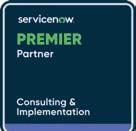

Value as a Service



Changing the conversation to unlocking innovation, releasing hidden value and maximising your return on investment in Oracle SaaS Cloud and ServiceNow



Moving your mission critical business applications to the cloud is only the start. You need a partner that you can trust, who understands your business and will guide you as cloud continues to evolve.

Choose de Novo and together let’s change the conversation
Not satisfied with your existing managed service provider? Or looking for Oracle SaaS Applications and ServiceNow support that goes beyond just raising tickets? Then come talk to de Novo and together let’s change the conversation.

Value your business?
de-Novo-Solutions www.de-novo-solutions.com @deNovoSolutions | #wearedenovo
™ Efficiency
value realisation savings through high end user adoption, ensuring outcomes promised are realised. Adoption
cloud innovation that is relevant for your business, maximising your return on investment. Innovation Optimising your cloud usage by following best practice that promotes differentiation through personalised experiences.
Unlocking
Accessing
Optimisation
Workday Q2 results show “trust” and AI leadership
Workday Q2 2024 financials were released in August, with $1.79bn in total revenues and a clear sentiment of customer trust guiding the company’s messaging to investors.
Total revenues for Q2 2024 showed an increase of 16.3 percent from the second quarter of fiscal 2023. The period for the fiscal 2024 second quarter ended July 31, 2023 also saw operating income of $36.3m, or 2.0 percent of revenues, compared to an operating loss of $34.1m, or negative 2.2 percent of Workday revenues, in the same period last year.
Non-GAAP operating income for Workday Q2 2024 was $421.4m, or 23.6 percent of revenues, compared to a
non-GAAP operating income of $301.6m, or 19.6 percent of revenues in the same period last year.
The CEOs of Workday meanwhile peppered their earnings call messaging with the word “trust”, with customer trust put down as a key explanation for Q2 growth for Workday.
Our customers trust us to manage their people and their money
representing more than 65 million users under contract, are all in on Workday because they trust us to manage their two most important assets: their people and their money,” said co-CEO Carl Eschenbach.

GPT and ethical AI wariness: “More and more organizations are looking to Workday to be their trusted partner to help them navigate today’s business landscape and thrive in this new world of work.
“Our customers, now
Fellow CEO and Workday co-founder Aneel Bhusri elaborated on Workday’s AI prowess in this era of Chat-
“Critical to our ability to be that trusted partner is our continued focus on artificial intelligence and machine learning, including generative AI.”
ORACLE JOINS WHITE HOUSE’S CANCERX PROJECT
Oracle has been recognized as a new founding member of CancerX, an inaugural project in the White House’s national Cancer Moonshot initiative.

Oracle will contribute its background in open cloud platforms, AI and ML, clinical research, healthcare research, care delivery and scientific ex-
pertise from its acquisition of Cerner CancerX is co-hosted
by Moffitt Cancer Center, Digital Medicine Society, the Office for the National Coordinator for Health Information Technology and Office of the Assistant Secretary for Health
The White House’s Cancer Moonshot goal is to reduce the death rate from cancer by at least 50 percent over the next 25 years and improve the
experience of people and their families living with cancer.
Seema Verma, senior vice president and general manager, Oracle Life Sciences, said: “We are proud to bring our expertise in healthcare, clinical research and enterprise cloud technology to deliver more innovative and effective treatments to those fighting cancer.”
12 ERP TODAY | UK / EMEA | Q3 2023 NEWS DEALS &WINS
Carl Eschenbach (left) and Aneel Bhusri (right)
Marc Benio
Salesforce and Deloitte call out for eco-solutions


As members of the First Movers Coalition (FMC), Salesforce and Deloitte have launched the Sustainable Aviation Challenge (SAC), calling for “ecopreneurs” to generate innovative solutions to support the decarbonization of the aviation sector.
An example of these solutions is sustainable aviation fuel, a fuel made from renewable resources, organic materials or waste feedstocks which is designed to reduce emissions.
The SAC is also encouraging innovations that reach beyond fuel alternatives, such
as hydrogen and batteries, and innovations in feedstock, engineering and physical and market infrastructure.
The challenge is hosted on UpLink and solution proposals for the challenge will be accepted from August 24 to October 2, 2023.
TO MEET OUR CLIMATE GOALS, WE MUST BRING DISRUPTIVE CLEAN TECHNOLOGIES TO MARKET AT SCALE
Suzanne DiBianca, EVP and chief impact officer, Salesforce, said: “To meet our climate goals, we must bring disruptive clean technologies to market at scale. Together with our partners, Salesforce thoughtfully approached ideas from ecopreneurs who aim to help decarbonize the aviation industry.”

Accenture Q3 revenue grows but forecast dips
Accenture has reported its financial results for the third quarter of fiscal 2023 with revenues of $16.6bn, matching estimates amid reduced spend in an uncertain economic outlook.
It marks a dip in the company’s growth from last year’s Q3 results, where revenue increased 22 percent, following Q2’s announcement that Accenture is streamlining
HPE AND AWS PARTNER ON WORKLOADS AND UNLOCK AI CLOUD MARKET
HPE has expanded its partnership with AWS to simplify how enterprises develop and manage applications and workloads across HPE GreenLake and AWS. HPE also announced it’s entered the AI cloud market, offering LLMs for any enterprise to access on-demand in a multitenant supercomputing cloud service.
Antonio Neri, CEO and president at HPE said: “HPE is making AI, once the domain of wellfunded government labs and the global cloud giants, accessible to all by delivering a range of AI applications.”
Julie Sweet
operations and reducing costs.
Q3 performance saw the vast majority of its industry groups increase in revenue with financial services revenue being $3.1bn.
visit us ERP.TODAY 13
NEWS DEALS &WINS
Scott Brown
Cognizant and ServiceNow collaborate to drive AI automation
Cognizant and ServiceNow have collaborated to advance the adoption of AI-driven automation, in hopes of building a combined $1bn business.

Certinia update provides “pragmatic AI”
Certinia’s summer 2023 product release came with new AI capabilities, aiming to streamline resource management and enhance productivity for accounting teams.
The August release incorporates what the company calls “pragmatic AI”, which reduces the risk of investing in AI by providing curated datasets, closed-loop models and recommendations to improve model accuracy.
The latest enhancements combine Salesforce’s Einstein Discovery ML models with a platform that ingests financial and operational data, for enhanced cash flow forecasting, planning, staffing and decision-making.
One of the new features, called Project Overview, further reduces administrative work and enables more accurate revenue forecasting. The Scheduling Risk Dashboard feature identifies potential risks to
upcoming scheduled work and takes timely precautionary measures to uphold margins.
Additionally, teams can now analyze and control spending by category and supplier, enforce spending limits for vendor contracts, receive renewal reminders for subscription licenses, automatically create renewals and also automate cost recognition based on company rules.
Dan Brown, chief product and strategy officer, Certinia, said: “We’ve had AI capabilities such as autoregressions and optimizations for a while, but with the summer release we’re introducing a different set that is more about how you take the data in your Salesforce system, bring it into Einstein Discovery and then bring it back to your application.
“This provides greater visibility into how you use AI as opposed to it being a black box.”
Guiding joint clients through the deployment of AI, the new Cognizant ServiceNow Business Group will integrate the Now Platform and ServiceNow’s industry product solutions with Cognizant’s domain expertise and IP. This will provide clients with an enriched operational effectiveness, to aid in business stability and enhance experience with the Cognizant Neuro suite of AI-led platforms.
Bill McDermott, chairman and CEO, ServiceNow, said: “We will accelerate automation to solve our customers’ toughest challenges. This means organizations in every industry [...] can keep pace in this everchanging environment.”
Ravi Kumar S, CEO, Cognizant, said: “[We’re] well-positioned to address these challenges through the combination of our deep industry expertise, enterprise AI solutions and ServiceNow’s powerful platform, delivering innovative, cost-effective solutions.”
Bill McDermott

14 ERP TODAY | UK / EMEA | Q3 2023
THERE’S VISIBILITY INTO HOW YOU USE AI AS OPPOSED TO IT BEING A BLACK BOX.
Oracle enhances HR productivity, launches EU Sovereign Cloud
Oracle has announced the addition of generative AI-powered capabilities within its Oracle Fusion Cloud Human Capital Management (HCM) to improve existing HR processes and drive faster business value, improve productivity and enhance the candidate and employee experience.
Supported by the Oracle Cloud Infrastructure, the generative AI service enables built-in prompts to help customers receive optimal results while reducing undesirable effects such as factual errors and bias.

As part of another initiative, Oracle also announced
the opening of its new EU Sovereign Cloud, aimed at helping private and public sector organizations across the European Union gain more control over data privacy and sovereignty requirements.
Located entirely within the EU, Oracle EU Sovereign Cloud is supported by EUbased personnel and operated by separate legal entities incorporated within the EU.
As part of Oracle Cloud Infrastructure’s distributed cloud strategy, the solution offers Oracle Cloud Infrastructure services and capabilities at the same
service level agreements, prices and support as Oracle’s commercial public cloud regions.
In another development from Q2, Oracle NetSuite unveiled NetSuite Guided Learning to help customers maximize the value of the suite and accelerate adoption.
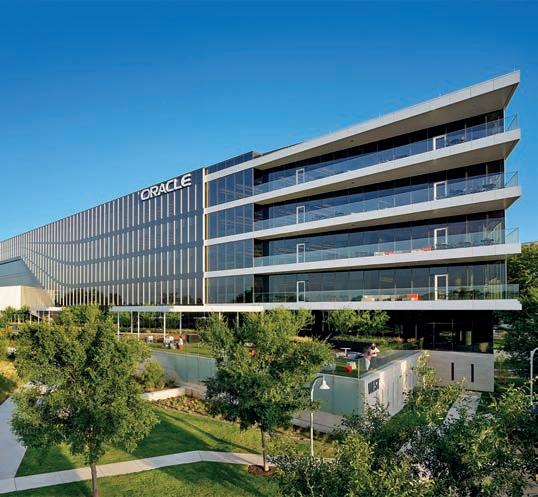
NetSuite Guided Learn-
ing offers step-by-step guidance embedded in NetSuite to help educate users about system functionality and features. This guide will be available to all NetSuite licensed users at no additional cost with the goal of helping businesses leverage the full capabilities of the suite and reduce time spent on training.
Deloitte enhances cybersecurity solution, partners with WEF
Deloitte has expanded its Managed Extended Detection and Response (MXDR) cybersecurity solution to help support some of the unique challenges for enterprise, cloud and operational technology.
MXDR by Deloitte now includes enhanced prevention, detection and response for identity measures. Working closely with the CrowdStrike Falcon platform and CrowdStrike’s Identity Protection modules, the firm has operationalized the ability to prevent, detect and automatically respond to attacks earlier in the kill chain.
In a similar development, Deloitte is collaborating with the World Economic Forum as the partners released actionable guidance with its Quantum Readiness Toolkit to help protect organizations during the rapid development of quantum computing technologies. The guidance helps prevent the advancements in quantum computing from having adverse cybersecurity risk, through increased breaches of sensitive health and financial personal data, compromised private communications or forged digital information and identities.
visit us ERP.TODAY 15
The generative AI service enables built-in prompts to help customers receive optimal results
NEWS DEALS &WINS
ORACLE SECURES THE CLOUD FOR DOD

Oracle Cloud Infrastructure (OCI) has introduced a new secure cloud computing architecture (SCCA) for the US Department of Defense (DoD).
The solution helps to ease security compliance and cloud adoption for mission-critical workloads by using a framework of cloud native services.
Oracle Cloud Native SCCA Landing Zone provides a framework for securely running DoD mission workloads and storing Impact Level 2, 4 and 5 data in OCI government regions. The automation provided by the solution uses cloud native infrastructure services, significantly accelerating the time to deployment of mission critical
CELONIS NAMES CARSTEN THOMA AS PRESIDENT
workloads by reducing architecture time and minimizing decision points.
The solution includes baseline configurations, rules and templates that meet DISA Impact Level two, four and five accreditation requirements, delivered using a standardized Infrastructure-as-Code template that meets a set of SCCA controls in a simplified and repeatable way. Customers can launch the templates from the Cloud Native SCCA Landing Zone, answer a few questions about configuration and have an architecture set up on the same day.
The solutions address
the four primary technical components of the SCCA framework; Cloud Access Point, Virtual Data Center Security Stack, Virtual Data Center Management Service and Trusted Cloud Credential Manager.
Rand Waldron, vice president, OCI global government sector, said: “We still deliver all the
capabilities necessary for SCCA completely in native OCI services. Our customers will no longer have to manage multiple licenses, multiple vendor relationships or multiple kinds of security configurations. [lt] will provide everything the customer needs to stand up an SCCA-compliant workload in the cloud.”
OpenAI launches ChatGPT Enterprise
Process mining leader Celonis has appointed Carsten Thoma as its new president.
Prior to his appointment, Thoma co-founded Hybris in 1997, which is renowned as the first company to solve the complexity of B2B and B2C omni-channel e-commerce.

Thoma commented: “I am passionate about creating a strong, purposeful product and culture and I look forward to working with [...] all Celonauts to enable our customers to reap the unprecedented value, cash impact and sustainable operations that Celonis delivers.”
OpenAI has launched ChatGPT Enterprise, a security and privacy version of its AI chatbot with unlimited higher-speed GPT-4 access, longer context windows, advanced data analysis capabilities, customization options and more.

With the new and improved AI assistant, organizations can gain assistance with tasks whilst also ensuring data
remains secure, which has long been a sticking point for many enterprises when it comes to the “open” nature of ChatGPT.
Early adopters of the tool include Canva and PwC
16 ERP TODAY | UK / EMEA | Q3 2023
Carsten Thoma












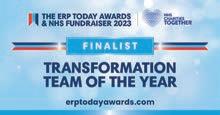



ServiceNow revealed its Q2 results for 2023 alongside a bolstering of its AI credentials through AI Lighthouse, in a partnership with chip powerhouse NVIDIA. The company also laid out its vision for AI to lift people out of “soul-crushing work”, whilst admitting to prudence with regards to all things GenAI.
NOW announced total revenues of $2.15m in Q2 2023, representing 23 percent year-on-year growth. In the words of ServiceNow CFO Gina Mastantuono, the results “exceeded the high end of our guidance range for all of our key performance metrics”.
Alongside the results news was a scaling up of ServiceNow’s GenAI capabilities with case summarization and text-to-code. The company also expanded its existing relations with KPMG, building on its recently announced AI-powered Finance and Supply Chain Workflows.
The biggest announcement was an expansion of ServiceNow’s NVIDIA
partnership. The result, AI Lighthouse, is billed (pardon the pun) as “a first-of-its-kind program designed to fast-track the development and adoption of enterprise generative AI capabilities”.
Powering the service is the ServiceNow enterprise automation platform and engine, NVIDIA AI supercomputing and software plus Accenture AI transformation services. The vision is to let customers collaborate as design partners in architecting custom GenAI large language models (LLMs) and applications to advance their businesses.
In the ServiceNow earnings call, chairman and CEO Bill McDermott commented: “We have become the intelligent enterprise for digital transformation, and we’re lifting people out of soul-crushing work and modernizing these companies with a 21st century platform that’s resonating.
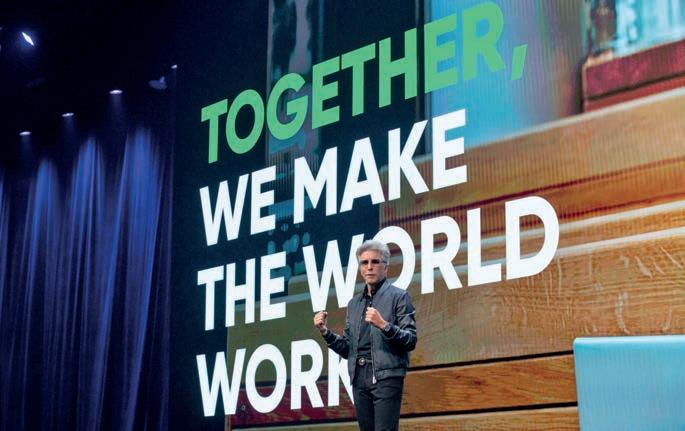
“You combine that with LLMs, the combination of NVIDIA and others, I really think this is a once-in-a-generation moment.”
AWS’ Q2 GROWTH BEATS EXPECTATIONS
Amazon’s Q2 results showed revenue from AWS rose by 12 percent YoY, with total AWS revenue reaching $22.1bn, beating the $21.79bn forecast. Out of the e-commerce giant’s $7.7bn operating profit recorded in the quarter, 70 percent was generated by AWS.
Andy Jassy, CEO of Amazon, said: “Our AWS growth stabilized as customers started shifting from cost optimization to new workload deployment, and AWS has continued to add to its meaningful leadership position in the cloud with a slew of generative AI releases.”
TELE2 DIALS INTO IFS CLOUD

Tele2, a Swedish integrated telecommunications services provider, is implementing the latest version of IFS Cloud to boost its core operations and enhance its 5G offering.
IFS Cloud will work to simplify processes across Tele2’s operations, working to drive continuous automation. The solution provides Tele2 with a single operational view, giving the company more control over its business processes.
In addition to this, Tele2 has also purchased IFS Success to aid its business transformation.
18 ERP TODAY | UK / EMEA | Q3 2023
ServiceNow an AI “lighthouse” shining bright in Q2 results
“WE’RE LIFTING PEOPLE OUT OF SOULCRUSHING WORK, MODERNIZING COMPANIES WITH OUR PLATFORM”
NEWS
Bill McDermott
DEALS &WINS
Automation Anywhere steps up GenAI o ering with Google Cloud
Automation Anywhere and Google Cloud are expanding their partnership to accelerate the adoption of AI in enterprises.

Automation Anywhere will use Google
Cloud’s ML platform Vertex AI, meaning automation builders can use natural language to describe what they need.
Users can extract data from documents like contracts, resumes, waybills and more, and virtual or human support center representatives can respond to customer issues and automatically generate personalized email responses.
AI-driven automation can be used to summarize all loan application information to optimize close cycle times. This improves accuracy, reduces risk, improves customer experiences and results in higher employee satisfaction.
Bruno Heese, managing director, Partners and Channels, Google Cloud EMEA said: “Partnering with Automation Anywhere will strengthen the Generative AI offering by accelerating its technology prowess through the speed of automation, transforming crucial business areas such as customer engagement, employee productivity, app development, etc.”
SALESFORCE APPOINTS A NEW PRESIDENT AND CHIEF LEGAL OFFICER
Salesforce has appointed Sabastian Niles as president and chief legal officer.
He joins from Wachtell, Lipton, Rosen & Katz, and is one of the highest-ranked attorneys in the USA.
He is also a founder of Harvard Association of Law and Business and a director of non-profit organization Literacy Partners
Marc Benioff, chair and CEO of Salesforce, said: “I’m thrilled to welcome Sabastian to Salesforce […] He’s a phenomenal executive and individual and brings a wealth of knowledge, leadership and expertise.”
MICROSOFT’S Q4 EARNINGS BEAT EXPECTATIONS WITH AI

Microsoft’s financial results for Q4 2023 beat analyst expectations with $56.2bn in revenue as the tech giant leans into its AI bet.
Microsoft saw its valuations for the quarter ending June 30, 2023 grow with rapid investments in AI-powered technology.
Satya Nadella, chairman and chief executive officer of Microsoft, said during the results call: “Every customer I
speak with is asking not only how, but how fast they can apply nextgeneration AI to address
the biggest opportunities and challenges they face – and to do so safely and responsibly.”
However, Microsoft’s earnings showed slowing revenue growth for its cloud service Azure as revenue from it only grew 26 percent in the quarter compared with 27 percent in the previous quarter.
Nadella laid out Microsoft’s key priorities for the near future: helping customers use Microsoft Cloud to get the most value out of it, investing to lead in the new AI platform shift and driving operating leverage.
visit us ERP.TODAY 19
xxxx
Satya Nadella
Microsoft expands AI collabs with KPMG, Bing and Capgemini
SAP FIONEER LAUNCHES ITS NEW SOLUTION: SME BANKING EDITION
SAP Fioneer has announced the launch of its SME Banking Edition to enable banks and neobanks to access financial services. It will use a digital-first and data-driven approach, tailored to the financial needs of small and mediumsized enterprises (SMEs).

The solution will connect banks to external data sources and aims to give SMEs transparency for cash flow and provide insight to banks and enable smart funding options.
It covers front-to-back capabilities and enables banks to offer services that go beyond traditional banking products such as loans and deposits. Banks will be able to broaden their offering with embedded services and stronger financial advice directly for SMEs.
KPMG and Microsoft have announced a significant expansion of their relationship to revitalize professional services across businesses, including workforce modernization, safe and secure deployment and use of AI solutions for clients, industries and society.
This collaboration includes a KPMG multibillion-dollar commitment in Microsoft cloud and AI services over the next five years.
Microsoft also announced the expansion of Bing with Chat Enterprise as part of a series of AI announce-
ments made at its Microsoft Inspire event.
Redmond is significantly enhancing Bing to reach new audiences with Bing Chat Enterprise, delivering AIpowered chat for work. According to the firm, with Bing Chat Enterprise, user and business data will be protected and not leak outside the organization.

Similarly, Microsoft has also announced the launch of Azure Intelligent App Factory with Capgemini, which aims to empower organizations to scale responsible and sustainable generative AI capabilities for their business at speed.
Dirk Kruse, CEO of SAP Fioneer, said: “The introduction of our Fioneer SME Banking Edition significantly strengthens how banks interact with SMEs. Utilizing our proven technology, we’re facilitating banks to better serve SMEs in a dynamic economic landscape. Drawing inspiration from the B2C market, we’re empowering banks to elevate their service offerings for SMEs.”
Google Cloud hails profitable second quarter for Alphabet
Google Cloud has made profit for two quarters in a row, Q2 2023 results from parent company Alphabet revealed.

Its total revenue reached $8.03bn, its highest profit yet, at an increase of 27.96 percent year-on-year. But it still bears mentioning that Google Cloud’s profit represented only 10.8 percent of Alphabet’s total revenue.
“Turning to Google Cloud, we are particularly excited about the customer interest in our AI-optimized infrastructure […] and our new generative AI offerings,” Ruth Porat, Alphabet CFO, said.
20 ERP TODAY | UK / EMEA | Q3 2023
NEWS DEALS &WINS
Unit4 FP&A runs the numbers so















you can run the business
Our Financial Planning and Analysis solution unifies data and uses smart automation and AI-backed workflows to help you forecast more accurately, model more e ciently, and navigate uncertainty with confidence. Free up time spent crunching data, and spend more time providing strategic and operational guidance to improve decision making.


Learn more at unit4.com

AJ Foyt Racing Selects IFS to drive home wins

American racing team, AJ Foyt Racing, has selected IFS as its strategic technology partner for the 2023, 2024 and 2025 IndyCar Racing seasons.
AJ Foyt Racing will leverage IFS Ultimo for parts management, parts lifing and maintenance. This will provide capabilities for work order management, multi-locations inventory management and purchase control and management. Leveraging IFS Ultimo EAM, the team will have an
automated central input source, enabling real-time updates that monitor the chassis mileage and all car parts at any time. The IFS logo will feature on the team’s No. 14 and No. 55 Indy cars in all races and showcases during the NTT INDYCAR Series seasons.
Oliver Pilgerstorfer, chief marketing officer, IFS, said: “With such a pedigree and history of talent in the American racing circuit, we are thrilled to be a strategic technology partner of AJ Foyt Racing.”
Larry Foyt, president, AJ Foyt Enterprises, said: “When evaluating our options, IFS Ultimo’s EAM solution stood out for its flexibility and out-ofthe-box functionality.”
IBM Q2 RESULTS TOP EARNING ESTIMATES WITH RED HAT WINS

IBM has released its second quarter results with earnings reaching $2.18 per share, which exceeded analysts’ $2.01 per share estimate, according to financial data business Refinitiv
At the same time, overall revenue missed the mark by slipping down 0.4 percent to $15.5bn, up 0.4 percent at constant currency, despite Refinitiv projections of $15.6bn.
Arvind Krishna, IBM’s chairman and CEO, singled out subsidiary Red Hat’s revenue increase of 11 percent in the Q2 earnings call.
PwC joins the AI trend with ChatPwC bot
PwC is piloting its new GenAI tool, ChatPwC, as part of its focus on leveling up its AI capabilities and offerings. The tool will act as a conversational AI assistant for employees. Offering secure and private domain access to OpenAI’s tech, the model has been propagated with data covering common tax questions and regulations.
PwC’s objective is to grant all of its 75,000 US employees access to the GenAI tool, before rolling it out for use globally. The company wanted to treat itself as client zero and took a hands-on approach to fine-tuning tools, frameworks and training programs.

Scott Likens, global AI lead and US innovation technology lead, PwC
said: “[This] is our interface to leveraging the large language model from OpenAI and…others as needed.
“To do that, we had to make it valuable to the work we do every day…bringing in some of our own [intellectual property]. We feel passionately about this being additive, not replacing what our people do.”
22 ERP TODAY | UK / EMEA | Q3 2023
NEWS DEALS &WINS
Workday intros next-gen Elastic Hypercube Technology
Workday has debuted the next generation of its Elastic Hypercube Technology (EHT). The intelligent modeling engine that powers Workday Adaptive Planning now aims to address the growing demands on organizations as they model more complex business scenarios and expand planning to more users.

The next-gen EHT comes enhanced with new embedded AI and performance improvements that efficiently calculate complex models by elastically adding memory and compute power as needed, resulting in dynamic, automatic scaling. The new technology is designed to support even the most complex multi-dimensional planning requirements, without sacrificing speed or performance.
Workday Adaptive Planning customers are expected to see benefits with optimized speed and
performance, higher user concurrency support and accelerated data integration. With Workday Adaptive Planning, technical innovations and embedded AI have helped organizations, notably Boeing, to transform their workforce planning from a siloed process to a flexible and scalable solution. By storing all its workforce data in one system, Boeing has been able to standardize processes and increase visibility into open job requisitions, driving cost savings, it is claimed.
Jeremy McCann, manager of enterprise workforce
planning, Boeing, said: “We transitioned from hundreds of manual spreadsheets in favor of a more flexible configuration on Workday Adaptive Planning, effectively eliminating our reliance on datasets that were disconnected from each other.”
Dennis Yen, general manager of Adaptive Planning for Workday, said: “With our continued EHT innovations – including adding to the solution’s existing AI and ML functionality – Workday Adaptive Planning is helping more than 6,000 companies take control and plan proactively for their futures.”
RED HAT DIALS INTO NOKIA

Nokia and Red Hat have collaborated to integrate Nokia’s core network applications with Red Hat OpenStack Platform and Red Hat OpenShift. Nokia and Red Hat will support and evolve Nokia NCS and CBIS customers with a plan to migrate to Red Hat’s platform over time.
Darrell JordanSmith, senior VP, telecommunications, media and entertainment and edge, Red Hat, said: “Nokia is offering our [...] infrastructure together with their core networks applications to capitalize on the 5G opportunity.”
Slow SUSE Q3 results amidst suite and status reshuffle
SUSE has announced its financial results for Q3 2023, revealing slow growth with revenue reported at $173m, a 2 percent year-on-year growth.

On August 17, post quarter end, SUSE announced that its majority shareholder, EQT Private Equity, has taken the company private
following a merger into an unlisted Luxembourg entity, two years after going public. CEO Dirk-Peter van Leeuwen told ERP Today that the return into private hands offers a “strategic opportunity” for the firm to develop under its newly installed leadership team.
visit us ERP.TODAY 23
NEWS DEALS &WINS
IFS RESULTS SHOW SUSTAINED GROWTH DRIVEN BY CLOUD DEMAND
IFS has announced its financial results for the first half (H1) of 2023, demonstrating robust forward performance with both cloud and annual recurring revenues up 55 percent year-on-year at constant currency.

The firm’s combined financial results for the first two quarters, ending June 30, saw its total revenue reach €493m, an increase of 38 percent from H1 2022.
Leading with its ERP, enterprise asset management, field service management and enterprise
service management developments, IFS’s software revenue reached €392m, a 44 percent increase from last year, with recurring revenue also up 49 percent YoY to €373m.
IFS said in a press release that despite the continued challenges posed by high inflation and monetary policy tightening, companies are continuing to invest in technology and so its roadmap remains firmly aligned to technology trends that accelerate intelligent insights, automation plus people and asset optimization.
Following a sharp rise in AI demand from both new and existing customers, the company is also en route to accelerate the delivery of AI technologies throughout its automation, prediction and optimization capabilities.
Darren Roos, CEO of IFS, said: “We already provide a significant amount of AI natively in our products across scheduling optimization, predictions and intelligent insights capabilities, and as companies
continue to invest in technology, despite economic challenges, our AI capabilities are proving a crucial differentiator.”
IFS CFO, Matthias Heiden, added: “The ongoing macroeconomic challenges mean companies are thinking carefully about their technology investments and focus on what will help build business resilience. We see this reflected in the number of customers moving to IFS Cloud.”
Workday has appointed Emma Chalwin as chief marketing officer. In her new role, Chalwin will oversee
the global marketing organization, with responsibility for building the brand and driving customer demand in markets around the
globe. She previously held leadership positions at Salesforce, Macrovision, McAfee and Adobe Carl Eschenbach, co-CEO, Workday said:
“Emma brings deep expertise across all facets of marketing and has the vision and background to help us achieve our next stage of growth.”
24 ERP TODAY | UK / EMEA | Q3 2023
“IFS PROVIDES A SIGNIFICANT AMOUNT OF AI NATIVELY”
Workday appoints former Salesforce EVP Emma Chalwin as CMO
Accenture to invest $3bn in AI, partners with Bira 91
Accenture has announced plans to invest $3bn into AI over three years.

The massive expansion of its Data and AI practice will double the company’s AI talent to 80,000 people in an effort to help its businesses across all industries to rapidly and responsibly use AI to achieve greater growth, efficiency and resilience.
Paul Daugherty, group chief executive at Accenture, discussed the decision to invest in data and AI, saying: “Over the next decade, AI will be a megatrend, transforming industries, companies and the way we live and work, as generative AI transforms 40 percent of all working hours.”
Accenture plans to launch AI Navigator for Enterprise, a generative AI-based platform that will help clients define business cases, make decisions, navigate AI journeys, choose architectures and understand algorithms and models in order to drive value. The platform will include assets designed to accelerate respon-
sible AI practices and compliance programs.
A partner on this journey for Accenture is Google Cloud, with the two extending their partnership to co-develop new solutions leveraging Accenture’s industry and functional experience and Google Cloud’s suite of GenAI technologies.
Accenture also recently announced a collaboration with Bira 91, an Indian beer company that spans 24 countries, to support its enterprise reinvention program aimed at driving growth, increasing business agility and accelerating innovation.
As part of the enterprise reinvention program, Accenture will help Bira 91 design and deploy a new digital core, which includes enhancements of data, AI and machine learning.
Leveraging SAP’s S/4HANA platform, Bira 91 will drive a total renovation of its enterprise systems through the integration of different technology platforms.
GOOGLE CLOUD AND MACQUARIE JOIN TO BRING AI TO ONLINE BANKING
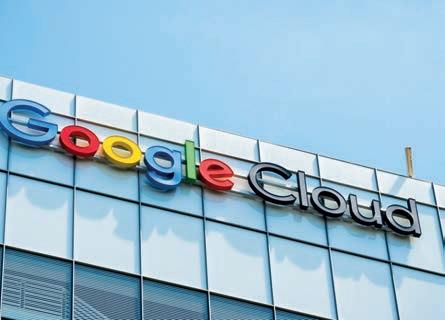
Macquarie Group and Google Cloud have partnered to announce new AI and ML capabilities to drive improved banking experiences for customers.
Google Cloud underpins Macquarie’s digital customer interfaces and processes, and the bank now analyzes more than one billion transactions daily to bring intuitive functionality to its customers. The new AI and ML capabilities will see Macquarie launch this further, such as with a cash flow prediction feature that aims to provide customers with a forecast of their personalized cashflow for the next 12 months.
They will also work together to embed AI and ML functionality across risk management processes, customer service functions - such as with “smart agent” capabilities - and enhanced insights for customers traveling abroad.
Zac Maufe, head of regulated industries, Google Cloud said: “By combining Macquarie’s expertise in financial services with Google Cloud’s AI and machine learning capabilities, we can create new and innovative ways to help their customers manage their money and invest for the future.”
visit us ERP.TODAY 25
“OVER THE NEXT DECADE, AI WILL BE A MEGA-TREND, TRANSFORMING INDUSTRIES, COMPANIES AND HOW WE LIVE AND WORK”
Deloitte and Google Cloud launch green initiative
Deloitte and Google Cloud have launched a sustainability initiative to help clients mitigate climate risks, adopt green solutions and unlock the value of low-carbon products and services.

Deloitte has also been recognized as the first global systems integrator with the Google Cloud Ready Sustainability designation. As part of the program, Deloitte is harnessing the power of its industry and domain knowledge combined with Google Cloud’s technology and platforms, to help organizations transition to a sustainable future.
Both companies are leveraging Google Earth Engine and their ecosystem relationships to support financial services companies around the world in using geospatial analytics to improve visibility and access insights to climate risks across
lending and investment portfolios. Moving forward, the sustainability initiative will help clients tackle major challenges. These include transitioning to zero emission energy sources, tapping into sustainable capital markets, scaling sustainable products and services, accelerating regenerative agriculture, decarbonizing digital business models and building sustainable and equitable communities.
Jamie Sawchuk, partner and global sustainability leader for the Alphabet Google alliance, Deloitte Canada, said: “We are excited to be working with Google to take purposeful action to help mitigate climate risks, unlock the value of sustainable products and services, build green communities and green jobs and accelerate our progress toward a global net-zero future.”
IBM ACQUIRES APPTIO FOR $5BN
IBM has acquired software company Apptio for approximately $5bn.
Apptio offers a cloud-based platform providing insights to empower digital leaders to make data-driven decisions and realize value.
The deal reflects IBM’s new transformation efforts, focusing on hybrid cloud and AI. Big Blue’s new direction is shown in recent partnerships such as with Wimbledon, offering AIgenerated commentary and captions in its highlights videos.
TRUIST FINANCIAL CORP BANKS IBM QUANTUM ACCELERATOR PROGRAM
Truist Financial Corp will join the IBM Quantum Accelerator program, helping to focus Truist’s internal expertise in quantum computing with the goal of achieving a quantum-ready state. Truist Financial will gain access to IBM’s quantum computing systems, deep expertise and enablement resources.
Scott Case, CIO at Truist said: “IBM is a leader in quantum computing and their collaboration and expertise will be invaluable to ensure we are able to leverage these new technologies to the fullest potential.”

26 ERP TODAY | UK / EMEA | Q3 2023
NEWS DEALS &WINS
WE ARE EXCITED TO BE WORKING WITH GOOGLE TO HELP MITIGATE CLIMATE RISKS
IFS SNATCHES UP POKA, QUEBECBASED WORKER PLATFORM PROVIDER


IFS has acquired Poka, the Quebec-based connected worker platform.
Poka spans 55 countries with clients such as Nestlé , Tetra Pak , Mars , Bosch , Rio Tinto , Coty , Alcoa , Hitachi Energy , Mahle and more.
To address business challenges affecting complexity, uncertainty in labor availability and impacted supply chains, Poka is focusing on achieving a faster digital transformation. Poka also provides insights for companies to stay



compliant and provide safer working conditions as part of their ESG goals.
Alexandre Leclerc, CEO of Poka, said: “We are incredibly proud of the best-in-class platform we’ve built and our pioneering leadership in the Connected Worker space. Becoming part of IFS will enable us to further innovate and extend the value we create for manufacturers.


“As the global workforce crisis deepens, more companies are looking to scale their digital factory projects across the enterprise. With the help of IFS’s global presence and industry experience, Poka will be better equipped to deliver on its mission at scale.”
UiPath unlocks AI capabilities with new automation o erings
Announced at TOGETHER London 2023, UiPath has unveiled its latest AI-powered automation features that accelerate customers’ abilities through generative and specialized AI.
According to a recent report by McKinsey on the economic impact of generative AI, the tech has increased the total percentage of hours that could be automated by integrating technologies that exist today from 50 percent to 60-70 percent.
The UiPath Business Automation Platform is adding more AI offerings, including the general availability of
OpenAI and Azure OpenAI connectors with support for GPT-4. UiPath customers can use the OpenAI connector to extend automation deeper into business operations and turn data into actionable insights.
UiPath has also announced its support for Falcon LLM via its Amazon SageMaker connector, and the preview of the Google Vertex connector with support for PaLM 2.
In addition to these new features, the company has announced the preview of Clipboard AI for finance teams, which is an offering that uses UiPath AI Computer Vision and gen-
erative AI to transfer data between documents, apps and spreadsheets, allowing users to manage invoicing efficiently across multiple finance platforms.
Graham Sheldon, chief
product officer at UiPath, said: “AI technologies are at the core of the UiPath Business Automation Platform and we are excited to extend the capabilities of our enterprise automation with new generative AI and specialized AI offerings.”
Aaron Phillips, manager of intelligent automation at Reveal Group, said: “Using the UiPath OpenAI connector, we can leverage GPT models to prewrite responses to customer inquiries, or for summarizing and distilling longer documents into key points. This is an asset when faced with character limits or size constraints.”

visit us ERP.TODAY 27
From left to right, Antoine Bisson, CTO, Louis-Philippe Benoit, CFO, and Alexandre Leclerc, CEO
Daniel Dines
NEWS DEALS &WINS
SALESFORCE INVESTS $4BN IN GENAI AMIDST CUSTOMER QUALMS

At its World Tour London event, Salesforce pledged to invest $4bn in its UK business over five years, focusing on AI innovation. As part of this venture, the CRM giant announced the addition of generative AI capabilities, Sales GPT and Service GPT, enabling teams to close deals faster, anticipate customer needs and bolster productivity.
Sales GPT and Service GPT will embed generative AI into Salesforce’s existing cloud services to help with tasks and auto-generate
customer emails, call summaries and account research to elevate the experience of sellers and service teams interacting with customers. Service GPT will also auto-generate service replies and automatically summarize customer interactions into easy-to-access articles for service teams.
Amidst the launch news, Salesforce acknowledged its customers’ distrust of generative AI, citing that 73 percent of employees perceived generative AI as introducing
new security risks. To combat these security concerns, Salesforce announced its collaboration with Deloitte Digital, to harness its AI services, industry experience and knowledge of data protection regulations to help organizations implement its AI Cloud service securely.
Zahra Bahrololoumi CBE, CEO UKI, Salesforce, joked in her World Tour keynote: “When we talk about privacy, hallucinations, data control, bias and toxicity, I’m not talking about a

night out in London!”
“For so many leaders… [AI] is the number one priority,” Bahrololoumi continued. “But your customers are not so eager. That’s because less than half of them trust companies with their data.
“We want to help you harness this technology with trust… We have brought AI into every app, every layer of our platform, every single workflow - and all with trust and security and privacy and scale and ethics at its core.”
Infor Marketplace showcases new AI-driven solutions
Infor reported the continued momentum of Infor Marketplace, now showcasing more than 150 solutions.

Several new partner solutions are included, enabling users the capabilities of Infor’s M3 and LN ERP systems serving the manufacturing, distribution and services industries. New Infor solutions leveraging Infor OS, Coleman AI and ChatGPT will help enhance the user experience with Infor CloudSuite
solutions. These solutions include partner-developed applications that extend the functionality of Infor ERP systems and content,
leveraging the company’s platform technology alongside OpenAI’s ChatGPT. Notable is the addition of the Ask ChatGPT
Widget, a tool that combines the capabilities of ChatGPT with the business context information in the Infor cloud, to help customers ask specific questions of the chatbot.
Massimo Capoccia, chief innovation officer, Infor, said: “This expanding enterprise software ecosystem provides users with the convenience, flexibility and confidence to deploy solutions that make their businesses more successful.”
28 ERP TODAY | UK / EMEA | Q3 2023
Zahra Bahrololoumi
Harrods adopts a new holistic 360-degree view of the customer to increase engagement, retention, and spend

















The world’s leading luxury department store, Harrods, has completed an ambitious 18-month project, led by KPS, to elevate customer experiences by streamlining their journeys both online and offline.
Discover how Harrods

Achieved the Golden Record








NHS develops and runs with Microsoft its rst cloud-based AI

Addenbrooke’s Hospital in Cambridge has collaborated with Microsoft to leverage its AI capabilities for planning radiotherapy treatments faster and more efficiently.
Developed by and for the NHS, the new AI system, named OSAIRIS, aims to transform the preparation of scans to reduce the time patients at the hospital wait between referral and treatment initiation. OSAIRIS aims to reduce the labor-intensive process of manually outlining healthy organs on scans prior to radiotherapy, known as segmentation. Precise segmentation is critical to protect the healthy tissue around the cancer from radiation, taking a doctor anywhere between 20 minutes to three hours to perform this task, per patient.
OSAIRIS streamlines the process, freeing oncologists to focus on treatment planning while AI handles segmentation. The oncologist can then review
each scan, ensuring accuracy and retaining control throughout the entire process.
Dr Raj Jena, an oncologist at CUH who spearheaded the research for the NHS and University of Cambridge, said: “OSAIRIS does much of the work in the background so that when the oncologist sits down to start planning treatment, most of the heavy lifting is done. It is the first cloud-based AI technology to be developed and deployed within the NHS.”
Aditya Nori, general manager of healthcare, Microsoft Research, said: “Healthcare offers the possibility not only to have technical impact but also societal impact, so I am really thrilled about this. The fact that we have AI finally in the NHS also will open the doors for other kinds of AI technologies to really reduce the burden that’s placed on clinicians [and] improve patient safety.”
SUSE UNVEILS NEW CAPABILITIES TO ADDRESS CLOUD SECURITY
SUSE unveiled its latest Linux platform version, SLE 15 SP5, armed with new capabilities to address cloud security concerns.
The company has enhanced its infrastructure security stack to ensure that customers can safely run workloads in the cloud and at the edge, and delivers high-computing for AI and ML workloads.
Dr Thomas Di Giacomo, chief technology and product officer, SUSE, said: “[Enterprises] need to get serious about the security posture of their complex workloads, particularly AI/ML platforms.”
SNP AND SNOWFLAKE LAUNCH DATA STREAMING FOR SAP APP
At the 2023 Snowflake Summit in Las Vegas, SNP and Snowflake launched the Data Streaming for SAP app. This app, built using Snowflake’s App Framework, simplifies the integration of SAP systems and enables companies to quickly merge SAP data while reducing data latency for customers.
Chris Child, senior director of product management, Snowflake, said: “SNP’s Data Streaming for SAP app will make it easier for organizations to integrate and get value from SAP data within their Snowflake accounts.”

30 ERP TODAY | UK / EMEA | Q3 2023
“The fact that we have AI finally in the NHS also will open the doors for other kinds of AI technologies”
NEWS DEALS &WINS

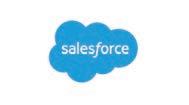





32
2023 33

SPONSORED BY 34
TRANSFORMATION PROJECT OF THE YEAR
BLUE MARINE FOUNDATION


Blue Marine Foundation is a conservation charity dedicated to restoring the oceans and combating climate change by creating marine reserves, tackling overfishing, restoring habitats and developing models of sustainable fishing.

With 85-90 pence in every pound going towards its charitable activities, Blue Marine runs a lean operation. In 2018, the organization had 15 staff members to oversee expenditure on around 20 projects. For its accounting, Blue Marine had used Xero and manual Microsoft Excel reports.
But, by the end of 2021, the number of projects doubled and tracking and reporting funders via Excel became unmanageable. Manual report creation presented six-weekold data and required two people to dedicate two weeks each month. Some budgets were pushed out to inefficient quarterly reporting, while compiling and verifying data for senior management required an extra full week.
Recognizing that a lack of agility was holding back its efforts, Blue Marine conducted a feasibility study and selected Microsoft Dynamics 365 Business Central as its new finance system and City Dynamics as the implementation partner.

From signing on as a new customer in December 2021, the organization was live with Dynamics for its new financial year in April 2022 and Project Budget reporting was implemented into Power BI.
With the new solution in place, Blue Marine has seen automated, interventionless live reporting where the time saved has paid for the whole project in under nine months.

Enabling a continuous accounting model, data now appears in reports within a week of the transaction taking place. By transforming the quality and speed of project information at its disposal, Blue Marine’s project managers can now act decisively when presented with timesensitive conservation opportunities to help restore the world’s oceans.
So, when a diver found an egg case of the critically endangered Flapper Skate off Scotland’s coast, Blue Marine - equipped with real-time financial information – could immediately deploy a team to capture essential video evidence and measurements for site protection.
Within a week, over 100 rare egg cases were documented, instrumental in persuading Marine Scotland to implement a trawling and dredging ban to safeguard the site and support the critically endangered Flapper Skates to hatch in Scottish waters.
Acting as “carbon sinks”, healthy oceans absorb ever-increasing CO2 emissions and play a critical role in combating climate change. With the recent rise in endangered marine life decreasing the ocean’s capacity for carbon sponging, Blue Marine’s success on this project is all the greater.
This effort has highlighted the impact of Blue Marine’s system transformation – enabling the charity not only to benefit from time, quality and cost savings, but showing the profound environmental impact that real-time, quality information can have when it comes to protecting and preserving the world’s oceans in the fight against climate change.
NOMINATED BY CITY DYNAMICS
WINNER
35
Nutreco, an animal nutrition company based in the Netherlands, provides advice and technology to help its customers produce more feed in a sustainable way and cater for the growing population. It has two lines of business; Trouw Nutrition, a global provider of feed specialties and nutritional services for the animal nutrition industry, and Skretting, a manufacturer and supplier of aquaculture feeds.
As a long-time Infor M3 ERP customer, Nutreco started its Unite program in 2011 and consolidated all its operations onto a single on-premise instance of M3, reducing complexity and boosting procurement and operation performance.
But, come 2018, Nutreco sought a modern, global, cloudhosted platform that could more accurately and safely consolidate, contextualize and communicate key information for its 3,600 users. It started the journey to migrate its on-premise M3 instance to the cloud in two phases, first to a single tenant and subsequently to a multi-tenant solution this year.

By 2020, phase one was complete and Nutreco then migrated to Infor CloudSuite Food and Beverage, a multi-tenant solution, based on M3 and powered by AWS
On time and within budget, the project went live in three batches, starting in March 2023, with the final go-live, in May 2023, ready to support thousands of users across more than 100 production plants in 37 countries.
Following a composable ERP strategy, Nutreco has leveraged configuration for its specific business typologies and, for nonstandard processes, best-of-breed solutions or low-code technology have been integrated via Infor ION. Meanwhile, process mining enables Nutreco to monitor implementation effectiveness and tailor training accordingly.
The cloud solution allows Nutreco to generate transparent and automated sustainability reports effortlessly, with all sustainability-related data points in the ERP organized in a multidimensional tagged format.
Migrating to this platform marked the biggest multi-tenant cloud ERP deployment, making Nutreco Infor’s flagship customer.
As the solution is always current, this migration is the last upgrade ever by Nutreco. Since new updates are deployed via Infor’s bi-annual release process, Nutreco can fully focus on innovation and integrating new acquisitions to sustainably feed for the future.
CIVIL NUCLEAR CONSTABULARY


The Civil Nuclear Constabulary (CNC) is the armed police force responsible for protecting nuclear sites and nuclear materials in England and Scotland, whether on-site or in transit, making counter-terrorism a major part of its policing. It is governed by the Civil Nuclear Police Authority, policing each site in line with Nuclear Industry Security Regulations and working closely with local police services, nuclear regulators and the Home Office
Due to the confidential nature of the CNC’s responsibilities, it has no tolerance for mistakes that might be detrimental to front-line services and must maintain the accuracy and security of its data.
In a move to safeguard UK security, the CNC has implemented the Business and People Support System (BPSS), to provide efficient arrangements for securing the deployment, payment and support of its officers and staff.
Namos and Quite Laterally were awarded the BPSS project and undertook the program management and migration of Oracle ERP, EPM and HCM Cloud. The key challenge of this project was “copying” the build from the Multi-Force shared service with an accelerated timeline for implementation. Owing to internal and external pressures, the delivery needed to complete within a tight time frame of seven months.
As data security was an integral part of the project, it was deemed an unnecessary risk to have test environments with real data. Rising to the challenge, Namos developed anonymization routines that, in compliment to Oracle obfuscation, render data untraceable to the source.
This, along with the full raft of Oracle’s military grade security, dedicated data centers and location-based access control, meant that data protection would be assured.
The delivery of its BPSS program was a success and the CNC has now brought its finance, HR and procurement activities back in house. This includes multiple key integrations into payroll, DMS, recruitment and the first delivery of its new EPM Solution.
Duncan Worsell, ex-chief superintendent at the CNC, said: “The implementation of BPSS was the largest, most complex and time-critical non-operational challenge that the constabulary has ever faced. […] As a senior police officer, it is rewarding to discover that beyond public service, in the for-profit world of commerce and contracts, there is still a place for trust.”
NOMINATED BY NAMOS SOLUTIONS & QUITE LATERALLY NUTRECO NOMINATED BY INFOR
HIGHLY COMMENDED COMMENDED TRANSFORMATION PROJECT OF THE YEAR 36
The world works with



ServiceNow. with
























ServiceNow.
More than ever, technology is helping people around the world work together to solve some of our greatest challenges. Look around. Work is actually working.
More than ever, technology is helping people around the world work together to solve some of our greatest challenges. Look around. Work is actually working.
Every day, we help organisations of every size, in every industry, digitally transform the work they do — so it simply works better. Unlocking progress once blocked by barriers. Streamlining ideas once hindered by processes. Making work easier for everyone. It’s why the world’s leading companies rely on us. And it’s how we can help you. There are infinite applications of our solutions to help solve even your toughest business challenges. So let’s go to work. Because when the work flows, the world works.
Every day, we help organisations of every size, in every industry, digitally transform the work they do — so it simply works better. Unlocking progress once blocked by barriers. Streamlining ideas once hindered by processes. Making work easier for everyone. It’s why the world’s leading companies rely on us. And it’s how we can help you. There are infinite applications of our solutions to help solve even your toughest business challenges. So let’s go to work. Because when the work flows, the world works.



That’s why the world works with ServiceNow.
That’s why the world works with ServiceNow.



ServiceNow.com/UK/WorldWorks
ServiceNow.com/UK/WorldWorks


S:285
mm

SPONSORED BY 38
WINNER SAP
We all know the SAP story. Since its establishment in 1972, the ERP vendor has come to dominate the landscape of business process management. Today, with more than 230 million cloud users and a diverse portfolio of over 100 solutions, SAP contributes to 87 percent of the world’s global commerce.
That’s the SAP history, but it pays to read into recent moves. Over the past 12 months, SAP has released several significant production innovations to drive customer success. In November 2022, SAP Build was introduced, a unified low-code offering that extends the power of collaboration and solution creation to non-technical users on the SAP Business Technology Platform.
As part of SAP Build, the company has embarked on an ambitious mission to upskill two million developers worldwide within a span of two years. By empowering developers with the necessary tools and knowledge, SAP aims to create a capable ecosystem that can leverage the potential of its platforms.
In March 2023, SAP debuted its SAP Datasphere. The solution addresses a critical need in the business world for quick and effective data access and is able to integrate various data processes to provide a seamless and unified experience encompassing data integration, cataloging, modeling, warehousing and virtualization.
Among SAP’s other recent innovations, GROW with SAP stands out when it comes to its customer-centric approach. Designed as a cloud ERP offering tailored for midsize businesses, GROW with SAP is built on the

foundation of RISE with SAP with S/4HANA cloud implementations.
This year also saw SAP Sapphire 2023, at which SAP unveiled an offering in its strategic collaboration with Microsoft, AI Built for Business. This integration of AI tools with SAP’s deep industry insights holds the potential to augment decision-making precision and agility across crucial business functions such as procurement, customer engagement and HR management.
SAP’s influence extends beyond product innovation and into customer success, with recent case studies for the likes of Versuni and BT Group. Particularly of interest to judges was its recent transformative partnership with IBM in spearheading a five-year business transformation initiative for global beverage leader Diageo, leading to an overhaul of Diageo’s IT infrastructure and global processes. The result was a boosting of business resilience, customer service and adaptability, and through the implementation of RISE with SAP the brand saw operations standardized across 180 countries.
Customers using RISE with SAP have seen a 5 to 15 percent improvement in sourcing savings on direct spend and, on average, a 15 to 20 percent reduction in their carbon footprint, the latter cementing SAP’s drive to support in the worldwide sustainability mission.
SAP’s story then is a saga of relentless innovation, steering businesses toward new realms of growth and transformation. Through a spectrum of product evolutions and innovative AI integrations, SAP continues to transform business processes on a global scale, making it our vendor for the year.
ERP VENDOR OF THE YEAR 39
WORKDAY INFOR
In today’s rapidly evolving business landscape, staying ahead arguably requires not just innovation, but a strategic approach that caters to specific industry needs. Infor, the industry-specific cloud company, is charging ahead by offering mission-critical enterprise applications that provide sustainable operational advantages and faster time-to-value.
2022 saw Infor celebrate 20 years in the ERP industry and a successful pivot to a cloud SaaS company, with a SaaS run rate of $1.2bn. With a presence in over 175 countries, Infor’s 17,000-strong workforce is dedicated to helping over 60,000 organizations overcome disruptions and achieve their business goals. Looking into the future relies on evolution, and here Infor invests 45 percent of its ERP revenues into research and development.
Infor’s flagship platform, Infor OS, takes a unique approach to cloud services. Unlike traditional cloud offerings, Infor OS provides a comprehensive, industry-specific platform under one license, combining automation, analytics and AI. This integration helps customers to enhance their processes efficiently without the need for the disjointed solutions which often blight the enterprise field.
The company’s focus on a “Time to Value’’ approach ensures that customers can reap the benefits of their solutions quickly and effectively. Amongst those customers is a name synonymous with luxury, Aston Martin, which partnered with Infor to streamline its operations using Infor CloudSuite Automotive. The successful implementation empowered Aston Martin’s operations, enabling the brand to align with the launch of its new DB12 model and optimize its production processes.
Leading Dutch animal nutrition company, Nutreco has meanwhile embarked on a journey to migrate its operations to the cloud. Infor facilitated the seamless transition of Nutreco’s on-premises M3 instance to the cloud. This migration enabled Nutreco to harmonize processes, enhance procurement performance and support the company’s sustainability goals.
Additionally, Infor’s ESG initiatives reflect its dedication to responsible business practices. By leveraging partnerships like that with AWS, Infor maximizes energy efficiency and minimizes waste. The company’s commitment to resource optimization extends to its workforce, with remote support capabilities reducing the need for excessive travel - essential in the face of an ongoing climate crisis.
Founded in 2005, Workday has evolved into a global cloudbased enterprise software company with a wide array of solutions covering financial management, human resources, planning, spend management and analytics. Headquartered in the USA, the company made its mark in the UK in 2011 and continues with a substantial reach across EMEA.
Recognizing that agility is key for vendors, the company’s philosophy centers on creating an environment where employees can develop skills, forge connections and make meaningful contributions. This investment in skills development has been further supported by the Workday Career Hub, a technological tool that encourages employees to leverage their capabilities and acquire new skills.
On the customer side, Workday Extend has emerged as a catalyst for rapid innovation. The number of customers for the app development suite has doubled in the past year, as organizations across various sectors recognized the platform’s potential to drive adaptability. As a result, Workday Extend has given rise to over 500 apps and extensions tailored to unique business needs.
Software wins also include the newly-launched Workday Peakon Employee Voice, the semantic search feature of which marked a significant leap forward in deciphering employee feedback. This cutting-edge application of natural language processing (NLP) and AI allows the system to analyze millions of employee comments, extracting nuanced insights without relying on explicit keywords so leaders can gain immediate and accurate insights into emerging workplace trends.
Customer success stories from the past year bear testament to Workday’s commitment to creating impact. Ofcom, the leading UK regulatory organization, has harnessed Workday Skills Cloud to attract and retain top talent. The platform’s innovative ML capabilities empowered Ofcom to understand and strategize around workforce skills, opening avenues for upskilling and career growth.
NFU Mutual’s digital transformation journey, in addition, came out on top thanks to an “adopt, not adapt” approach. NFU Mutual embraced change beyond surface-level shifts and worked as a partnership, showcasing the collaborative spirit that defines Workday’s approach as a vendor.
HIGHLY COMMENDED COMMENDED ERP VENDOR OF THE YEAR 40
FIND OUT MORE:
DELIGHTED TO SUPPORT THE ERP TODAY AWARDS AND FUNDRAISER IN AID OF NHS CHARITIES TOGETHER
About Capgemini


Capgemini is a global leader in partnering with companies to transform and manage their business by harnessing the power of technology. The Group is guided every day by its purpose of unleashing human energy through technology for an inclusive and sustainable future. It is a responsible and diverse organization of nearly 350,000 team members in more than 50 countries. With its strong 55-year heritage and deep industry expertise, Capgemini is trusted by its clients to address the entire breadth of their business needs, from strategy and design to operations, fueled by the fast evolving and innovative world of cloud, data, AI, connectivity, software, digital engineering, and platforms. The Group reported in 2022 global revenues of €22 billion.
Get the Future You Want | www.capgemini.com



42 SPONSORED BY
WINNER DELOITTE MCS – SAP+
From strategy development to implementation, Deloitte Consulting helps organizations deliver and run their futures, and with its SAP practice, SAP+, it’s helping companies across industries to migrate and transform during their SAP-based projects with a focus on cloud, Business Technology Platform (BTP), data, analytics and the next generation of technologies.
The “+” in SAP+ symbolizes the added value the practice provides to SAP customers, filling in the gaps around SAP technology and harnessing SAP BTP to extend, solve problems and create value early in their journey to an S/4HANA transformation.

Deloitte has industry-specific experts all in-house, providing insights and guidance on transformation programs, an approach that has been a differentiator in the marketplace.
Comprised of a diverse, growing team of over 600 dedicated SAP professionals, within an established, multi-disciplinary model, SAP+ generates substantial growth and customer success every year. This past year the company saw a growth of over ten percent in the face of considerable global and regional economic challenges.
In the past 18 months, SAP+ has been hugely successful, with a record number of go-lives at major private and public sector organizations across multiple industries. SAP+ has closed multiple RISE with SAP deals between January 2022 and July 2023 and has developed deeper relationships with all major hyperscalers including AWS and Google
The support and expertise provided by Deloitte and SAP+ teams is not only limited to delivering business value for customers, as their teams are additionally committed to having a positive impact on the community at large.
This was most recently exemplified by the team hosting and running, in conjunction with Google, a Hackathon at Ada. National College for Digital Skills, where 14 teams of sixth-form students designed and built solutions to tackle consumer challenges in the face of the cost-of-living crisis.
In addition to this, Deloitte’s practice has built out and taken to market an extensive and growing collection of offerings based on SAP technologies, all focused on helping organizations operate more sustainably.
The Intelligent Infrastructure Control Centre Carbon Dashboard, winner of a recent SAP Innovation Award, synthesizes operational data from national infrastructure projects onto a common digital platform. D-CARB leverages SAP Integrated Business Planning and greenhouse gas emissions data to add the ‘carbon dimension’ to planning and the supply chain. SDG Impact Management integrates data from multiple SAP and non-SAP solutions to provide a robust engine for understanding where companies stand on their development goals. Plus, its Sustainability Analytics Platform acquires and harmonizes ecological information along the value chain to enable standardized sustainability reporting, benchmarking, simulations, predictions and optimizations.
TRANSFORMATION TEAM OF THE YEAR 43
CAPGEMINI AGYLIX GROUP
Agilyx Group is a global digital transformation organization, with more than 23 years of demonstrated excellence in delivering business transformation solutions with vendors including Unit4, Certinia, Salesforce and more.
The Agilyx Force.com team delivers solutions such as Certinia, Salesforce and Vena to customers globally, challenging the status quo in order to deliver the best value for customers.
With its core message, “Extraordinary as a Service”, the team comprises 21 individuals, seven based in the UK and Europe, and all of them supporting UK and Europe-based customers.
Last year, Agilyx Group had a small number of projects with Certinia and Salesforce. Growing from one consultant to seven, the team is now responsible for nearly half of Force.com work globally, making for a truly transformative year.
Starting from the ground up, the team built their reputation and had to predominantly learn from scratch, as most of them were hired early on in their careers.
Now, the team has a mixture of junior and senior consultants, as well as dedicated Force.com project managers who, over the past six months, have undertaken an extensive review of how they manage projects and how they engage with customers to evolve processes in order to meet the changing needs of the modern customer.
As a result of the review, Agilyx Group has halved the implementation time for customers, ensuring they see greater value, faster.
In this timeframe, the team worked on 27 projects, 12 of which were in the UK and Europe, and have successfully brought all 27 customers into a go-live state. Plus, they’ve seen more than 20 new customers engage with the company for services.
This team has conducted successful implementations, provided change management services and has shown true innovation and creativity with bespoke reports, customizations and innovative implementation methodologies.
With multiple great customer references, this team has shown that a personalized approach to ERP implementations is a successful and desirable approach.
Capgemini’s UK SAP Center of Excellence (CoE) is rated as a front runner amongst Capgemini’s Global SAP CoE network (comprising 12 SAP CoEs altogether). It leads with its financial performance, client relationships, tools, methods and propositions development and market analyst and SAP recognition. With a specific focus on solutioning, pre-sales and marketing activities, the UK SAP CoE is responsible for driving Capgemini’s business pipeline and identifying and converting opportunities for its SAP transformation business in the UK.
Renowned for its inquisitive nature, the team has become valued for its uncanny ability to ask the right probing questions that lead discussions to actionable results. It has actively grown its skillsets, both in quantity and variety, with subject matter experts for SAP line of business (LoB) solutions, such as SuccessFactors, Ariba and SAP CX, and experts in SAP Cloud, RISE and Business Technology Platform.
Helping to drive significant growth in Capgemini’s UK SAP business, the team has outpaced its SAP CoE peer group, retaining the highest win rate in client transformation. A proactive approach has seen an increase in existing and prospective client opportunities, ranging from advisory services to shape clients’ roadmaps, through to rapid assessments to help clients extract the most value from their SAP LoB applications investments. It has also developed new and specific UK market propositions to support clients’ SAP estate journeys to the Cloud.
Reaching beyond UK shores, many of the team perform as global leads for their specialist areas and regularly share thought leadership and best practice approaches with their Capgemini peers.
Success has also been had with key partner relationships, as the UK SAP CoE has worked hard to nurture and extend conversations with client-side advisers and, vitally, SAP UKI, with whom they are now considered a top three partner. Taking part in podcasts and special interest groups, the team has enhanced its reputation with key client forums such as UKISUG, the UK and Ireland SAP user group.
These actions have led to a record-breaking 2022 performance, with the team on course to break it again in 2023 and beyond, aiming to help Capgemini UK at least double the size of its SAP business by 2025.
HIGHLY COMMENDED COMMENDED TRANSFORMATION TEAM OF THE YEAR 44

45

SPONSORED BY 46
WINNER SERVICENOW
Always seeking to make the world work with ServiceNow, the cloud computing platform provider is on a mission to enable a democratized yet secure utilization of generative AI across its digital workflow offerings.
One of the newly integrated GenAI capabilities in the works for ServiceNow has been the launch of a new generative AI solution in June 2023, Now Assist for Virtual Agent, that delivers more direct, relevant and conversational responses within its Virtual Agent chatbot.

Around 60 select customers are currently using generative AI capabilities through Now Assist for Virtual Agent, with plans to be generally available to all ServiceNow customers this month.
Eliminating the need for manual programming and extensive rule-based systems, Now Assist for Virtual Agent offers customers a seamless setup process by directly linking to their existing knowledge articles, service catalog items and workflows.
This integration allows for rapid service automation and the provision of a self-service experience within minutes, enabling faster deployment of virtual agents that can deliver more engaging user experiences and higher self-service resolution rates.
It provides an experience of unscripted conversations that enable customers to get the help they need simply by describing their problem, and users can take action using ServiceNow’s service catalogs and workflows to automatically generate engaging conversations by simply pointing to a form or flow.
By offering self-service options in Virtual Agent, such as resetting passwords, ordering a new laptop or troubleshooting guides, virtual agents can provide users with immediate solutions, reducing their dependency on human support and streamlining service processes.
Going beyond an organization’s Now platform knowledge base, users can pull information through integration with general-purpose large language models (LLMs) like Microsoft Azure OpenAI Service and OpenAI API, allowing customers to easily integrate their internal Virtual Agent with knowledge widely available on the internet.
Importantly, by implementing pre-processing and post-processing steps, the solution additionally ensures that unauthorized data access is prevented and customers’ security and data policies are applied.
Now is building domain-specific ServiceNow LLMs, trained on secure customer-approved data, to ensure auditability and increased accuracy of generated content with ServiceNow-specific task training.
Now Assist for Virtual Agent also powers the Now Assist Conversational Panel, a generative AI-driven “co-worker” accessible to all users throughout the Now platform. Set to launch in September 2023, this tool seeks to unlock productivity with a natural language interface that integrates with users’ work context.
By enabling the use of familiar tools, even for nontechnical individuals, ServiceNow aims for its customers to experience the benefits of generative AI across their entire organization.
GENERATIVE GENIUS AWARD 47
MICROSOFT IBM
Turning traditional, time-consuming and error-prone methods of SAP implementation on their head, IBM is leveraging generative AI tools to support the end-to-end implementation process and enable organizations to do more with less.
Its methodx tool incorporates delivery methods - SAP Activate and SAP IBM Ascend - into IBM’s watsonx to automate key activities across the SAP implementation lifecycle.
The first use case, clean core development and BTP Extension in methodx, generates user stories, comprehending the context and semantics. It creates functional and technical specifications and develops test scripts and codes templates tailored to specific project requirements in human-readable formats, allowing IBM to significantly streamline the process and enhance project efficiency.
As methodx evolves, IBM has a roadmap for additional use cases to be built in watsonx such as automation of project management and data migration. The opportunity greatly leverages methodx throughout the lifecycle of ERP implementations to increase productivity by up to 30 percent.
It trains GenAI models on domain-specific data relevant to SAP implementation, ensuring that the AI models understand the intricacies of SAP, its modules and business processes, resulting in more accurate and contextually relevant artifacts.
Designed with adaptive learning capabilities, methodx allows customers to improve and refine their outputs over time based on feedback from human reviewers ensuring that the AI-generated artifacts evolve with changing requirements and project complexities.
Discovery workshops are conducted to understand business requirements, and once the requirements are gathered, methodx applies natural language processing techniques to understand and generate human-like text throughout the process.
Employed to analyze existing codebases and suggest refactoring and optimization techniques, these AI models can identify potential performance bottlenecks and security vulnerabilities, assisting developers in making code improvements and safeguarding their data.
With methodx, IBM is enabling companies to manage a higher workload with the same resource base, meaning organizations can undertake more SAP implementation projects and deliver higher-quality solutions to their clients.
Microsoft’s Copilot initiative stands as a testament to the company’s commitment to shaping the future through AI innovation. By integrating AI capabilities into its cloud solutions, Microsoft is helping businesses across the globe achieve unprecedented levels of productivity, efficiency and creativity.
There are already over 63,000 organizations experiencing Copilot in Dynamics 365 and Copilot capabilities in the Power Platform, who are seeing benefits across their businesses such as increased productivity and greater employee satisfaction.
With Copilot, sales teams can close deals more effectively, resulting in a seven percent increase in close rates. By automating tasks and offering valuable insights, Copilot enables sellers to focus on building relationships with customers.
Service agents leverage Copilot to provide faster, more personalized customer experiences resulting in a 50 percent boost in cases handled, showcasing how AI streamlines customer support processes.
Copilot transforms financial operations by reducing the time spent on reports and assessments, leading to a 55 percent increase in finance team productivity, and enabling organizations to make data-driven financial decisions.
Additionally, Copilot addresses supply chain disruptions by predicting and mitigating risks. The solution leads to 50 percent throughput gains in warehouse fulfillment, illustrating its impact on operational efficiency.
Microsoft’s commitment to open innovation is epitomized by the Azure OpenAI Service. This service allows developers and organizations to access and fine-tune advanced AI models, such as ChatGPT and GPT-4, to suit their specific needs. With over 4,500 customers already trusting and using the Azure OpenAI Service, this offering has quickly become one of Azure’s most rapidly growing services.
The Responsible AI Standard, Microsoft’s own internal playbook for responsible AI, addresses the McKinsey research that indicates how 72 percent of respondents felt that knowing a company’s AI policies is important before making a purchase.
Microsoft’s Copilot and Azure AI solutions are built on a foundation of enterprise-grade security, compliance and privacy. This ensures that customer data remains protected, and AI models are fine-tuned to align with ethical considerations.
GENERATIVE GENIUS AWARD
HIGHLY COMMENDED COMMENDED 48

49

SPONSORED BY 50
WINNER
OUTSTANDING LEADERSHIP AWARD (NOT CEO)
MARK MOFFAT NOMINATED
BY IFS
With over 25 years of international experience, Mark Moffat is an accomplished technology and finance leader and has recently stepped into the role of chief customer officer at IFS In this new position, Moffat is directly responsible for all customer delivery and support activities, managing an organization with €600m in revenue and more than 2500 people.

After just 12 months under Moffat’s leadership at IFS, there has been a rapid agile change. Moffat has taken a customer-centric approach, implementing significant changes in the operating model for global organizations, resulting in a new global delivery model.
Unified Support One, a significant initiative driven by Moffat, unified IFS Cloud Teams and the IFS Service Teams to eliminate unnecessary friction and accelerate the company’s ability to meet customer expectations. Customer satisfaction has risen from 66 percent to 75 percent in six months as a direct result.
His dedication to improving customer performance has resulted in double-digit growth and a sizable proportion of recurring revenue, strengthening overall financial results and making a significant impact on key customer accounts and strategic partners.
Recognizing the need for consistency in consulting, Moffat has been working towards a globally recog-
nized standard by establishing field service operations and senior leadership to drive consistency and ensure standards are met across the world.
The IFS Enablement and Training function has undergone a remarkable transformation. By concentrating on customer-focused improvements, it has successfully reduced “red flag” comments by up to 40 percent and achieved an all-time high customer satisfaction score of 86 percent for IFS Academy.
The quality of content has improved significantly, leading to a 420 percent increase in course capacity, and the transition to a central digital platform has yielded significant cost savings, positively impacting IFS’s bottom line.

Moffat’s progressive attitude towards leadership is enabling a much more open, diverse and collaborative team at IFS as he establishes himself as an energetic leader who is not afraid of transformation; evidenced by the latest positive “Heartbeat” survey across all key functions at IFS, seeing Moffat’s scores rise from 9.1 to 9.4 in only six months.
Darren Roos, CEO at IFS, said: “Mark is a leader with a strong reputation for developing outstanding customer relationships; they value his empathy and visionary mindset in helping them achieve transformational results no matter their levels of maturity.”
51
CHRIS GABRIEL MARTIN JERMYN
Chris Gabriel is Sapphire’s chief strategy officer, joining the business in December 2020, and has led the company’s metamorphosis from traditional ERP provider to Digital Operations Platform developer.
Gabriel leads the company’s strategic direction, go-tomarket, marketing and business development functions and operates as its chief spokesperson, proving instrumental in the transformation to become the UK’s ServiceNow ITOM partner of choice.


Notably, leading the transformation project to migrate cloud customers to AWS, Gabriel has established Sapphire as the fastest-growing AWS partner in EMEA for SAP growth and turned the company into SAP’s number one partner globally for midmarket automation.
Gabriel has applied his unique leadership across a number of mission-critical projects in the last 18 months, specifically driving the initiative to re-position and re-brand Sapphire with a new digital marketing core.
With the aim of leading a whole business to start thinking about itself differently, Gabriel led the way for a newly created website, new GTM acquisitions, sales enablement, customer awareness, new partners and championed four integral strategic acquisitions to grow and transform the company from the inside-out.
Gabriel has helped Sapphire see a growth from £38m to £80m in the last year and a half, with the strategic transformation of a 28-year-old business into a Digital Operations Platform provider with the Sapphire Digital Operations Platform (DOP) project.
Gabriel started this project on an A4 page where two boxes - ERP and FMS - were firmly etched in as the undercoat of Sapphire. And so Sapphire DOP was born. His work provided a new vision for Sapphire and a project that would help transform and position the business as a provider in an exciting new category for the mid-market, which had only really been possible in the largest SIs.
Pre-2021, Gabriel was a novice in the ERP Industry, and in a short space of time has become a well-known figure, innovator, enthusiast and champion for the industry.
Martin Jermyn is a director and leader of the Deloitte Enterprise Performance Management (EPM) practice in the UK and across EMEA, heading Oracle-enabled business transformation practices across the private sector. Jermyn leads a team of over 300 to perform mission-critical business transformation programs across ERP, EPM, HCM and analytics that are typically multi-year, multi-national and multi-million-pound investments.
Jermyn has spearheaded a series of initiatives to move the dial on diversity and inclusion. At multiple recruitment and induction events, Jermyn has spoken about his personal journey as an openly gay leader in the company.
A member of the Deloitte Proud network for LGBTQ+ individuals and allies for over 12 years, Jermyn has represented Deloitte senior leadership at numerous external Pride events, with a special emphasis on regional events.
He took part in the Deloitte Global 2023 LGBT+ Inclusion at Work report, published externally, which offers insights into the realities of LGBT+ people in workplaces across 13 countries, and spoke at the Deloitte Kinetic Finance Conference about the need to support diversity and inclusion. Through the mentorship of over ten junior employees, he has offered personal support when they were faced with a lack of inclusion, related to their sexuality.
Of his most recent initiatives, Jermyn encouraged voluntary disclosures of diversity and inclusion data, resulting in full disclosure across several grades and an improvement of over 50 percent in the remainder of grades.
He incorporated positive action statements into recruitment advertisements, which increased the number of applications from underrepresented groups by over 25 percent, and resulted in a practice that is more representative of the clients and communities Deloitte serves.
Additionally, Jermyn has collaborated on a series of 12 diversity and inclusion videos with Harry Wordsworth, Oracle’s chief customer officer and Diversity and Inclusion Board chair. Deloitte and Oracle are promoting the video series and the first two videos have been watched over 1,000 times.
HIGHLY COMMENDED COMMENDED OUTSTANDING LEADERSHIP
(NOT CEO)
AWARD
52
NOMINATED BY SAPPHIRE NOMINATED BY DELOITTE
Is your technology moving at the speed of change?
Evolving organisations need a sy em that evolves too. Workday is the enterprise management cloud that’s built to be agile from its very core. Using AI-powered smart technology and machine-learning capabilities, it’s your source for the mo up-to-date information from every corner of your organisation. Plus, you can extend Workday with apps that increase productivity, andardise automation, and engage employees – all with the same security model that powers Workday.
Workday. The finance, HR, and planning sy em for a changing world.
© 2023 Workday, Inc. All rights reserved. WORKDAY and the Workday logos are trademarks of Workday, Inc., registered in the United States and elsewhere.

SPONSORED BY 54
WINNER IBM
IBM Consulting is an enterprise consulting company, specializing in ERP solutions and technology platforms, that partners with many of the world’s most valuable organizations.
Ever since issuing its first environmental policy over 50 years ago, IBM has been consistently committed to environmental leadership endeavors and the 2022-23 fiscal year was the 33rd consecutive time in which it has publicly reported its environmental performance.
Its half-century-long journey has since seen its expertise in technology leveraged to prioritize demonstrable environmental benefits and contribute to reaching net-zero operational greenhouse gas emissions through all its product and service offerings.
IBM’s go-to-market offerings currently include sustainability services in the areas of strategy, roadmap, finance, reporting, decarbonization, energy transition, computing, green IT, supply chain and circularity.

This year, IBM has made a conscious decision to build a “sustainability services business”. It has launched five distinct offerings leveraging IBM Technology and ecosystem partners, supported more than 160 client engagements, established 17 market teams, achieved $125m in signings, published over 40 external documents and upskilled over 1500 consultants – all in the sustainability space alone.
As a “sustainability technologist”, IBM has initiated “Carbon Conscious Consulting”, in which its team has developed and implemented a CO2 Emissions Calculator tool hosted on IBM Cloud, to enable con-
sultants to define and optimize CO2 emissions across all projects.
Last year, IBM worked to enhance a UK-based petroleum company’s mobile application to create a new digital platform for electric vehicle charging, enabling the global rollout of electric vehicle products. 400,000 new active users signed up in 2022 for the app, creating the opportunity to save over 450 barrels of gasoline consumption based on the average UK consumption per year.
Another example of IBM’s environmental efforts is how the city authority in Denmark leveraged the IBM Flex Platform to reduce CO2 emissions in 14 buildings, with an average savings of about 16 tons of CO2 in Q4 2022.
IBM has completed 1,455 energy conservation projects, avoiding 161,000 MWh of energy consumption. Across all global IBM operations, 64.2 percent of the electricity it personally consumes comes from renewable sources and the firm has reduced operational GHG emissions by 61.6 percent.
The latest generation of IBM’s enterprise servers, z16 and Emperor 4 also improve compute capacity per kilowatt of electricity consumed.
To the wider world, the launch of the IBM Sustainability Accelerator applies IBM technologies and expertise to enhance and scale solutions for non-profit and government organizations, helping populations especially vulnerable to environmental threats. IBM has contributed to over 7,000 volunteer hours as a result of its Sustainability Accelerator social impact program.
SUSTAINABILITY EXCELLENCE AWARD 55
SAMSARA SAP
With its broad customer base across 26 industries and systems that touch millions of lives, SAP is uniquely positioned to influence and drive sustainability practices.
In 2009, SAP made sustainability a long-term strategy and has since worked towards achieving Net Zero along its value chain by 2030, two decades ahead of the original target. Since 2012 SAP’s Integrated Report has published both its financial and ESG performance.
With a focus on holistic steering and ESG reporting, climate action, circular economy and social responsibility, the vendor’s approach sees sustainability as central to helping the world run better and improve people’s lives. Championing the need for companies to implement transactional carbon accounting, its vision is to achieve Net Zero by moving to ‘Green Ledger’ to effectively track, manage and reduce greenhouse gas emissions and accelerate climate action based on real data.
SAP has created sustainability and ESG reporting solutions to connect environmental, social and financial data to steer businesses toward better decisions. To implement transactional carbon accounting across the value chain, customers can use the SAP Sustainability Footprint Management and SAP Sustainability Data Exchange solutions.
Meanwhile, the SAP Sustainability Control Tower improves ESG transparency, unlocking the power of data to record, report and act on business sustainability goals – at scale. Circular economy solutions such as SAP’s Responsible Design and Production manage materials flow for supply chains and business processes.
With its climate action solutions, SAP has enabled customers to assess their carbon footprint on a product, corporate or value chain level (scope 1 to 3), using data from actual business transactions, not just industry averages.
Plus, the vendor’s Sustainability Community fosters dialogue on the sustainable future of the SAP ecosystem with SAP’s Sustainability Newsletter sharing the latest insights and news.
In a world under increasing pressure to be transparent with data and processes, SAP is working to enable more organizations to manage their carbon footprint, reduce material waste and advance social responsibility, using ERP as the backbone for sustainability.
Samsara has designed its Connected Operations Cloud to support customers along every stage of their journey to sustainable operations. With the introduction of its Sustainable Fleet Management solution in April 2023, customers can access a full range of reports, tools and features to maximize fuel efficiency and fleet electrification.
Fuel optimization is integral in the company’s sustainability goals, and it offers tools for real-time visibility into fuel data, across mixed fuel fleets, to instantly identify and address where emissions can be lowered. Features include customizable alerts for diesel exhaust fluid levels, engine idling and driving behaviors that contribute to higher fuel spend, like speeding, harsh braking and acceleration.
Its driver efficiency report provides visibility into driving behavior that impacts fuel consumption and cost. Plus, benchmarking individual performance to the rest of the fleet, it offers a realtime view of idling events by duration, location and consumption, to mitigate fuel waste.
Samsara has advanced tools and reports designed to help fleets seamlessly transition to electric vehicles (EVs) as well, with a Fuel and Energy Hub to provide a centralized dashboard of fuel and energy metrics on internal combustion engine (ICE), EV and hybrid vehicles in relation to carbon usage and emissions, to gain actionable insights into fuel economy, cost and consumption.
This includes EV suitability assessment for tailored recommendations of the ICE vehicles within a fleet that are most suitable for EV transition providing charge control for the management of real-time EV charging at scale, aiding route planning and combating range anxiety.
Samsara also publishes its own ESG report and is carbon neutral, with a long-term goal to reach net zero for scope 1, 2 and 3 carbon emissions by 2040 - ten years before the Paris Agreement goal.
Samsara has led its customers into sustainability as well, who have seen a reduction in gas used with 90 million liters of gas saved annually, the equivalent of planting 17 million trees. The company has made an effort to focus on a reduction in supply chain emissions, reducing carbon emissions by 16 percent - or 865 metric tons of CO2 - in FY23.
56
HIGHLY COMMENDED COMMENDED SUSTAINABILITY EXCELLENCE AWARD
Sprint to the start line
Move quickly and stay ready for all current and future innovation by migrating to SAP S/4HANA in the cloud


SPONSORED BY 58
YOUNG PROFESSIONAL OF THE YEAR
WINNER OLHA TRETIAK
NOMINATED BY FUSION PRACTICES

In 2022, Olha Tretiak, a refugee from Ukraine, made her way to the UK with just a suitcase in hand. Despite her efforts to find work, she encountered challenges landing a job in London due to her lack of prior UK work experience. However, her fortunes changed when Fusion Practices stumbled upon her resume for an IT project manager role.
Tretiak had operated a small travel business in Ukraine, catching the attention of Fusion Practices, as managing a business required a set of skills that could translate well into a project manager role. After completing two interviews and an aptitude test, and acing them, Tretiak was offered the position of IT project manager.
Upon joining the team, Tretiak had undergone training in SCRUM and IT project management. Soon after, she was entrusted with the significant responsibility of being a SCRUM master for GrantsNow, a software-asa-service (SaaS) product the company was developing.
She quickly adapted to her role and developed a keen understanding of each team member’s strengths, suggesting changes to the team structure and forming effective plans for tackling the backlog of work. Despite the geographical distance separating team members, Tretiak ensured that the work was completed on time. Her tireless efforts then greatly contributed to the product’s market success.
But her influence extended beyond just managing product deliverables. She worked on improving team dynamics and fostering a healthy work environment where everyone could excel at their tasks. This approach helped to develop more trust among the team members, and consequently, their productivity improved.
Tretiak’s actions underlined the importance of a positive team atmosphere for delivering high-quality work. In her role, she also focused on product enhancement by drafting a schedule for the release of new product versions, clarifying Fusion Practices’ course of action and helping customers understand the benefits of each update. As a result, the product gained popularity, with more organizations adopting it over time.
In addition to her other responsibilities, Tretiak also took on a significant role in marketing Fusion Products’ new product, GrantsNow. Thanks to her efforts, the product is now used by numerous educational and healthcare organizations globally. Oracle has also joined in a strategic partnership owing to this product.

Tretiak has demonstrated that an individual’s potential to excel in the future is more valuable than their past experiences. This has influenced the company’s approach towards hiring, making it more receptive to recognizing potential talents.

59
MARIA CHANDUVI ANEESHA SETHI
Maria Chanduvi is a UX/UI designer dedicated to making the world a better place through design. She is fluent in four languages, English, German, Russian and Spanish, with a BSc (Hons) in Psychology from the University of St Andrews. She joined the UX team within the Deloitte UK SAP practice in 2022 and has worked with a devoted passion to deliver work of the highest quality.
Chanduvi has been leading the user research activities on a storefront project, planning and carrying out of the usability testing that has been used to refine the designs. She has worked in the development of new features, taking a business brief, moving it along different design phases to securing agreement from multiple senior stakeholders.
What sets her apart is her contribution to user experience, contributing at the highest level to the user research activities that have been refining the designs for the storefront.
She won the 2021 D&AD New Blood Pencil Award for designing an interactive social music experience and has a passion for supporting sustainability initiatives within retail where she’s been designing new services that are grounded in market research for large UK clients.

Participating in Deloitte’s Five Million Futures initiative for Deloitte Consulting North, she’s been upskilling young students across the UK to support removing the glass ceiling for women and individuals from low-income backgrounds in the tech industry.


Chanduvi was also a key member of the Deloitte team that hosted and ran, in conjunction with Google, a hackathon at Ada. National College for Digital Skills, where 14 teams of sixth-form students designed and built solutions to tackle consumer challenges in the face of the cost-of-living crisis.
The support and expertise she provided demonstrated her commitment to having a positive impact on the community at large and supporting the development of the next generation of leaders in the technology space.
Dr Aneesha Sethi has made significant contributions across various domains, leaving a positive impact on the organizations and the communities she engages with. With a strong background in leading complex SecOps engagements for large enterprises, she has consistently ensured successful implementations and high levels of customer satisfaction.
Her commitment to driving process improvement initiatives has resulted in enhanced operational efficiency and added value for customers. Her technical expertise and leadership skills have been pivotal in guiding customers through SecOps implementations as a senior technical consultant, earning praise and positive feedback from satisfied clients.
Sethi received the Great Citizen Award for her efforts in creating an inclusive and welcoming work environment, where individuals from diverse backgrounds can thrive and feel a sense of belonging. Diversity and inclusivity are fundamental values for her, and she actively promotes these principles through her involvement in various initiatives.
Her participation in ServiceNow’s International Women’s Day blog showcases her commitment to empowering women in the cybersecurity field and beyond. Organizing a conference for women in tech emphasizes her focus on inclusivity, diversity and intersectionality.
Furthermore, her personal initiative to gain accreditation in Google’s “#IAmRemarkable” program demonstrates her dedication to self-improvement and empowerment. Going beyond selfdevelopment, she extended this initiative to a broader audience at ServiceNow, making a significant impact on fostering a sense of belonging within the community.
Outside of her professional achievements, Sethi’s role as a “Visiting Fellow” at the University of Southampton showcases her dedication to supporting women in STEMM, particularly in cybersecurity. By mentoring doctoral students and fostering collaboration, she is contributing to the growth and empowerment of the next generation of researchers in the field.

HIGHLY COMMENDED COMMENDED YOUNG PROFESSIONAL OF THE YEAR
NOMINATED BY DELOITTE
60
NOMINATED BY SERVICENOW
About to embark on a HR or finance technology enabled transformation? Get in touch to find out why some of the world’s leading brands have trusted CloudRock in a long term partnership on their cloud journey. We help build accelerated business cases, run technology selections and setup your programmes for success with our established CloudRock-IQ methodology framework. www.cloudrockpartners.com LONDON | LISBON | MUMBAI | SYDNEY | NEW YORK ™ CloudRock Partners

SPONSORED BY 62
WINNER CERTINIA
Certinia delivers a Services-as-a-Business platform that powers and connects all aspects of services operations with its Professional Services Automation, Customer Success and ERP solutions, delivered on Salesforce’s cloud platform.
This year, Certinia secured numerous employee satisfaction accolades for its implementation of practices emphasizing its core value to “champion each other”.
The company has rolled out several initiatives to foster a healthy work-life balance and create an environment that promotes diversity and inclusion.
Through establishing an inclusion program, aptly named “IDEA” - Inclusion, Diversity, Equity and Access, Certinia has led a leadership council to drive company-wide initiatives and provide top-level guidance on DEI-related matters, as well as three employee resource groups that support women, LGBTQIA+ and black communities.
This includes a regional-specific Women’s Mentorship Program, led by several executive sponsors, providing valuable support, guidance and networking opportunities for women within the organization to empower them to thrive in their careers and break down barriers.
To further support the holistic well-being of employees, the company provides a wellness program that offers a monthly reimbursement for various wellness activities such as exercise videos, fitness classes, counseling and sports lessons to allow employees to prioritize their health and self-care. Additional company holidays are offered to focus on friends and family and

to prioritize personal health and well-being.
Driving employee growth and development is also a fundamental pillar of Certinia, shown through the newly launched and implemented comprehensive Learning and Development program.
Certinia use the DiSC model at both the individual contributor and manager level to set the baseline of a common language and skill set for everyone to utilize.
For senior leaders, it has rolled out the Five Behaviors of Effective Teams model, fostering teamwork, enhancing leadership’s communication across the organization and strengthening decision-making.
Certinia also believes strongly in serving the communities. Its Volunteer Paid Time Off program encourages participation in meaningful community engagement opportunities to help those in need.
Community services in the UK have included restocking the Harrogate Food Bank, constructing a kitchen at St. Michael’s Hospice in Harrogate and garden cleanup and play area construction at the Donkey Sanctuary in Leeds.
A recent internal engagement survey further illuminated employee satisfaction with the implementation of these well-being initiatives. It showed that employees overwhelmingly felt their direct managers genuinely cared about their well-being, the company’s emphasis on achieving a harmonious work-life blend was highly appreciated and Certinia’s dedication to diversity and inclusion resonated deeply with its employees, who now proudly recognize it as a strength of the company.
EMPLOYEE HERO AWARD 63
NAMOS IFS
IFS develops and delivers cloud enterprise software for companies globally, within a single platform. Its industry-specific products are connected to a single data model and used to embed digital innovation at the moment of service.
With its core belief of “Making a Broader Impact”, IFS has been engaging in philanthropic endeavors and initiatives that address pressing social and environmental issues.
Notably, IFS has taken steps to ease the financial burden of its colleagues in Sri Lanka by adjusting the annual salary increment for inflation and marking the single biggest annual increase the company has ever paid.
Along with the launch of the Sri Lankan Success Plan, and the announcement of a new minority shareholder Hg Capital, IFS employees now benefit from an applied temporary cost of living allowance, after Sri Lanka’s crisis-hit economy shrank by a record 7.8 percent last year.
The IFS Education Program and IFS Foundation have also encouraged education and community work in over 600 employees who have actively volunteered, utilizing the Corporate Social Responsibility Day to notably participate in the construction of a computer lab at the Welasiya Government School in Sri Lanka.
The company has also been tackling mental health in the Asia Pacific and Japanese regions with the Let’s Talk Program, in recognition that some colleagues may be facing challenging times and has even created a “Family Assistance Fund” for anyone experiencing hardship.
As well as serving the community, IFS has made sustainability efforts to combat climate change with its SteerCo. IFS was able to track its carbon emissions, calculating its carbon footprint across scopes 1, 2 and 3. The company has since used 100 percent renewable electricity across its operations, successfully covering all non-renewable electricity volumes via green tariffs or Energy Attributes Certificates.
Additional initiatives have also been put in place to promote gender diversity as 35 percent of IFS’s employees are women, exceeding the industry average by 17 percent.
In the past 12 months, IFS has seen the birth of two new employee resource groups or workplaces, the LGBTQ+@IFS ERG (Employee Resource Group) and the IFS Women’s group. Both groups have since succeeded in their membership goals.
Namos Solutions is a dedicated Oracle partner, providing advice to clients within the Oracle ecosystem across multiple industries and skillsets.
Diversity, Equity and Inclusion (DE&I) are essential to the core purpose of Namos and its 108 permanent UK employees. As its CEO, Chris Mason said: “We are not all the same and that is our greatest strength.”
Namos has implemented a DE&I strategy to measure progress by tracking metrics and reviewing and submitting data to the Tech Talent Charter, which the company became a signatory of in 2022.
Namos’ diversity recruitment programs also include associate and veteran hires and training for people from different skills and backgrounds and support employee health with private healthcare for them and their dependants using Vitality
Since signing the Armed Forces covenant in 2021, Namos hired eight veterans and more recently Namos has registered as a “Disability Confident Committed Employer”.
To support career progression and personal development, Namos provides ten days of Learning and Development time, which can be used to complete internal or external training.
Additionally, with 100 percent of employees opting to work from home, Namos encourages employees to have a healthy work-life balance. To this end, Namos has introduced “Birthday Leave”, a “Cycle to Work” scheme and its new “Summer Hours” policy that cuts Friday short (at no cost) and gives employees more time in the summer sun.
Through these benefits, Namos saw a reduction in leavers by 17.6 percent compared to the previous year.
In the 2023 Best Companies results from the Q1 to Q2 B-Heard Surveys, engagement scores increased by 13.1 points to 683.3 making it a “one star” and demonstrating “very good” levels of workplace engagement.
The category “My Company” resulted in 95 percent of employees feeling proud to work at Namos, with 82 percent of employees happy with the work and home life balance. 93 percent of employees think their job with Namos is good for their personal growth and 87 percent feel they benefit greatly from the training they are provided.
An outstanding 99 percent of employees think Namos is keen to help people from disadvantaged backgrounds and believe that the company makes a positive difference to the world.
64
HIGHLY COMMENDED COMMENDED EMPLOYEE HERO AWARD
Is your technology moving fast enough to realize your ambitions?





Learn more at ey.com/ryf

SPONSORED BY 66
WINNER WORKDAY
Like many companies in the age of AI and ML, Ofcom, the official regulator and competition authority for UK communications industries, was faced with the challenge of continuing to attract and retain top talent.
During a time when businesses are expanding their AI and ML services, the kind of digital-tech talent that an organization of Ofcom’s caliber relies on has been in a state of extreme shortage.
The regulator turned to Workday, a global cloudbased enterprise software provider covering financial management, HR, planning, spend management and analytics.

Ofcom chose to deploy Workday Skills Cloud to turn the tide. Embedded with ML, Workday Skills Cloud assists organizations with understanding and upskilling the capabilities of its workforce and creating better people strategies. Provided with a clear understanding of how the ML products were developed and assessed, the approach was able to help Ofcom mitigate any risks associated with their use.
Workday’s key ethical AI and ML principles have channeled the development of such technologies that drive positive societal outcomes and expand growth opportunities for customers and employees. With a guiding principle to keep humans at the center, no decision is fully automated by Workday’s AI and ML technology, and its practices ensure that people are always the final decision-makers.
By cleansing and understanding Ofcom’s job skills data, leveraging Workday ML to maintain the organi-
zation’s growing list of skills and mapping how closely those skills are related to each other, Ofcom has been able to identify new roles for its employees across the organization.
The impact of Workday Skills Cloud has been transformative in assisting Ofcom with identifying opportunities for its existing workforce and enhancing the overall employee experience. With a deeper understanding of business and job needs, Ofcom’s success is a testament to the close and collaborative partnerships that Workday enjoys with its customers.
With a 97 percent customer satisfaction rating, Workday’s team of experts communicates closely with the customer to develop Workday solutions that operate with existing systems and processes, while bringing together teams that might have previously worked in silos and improving and enhancing the overall experience for everyone involved.
Kerri-Ann O’Neill, people and transformation director at Ofcom, said: “Partnering with Workday is very special - you meet really like-minded people who want to come on the journey with you, whatever it is that you’re on.”
From multinational Unilever and charity British Heart Foundation to retailer John Lewis and regulator Ofcom, Workday is the secret weapon for hundreds of UK businesses and organizations, and 40 percent of the FTSE100. Its software is helping customers to seamlessly connect teams and work in a way that’s more agile, adaptive and efficient, while making for a happier and more productive workforce.
CUSTOMER HERO AWARD 67
EMBRIDGE CONSULTING EY
As one of the big four accounting firms, EY works across assurance, consulting, law, strategy, tax and transactions to build a better working world and forge trust in the capital markets.
For over 150 years, its client Barnardo’s has brought care, support and love to some of the most vulnerable children in the UK, and is now the largest national children’s charity, supporting over 380,000 people.
While an organization steeped in tradition, this too meant Barnardo’s was not well-equipped to embrace new technologies, with previous attempts to improve its business processes unsuccessful.
It wanted to enable staff to work more effectively with technology but also to find alternative ways to meet this challenge across its finance and HR functions.
Barnardo’s formed a strategic partnership with EY to transform how millions of vulnerable children are supported, using technology.
EY acted as a systems integrator for the implementation and configuration of Microsoft Dynamics 365 across the finance and HR functions. EY consultants experienced in delivering client-side functions, such as Accounts Payable, were also brought in to ensure that the solution was not just a technology solution but also led by business change.
The project included co-designing an HR service delivery model, the future operating model for finance and defining the roles and responsibilities for new processes. EY established an interim finance managed service and provided technical accountants to work as part of Barnardo’s integrated finance team.
A new reporting platform based on Power BIfor finance and service users also provides staff supporting the new chief executive with better data and insights to run the charity more effectively and consider future strategy.
EY deployed a new ERP system based around Microsoft Dynamics 365 within ten months, which went live before the contract of the legacy system expired. This was its first EY-Seaton “greenfield” implementation project and its first MS Dynamics project in the government sector.
The transition of sensitive client data onto a new system was done safely and provided enhanced functionality to staff. It revolutionized how 7,000 users deliver support services and freed up front-line staff to spend more time supporting children.
Embridge Consulting is a boutique business transformation consultancy, known for its expertise in ERP, business change and digital transformation.
Its customer Wiltshire Police allows employees to join the Wiltshire Pension Fund, part of the national Local Government Pension Scheme (LGPS). The data for the return is held in an established Unit4 ERP system that needs to be submitted to the Wiltshire Pension Fund.
The task had previously been done manually on an annual basis, creating a series of hugely labor-intensive and time-consuming tasks by extracting the data from Unit4, before taking several weeks to check and correct it ahead of submission.
Wiltshire Police approached Embridge to help with the challenge of submitting a regular monthly return to the Wiltshire Pension Fund in place of a single annual return, executing this via the iConnect platform.
The Pension Fund was keen to leverage the iConnect secure platform for all submissions, which would be unrealistic to achieve by following the existing manual process.
Embridge’s development team took on the project and created an LGPS connector that automates the monthly pension return extraction from Unit4 ERP and feeds this directly into iConnect, negating the need for many of the LGPS forms.
Built-in features of the connector include the configuration of records and registers to capture the required pension data to support the LGPS return, and the facility to map user-defined values to the prescribed LGPS values.
The solution didn’t only deliver an automated monthly return schedule, it also reduced the amount of time and effort expended on generating, checking and submitting a manual report, so Wiltshire Police payroll team can concentrate on more complex tasks. In total, up to 30 days per year have been saved through the technology. Moreover, the new solution is a scalable platform and can be used by other police forces, or anyone who uploads returns via iConnect.
Previously, there was a risk of errors when the report was processed manually; now the data is automatically transferred from Unit4 ERP to iConnect, eliminating that risk. The automation has made it easier to comply with regulatory requirements as well, as the pension report is now generated in a timely and accurate manner, helping to avoid fines or penalties.
HIGHLY COMMENDED COMMENDED CUSTOMER HERO AWARD
68
The platform to drive data excellence
The platform to drive data excellence
Migrate

Effectively structure and organize your data ecosystem
Archive
Maintain only the data you need, archive the rest



Validate
Automate to efficiently mitigate risk and increase data quality


























Govern
Actively monitor & manage your data quality





















Engineer
Interpret your data for different stakeholders across the business
Data. Transformation. Experience.
CrystalBridge is a powerful data management platform for analyzing, archiving, restructuring and migrating data to new systems or cloud environments. Together with the selective data migration approach SNP BLUEFIELD™, it allows companies to modernize their IT landscapes securely and quickly to unlock the power of new technologies fast.

www.snpgroup.com



SNP CrystalBridge®
SNP CrystalBridge®

SPONSORED BY 70
WINNER
Rossera is a specialist Oracle systems integrator, providing solutions to maximize customers’ investments in Oracle applications. Its new solution, ProcessSense, is a digital process automation framework designed to enhance Oracle application functionality.

When one of the Big Four accounting firms had a problem that affected their engagement team’s ability to bill customers, Rossera delivered a global rollout of a de-centralized billing solution with ProcessSense to configure end-to-end business processes, fully integrated with Oracle Cloud Applications and Oracle E-Business Suite.

The Big Four firm sought to optimize its billing procedures by de-risking a legacy solution that had a high level of dependency on shared service centers across the globe.
With Rossera’s solution, the whole de-centralized billing solution was encompassed within ProcessSense, replacing the legacy system and removing the need for service center interaction which was present under the old process.
This transition enabled customer engagement teams worldwide to manage and raise customer bills through a digital platform seamlessly integrated with native Oracle applications. The new solution eliminated geographical constraints, offering a responsive user experience even on low-bandwidth networks and providing an improved experience with the standard product. By giving the end-users real-time billing interaction with the core Oracle solution, it has reduced the time taken to get bills to customers.
ERP TECH INNOVATION AWARD 71
The project was executed with speed and precision, delivering results in just over six months within a fixedprice contract. This achievement is especially noteworthy considering the complexity of the top organization, spanning 30 countries and encompassing intricate operational dynamics.
The success of ProcessSense lies in its innovative use of cloud-first principles and its integration with Oracle Cloud Infrastructure (OCI), leveraging the client’s existing investment and adding substantial value to their operations.
The solution significantly improved user experiences, reduced operational costs and eliminated the need for numerous cloud services, leading to extensive savings and efficiency gains. The Big Four firm now has a roadmap for moving more processes into ProcessSense and, with a global process alignment, has greater agility to implement changes and monitor progress and performance more tangibly.
ProcessSense doesn’t just solve an immediate problem, it equips organizations to automate various business processes to continuously innovate, off-load work from shared service centers and take control over their future processes. This is not just about solving a specific challenge; it’s about fundamentally reshaping how business operations are conducted.
ProcessSense stands as a testament to Rossera’s ability to deploy groundbreaking solutions swiftly. Clients can automate business processes and deploy them to users within days, offering a remarkable advantage in today’s competitive landscape.
ROSSERA
VERTEX INOAPPS
Inoapps, a company focused on delivering on-premises and Oracle Cloud applications and technology solutions, has taken a significant stride forward with its revolutionary product, the Inoapps Legacy Data Archiving Solution. This solution has been created because of the huge demand for enabling secure, GDPR-compliant data archives and is delivering results across the globe.
As businesses have increasingly migrated to new technological platforms, the challenge of managing legacy data has emerged as a critical concern. The extensive use of Oracle EBusiness Suite (EBS) has led to the accumulation of substantial historical data.
The Inoapps Legacy Data Archiving Solution is a purpose-built software as a service (SaaS) solution, that is designed to cater to the challenge of mammoth data migrations.
The key objective of this solution was to enable companies that have migrated or plan to migrate from Oracle EBS to retain secure and compliant access to their historical data. This is crucial to satisfy regulatory requirements, governance and audit demands.
By utilizing the Oracle Cloud Infrastructure (OCI), Inoapps provided a solution that ensures seamless access to legacy data without the need to maintain costly EBS instances.
One of the standout features of the Inoapps Legacy Data Archiving Solution is its ability to drive substantial cost savings. By eliminating the need for EBS licensing, infrastructure and specialized personnel, businesses can significantly reduce their operational expenses.
Furthermore, the solution has demonstrated its adaptability by integrating seamlessly with third-party document scanning applications. This integration enables the incorporation of scanned images of invoices and receipts into the legacy archiving solution, enhancing its capabilities and usability.
With over ten successful deployments in the last 18 months, including multinational energy services providers, UK county councils and major insurance companies, the solution has proven its effectiveness across diverse sectors. The positive feedback from clients not only reflects the strength of the product itself but also highlights the excellence of Inoapps’ implementation and service.
Indirecttax specialist and SAP partner, Vertex, has empowered its clients to automate and centralize indirect tax determination at the point of transaction by leveraging the capabilities of both edge and cloud computing.
This breakthrough has brought unprecedented impact and value to businesses in managing their tax obligations.
The introduction of Vertex O Series Edge marks a shift in how businesses handle tax calculations. By allowing users to configure, automate and deploy containerized tax engines right where transactions occur, Vertex has achieved remarkable enhancements in performance and scalability for tax automation, enabling businesses to grow and remain compliant.
This technology offers dual benefits. Firstly, it equips Vertex’s customers with the ability to scale their tax processes according to transaction volumes. Secondly, it guarantees optimal tax calculation speed, especially vital for e-commerce businesses grappling with surges in demand during peak periods. The optimization has addressed latency and network connectivity issues, enabling businesses to meet growing demands efficiently.
The O Series Edge product allows users to tailor rules and content to their specific tax needs. This customization assists in achieving precise results before implementing changes in the actual tax calculation environment.
Furthermore, Vertex ensures ongoing enhancements to its products with at least four code change releases annually, alongside monthly rates and rules updates spanning 19,000 global jurisdictions.
Over the past year, the company has prioritized enhancing the accessibility of its O Series product. The efforts include effective element labeling for web accessibility, integration with screen readers and an improved navigation bar. These improvements have resulted in increased accessibility for users with disabilities, impairments or limitations.
The O Series Cloud app has attained SAP Endorsed App status, validating its capabilities in automating tax calculations and centralizing indirect tax determination within a cloud-based solution. Additionally, the O Series Edge product has secured certification from SAP as a component built on SAP’s Business Technology Platform, further underscoring its technical prowess and security adherence.
HIGHLY COMMENDED COMMENDED ERP TECH INNOVATION AWARD 72

































































































































































SPONSORED BY 74
WINNER MASTEK
Mastek has responded to the challenge of managing a workforce efficiently with a full end-to-end solution for creating and managing work rosters: the Enterprise Workforce Scheduler (Scheduler).
At its core, Mastek’s Scheduler is a comprehensive workforce management system designed to optimize time tracking, scheduling, absence management and analytics.
Developed in conjunction with customers, including manufacturing and hospitality organizations, the software ensures businesses can follow best practice and can identify and fill staffing requirements with appropriately qualified personnel.

Users can manage shifts around specific business needs while integrating with Oracle HCM, Oracle Payroll and Oracle Projects to streamline data transfer without the need for human intervention. Overtime and regular hours are transferred to Oracle Payroll upon timesheet approval, ensuring a seamless and accurate payroll process.
One standout feature is Scheduler’s ability to cater to evolving demands through dynamic rostering. The system empowers users to create rosters based on real-time demand, considering factors like cost centers, job roles and locations. By factoring in staff availability, preferences, roster rules and legal regulations, this solution ensures optimal scheduling.
Moreover, the Quick Roster feature is a gamechanger, enabling schedulers to swiftly allocate staff to unforeseen tasks with just a few clicks.
Particularly relevant in industries with fluctuating demands, like manufacturing and hospitality, the Dynamic Job Rotation Plan optimizes workforce allocation, helping to find the most suitable and available staff in just a click. It enables production systems to cope with the fluctuating market demand and also provides a more engaging work environment to employees by reducing repetitive tasks.
By intelligently assigning assembly tasks to skilled operators based on real-time requirements, Scheduler achieves dynamic line balancing. The system generates and evaluates various rotation schedules, meeting predefined criteria and maintaining a flexible and skilled workforce to address changing needs.
Features like auto-scheduling through customizable templates ensure consistent and optimized workforce allocation and incorporate configurable workflows for permissions, missing punches and violations that streamline the approval processes.
Employees can also initiate permission requests through their dashboard, triggering configurable workflows for streamlined approvals, and review rosters and work patterns through their mobile devices.
Mastek’s Scheduler is not just another workforce management tool, but a transformative solution that has redefined how organizations approach scheduling, time tracking and employee engagement. With its integration capabilities, demand-driven scheduling, dynamic job rotation and an array of user-friendly features, Scheduler addresses the complex challenges of modern workforce management.
HR TECH INNOVATION AWARD 75
DE NOVO SOLUTIONS SPLASHBI
SplashBI offers a suite of pre-configured enterprise analytics solutions for organizations around the globe. Whether operating with Oracle, UKG, Workday or a combination of multiple applications, SplashBI delivers real-time access to data from disparate systems.
The SplashHR solution has recently proven transformative for Southeastern Railway, an operator steering the train service across the 540 miles of track between London, Kent and parts of East Sussex, including the UK’s first domestic high-speed service.
By the end of 2021, SET faced a pivotal juncture. Oracle’s OBIEE, its long-standing reporting backbone, had reached its end-of-support. Faced with the need for a modern reporting and analytics platform, SET turned to SplashBI and its SplashHR solution.
SET harnessed out-of-the-box SplashHR reporting for HR, payroll and time and labor. Integrating data with Oracle EBS, these dashboards covered pivotal HR aspects like absence, hire, transfer and diversity, providing vital self-service tools for decision-makers throughout the organization. SET’s objectives were no longer based on guesswork; critical insights were now just a click away.
SplashBI also enabled SET to address a pressing concerndata quality. The platform facilitated a comprehensive data cleansing exercise, ensuring that the insights drawn were not just accessible but accurate and relevant.
The impact was immediate. SET’s more than 4,500 employees gained access to ad-hoc reporting, automated report scheduling and distribution and, crucially, the ability to monitor key HR metrics.
The adoption of SplashBI was just the first step toward SET’s vision of a data-driven organization. The next phase involves integrating multiple data sources into a unified, real-time accessible repository. This move is poised to reduce the time spent on data wrangling and validation, paving the way for deeper insights and efficiency gains.
Southeastern Railway’s embrace of SplashBI’s cutting-edge reporting and analytics solutions marks a milestone in its journey toward becoming a data-driven powerhouse. Its adoption of the technology not only overcame immediate challenges but also set a precedent for efficient, informed and agile decision-making.
Competitors may use “accelerators” to speed up an implementation, but de Novo Solutions has delivered a full, pre-configured working solution instead with its industry cloud solution, Odyssea.
Built on Oracle Cloud and ServiceNow technology, Odyssea was developed specifically to streamline and centralize complex administrative tasks, facilitating long-term cost savings by delivering efficiency and effectiveness across critical business operations.
The initial concept for Odyssea evolved as a response to the growing demand for an all-in-one, back-office, cloud-based solution for HR, finance and payroll from de Novo’s client, the Harris Federation (Harris), a multi-academy trust that consists of 52 academies across south-east London and Essex.
This need was not unique to Harris, however, as traditional on-premises systems are often cumbersome, costly to maintain and lack the flexibility needed to adapt to changing business requirements.
Unlike the traditional approach of starting from scratch for each implementation, Odyssea revolutionized the process by providing a template solution that encompasses 80 percent of the required functionality. This approach not only expedites implementation but also allows for personalized customization based on leading practices, all within a defined timeframe and budget.
Through efficient project management, de Novo can implement the full suite of finance, HR and payroll modules in as little as 20 weeks while minimizing disruptions to day-to-day operations.
Odyssea’s user-friendly interface and design contribute to a short learning curve for end-users, leading to faster user adoption and maximum utilization.
The development of Odyssea underwent rigorous stages, including market research, requirement gathering, architecture design, software development, testing and continuous refinement.
At its core, Odyssea utilizes artificial intelligence algorithms that automate repetitive tasks, reducing manual intervention and liberating time for strategic initiatives. The platform’s self-service interface allows employees to manage their finance and HR information, submit requests and access personalized data.
Since its initial implementation, Odyssea has garnered positive feedback from clients, who have indicated the solution’s effectiveness.
HIGHLY COMMENDED COMMENDED HR TECH INNOVATION AWARD 76















SAPAnalyticsCloud whyanalyseyourSAPdataonanythingelse? unlockinfinitebusinessinsights Industryexpertsestimate$11.3TrillioninglobalGDPislanguishingindatalockedawayin existingbusinesssystems. Sapphire’sEnterprisePerformanceManagementspecialistsputthatdatatowork,unlocking insights,intelligence,anddecisionmakingsodatastopslanguishingandstartscontributing. WithSAPDatasphereandSAPAnalyticsCloudwearehelpingbusinessesunlockthatvalue evenfasterandeasierthaneverbefore. SAPDatasphere & SingleVersionof DataTruth AdvancedBusiness Planning PowerfulDataVisualisations UnifiedDataExperience learnmoreatsapphiresystems.com
TRANSFORMATION PROJECT OF THE YEAR
SAVING OUR SE

78
BLUE MARINE FOUNDATION

AS IN REAL TIME
BY GIACOMO LEE
visit us ERP.TODAY 79
IN OUR LAST COVER STORY, ERP TODAY TRAVELED TEN YEARS INTO THE FUTURE. FOR THIS VOYAGE, WE SINK 20 METERS BELOW THE SEA SURFACE AND BEYOND WITH BLUE MARINE FOUNDATION, THE WINNERS OF TRANSFORMATION PROJECT OF THE YEAR AT THE ERP TODAY AWARDS 2023. FOR OUR JUDGES, ITS PROJECT WITH INTEGRATOR CITY DYNAMICS WAS PROOF THAT WHILE STARGAZING IS AN EASY HABIT TO FALL INTO WHEN IT COMES TO TECH, SOMETIMES THE BEST STORIES OF TRANSFORMATION ARE HAPPENING “DOWN TO EARTH”, AS IT WERE. SUCH STORIES ARE HAPPENING VERY MUCH IN THE HERE AND NOW, WITH REAL-TIME CONSEQUENCES FOR EVERYONE ON OUR EMBATTLED PLANET.
Headquartered in London, UK, and founded in 2010, Blue Marine Foundation is a marine conservation organization dedicated to staving off climate change by preserving our oceans. The charity does this on a global scale by securing and restoring marine reserves and habitats, alongside developing models of sustainable fishing. The importance of this can’t be understated - healthy oceans absorb ever-increasing CO2 emissions, acting very much as “carbon sinks” for the planet. With the recent rise in endangered marine life decreasing the ocean’s capacity for such carbon sponging, we are losing critical aid for deescalating the climate crisis. With a lack of action in general amongst our world leaders, this means a greater existential need for bodies like Blue Marine, non-profits which rely solely on funding and goodwill. Despite the critical work these charities do, their funds can never be taken for granted, meaning they have to be managed precariously at all times. Whilst any for-profit can dig out the funds it needs at any time for a pivotal ERP upgrade, many thirdsector entities can’t entertain such luxuries. This
means, more often than not, the work they do for our world often relies on outdated systems which may hamper end-results down the line.
With Blue Marine Foundation, ERP Today judges found their story perfectly encapsulates this dilemma, whilst showing the perfect “fix” that comes not just from good implementation of decent software, but also a trusting relationship between client and integrator.
Blue Marine rising
Speaking with Dave Hutton, head of finance for Blue Marine Foundation, ERP Today learns the charity, while predominantly focused on solving destructive methods of fishing, has also made its mark in local empowerment, economics, education and human rights law within ocean preservation.
Lynne Smith meanwhile, Blue Marine Foundation’s CFO, believes the non-profit has seen more growth than other large marine conservation bodies in the UK, especially in the post-COVID landscape where recession and uncertain futures has seen people, companies and, from either of these camps, potential donors tighten their belts when it comes to money.
80 ERP TODAY | UK / EMEA | Q3 2023 | COVER STORY | BLUE MARINE FOUNDATION
In her view, the reason Blue Marine has kept succeeding in the 2020s is down to the measurable impact of its work. If we look to the future once more, Blue Marine’s aim is to protect at least 30 percent of the ocean by 2030. But in this year of 2023, not so far long into the decade, it has already secured commitments to protect over four million square kilometers of ocean. Its fundraising team is described by Smith as “lean” as the donors come to Blue Marine, instead of the other way around.
“We keep doing great stuff and achieving things, and that brings the donors in,” as Smith says.
Like with any charity, when there are more donors, there is more money, and where there is more money, there is more growth. Growth is key to understanding the needs of Blue Marine and the winning relationship with City Dynamics, the London-based specialist in Microsoft Dynamics 365 which met those needs.

When founded in 2010, Blue Marine Foundation was mainly the vision of marine conservationists

Chris Gorell Barnes, Charles Clover and George Duffield. The pair released acclaimed documentary
The End of the Line in 2009, based on Clover’s book
The End of the Line: How Overfishing Is Changing
the World and What We Eat. Both book and film were wake-up calls on the state of our oceans, which, in the case of the book, came almost a good two decades before Netflix’s doc in the same vein, Seaspiracy, went viral and gave us all pause for thought on the sorry status quo of our seas.
Success came early for the charity, with 2010 seeing it broker a deal to enable the creation of what was then the largest marine protected area in the world, around the Chagos Archipelago in the Indian Ocean. Such successes began to snowball thanks to more large-scale donations and funding, and, as Hutton tells ERP Today, this translated into expanding operations for the foundation. Within the last five years, the Blue Marine team has grown from 15 employees to almost 60, with around 54 live projects at the time of writing.
Typically, each of these projects would have multiple funders and individual budget lines, with a need for as much of that money as possible to go towards the foundation’s objectives rather than being swallowed up by operations. This became a bigger
visit us ERP.TODAY 81
CITY DYNAMICS REALLY HAD A VISION AND HELPED WITH OUR TRAINING HUGELY AS WE WENT ON
LYNNE SMITH / BLUE MARINE FOUNDATION
challenge as the foundation expanded with more and more funding from an ever-increasing array of locations worldwide. But the previous ERP system in place, Xero, was an out-of-the-box solution better designed for small businesses. Perfect for a team of 15, but with Blue Marine bringing in around £8m a year and managing 35-40 projects - and the same number of associated spreadsheets at a given moment - the cracks started to appear.
“We would be in a situation where data would be received by management [with] four, five, six weeks delay,” Hutton recollects. “And so comes a question of accuracy, speed and reliability.”
The journey from start-up to scale-up, to fullyfledged enterprise is as full of pain-points for a charity as with any other growing business. What Blue Marine Foundation needed was an ERP system which could help it handle its oceanwide wealth of data and funds, and a partner to help navigate the rough waves of its digital sea change.
A Dynamic relationship
Looking at various options, Blue Marine Foundation had certain needs when it came to selecting a new system: the reporting had to be powerful enough, and the software customizable enough to handle what Hutton calls “incredibly complex” features, such as staff time recharges matching the spend and time put into individual conservation projects.
They also wanted the “best” they could possibly have, a system powerful enough “with as few people as possible”.
The eventual choice of Microsoft Dynamics 365 Business Central reflected that complexity for Blue Marine, as Hutton admits the software is perhaps more convoluted than rival options. Implementing the solution was 365 specialist City Dynamics, with the project managed by its CEO Haseet Sanghrajka.

The choice of City Dynamics reflected another transformational need for Blue Marine Foundation, not just in the change to becoming a large non-profit, but to stand on its own two feet as a fullblooded enterprise.

“Myself and Lynne come from a commercial, corporate background,” Hutton explains. “We both see absolutely no reason that as a charity we can’t compete efficiency wise as the bigger names out there. We weren’t overly interested with what other
charities had done as we want to be running as a corporate.”
In other words, Blue Marine was looking for a partner with more corporate experience than a charity footprint - and thus began an award-winning collaboration.
Speaking with CFO Lynne Smith, we learn more about how the partnership worked with City Dynamics, and how the outcome of that relationship wowed our judges at the ERP Today Awards 2023.
For Smith, City Dynamics CEO Haseet Sanghrajka had a “vision” for Blue Marine, helping the charity to confidently take on additional development inhouse with 365 so that evolution could continue following go-live. “They really saw that vision and helped with our training hugely as we went on.”
82 ERP TODAY | UK / EMEA | Q3 2023 | COVER STORY | BLUE MARINE FOUNDATION
WE ARE DOING RIGHT BY OUR FUNDERS, WHEN WE ARE AT OUR MOST EFFICIENT
DAVE HUTTON / BLUE MARINE FOUNDATION
City Dynamics also kept expectations on the ground instead of over promising to its client. According to Hutton, it pushed back on any unrealistic and irrelevant demands.
“We wouldn’t want to work with anybody who just said ‘yes’ or just tried to design the cheapest platform for us. We wanted somebody who’s understanding of our true needs, to be incredibly competitive.”
Speaking with Sanghrajka, the City Dynamics chief exec was impressed how Blue Marine’s finance team had a clear idea on what it wanted to achieve. This helped given the short turnaround needed for the project, with a deadline of the new financial year needed on a contract that was signed on Christmas Eve, 2021.
Sanghrajka also notes that the City Dynamics approach isn’t to think about charities as charities, but rather in the commercial sense - as organizations with drivers and parameters with a strong need for efficiency. Also, in his view, the ideal relationship between any customer and SI depends on a real team effort, with deep integration into one another’s parties.

“Operationally, they became us and we became them,” as he puts it. “And so there was never a sense of us versus the client, of us and them.”
Dynamic reactiveness
From go-live in April 2022, Blue Marine has been on one system with no overlap between new and old. Project Budget reporting is implemented into Microsoft Power BI, and Salesforce has been integrated into the 365 system for Blue Marine’s forecasting and CRM needs.
What all this means is less time wasted on spreadsheets, and more time for Blue Marine to allocate resources when they’re needed, without any unnecessary delay. A prime example of the success possible here comes in the case of the critically endangered flapper skate.

A recreational diver discovered an egg case of the fish species off Scotland’s coast, 20 meters below the sea surface. Equipped with real-time access to accurate financial information, the project manager at Blue Marine was able to react immediately, deploying a team of divers to capture essential video evidence and measurements for site protection, and within a week over 100 rare egg cases were documented. This proved instrumental in persuading Marine Scotland to implement a trawling and dredging ban, thus safeguarding the site and supporting the hatching of over 100 flapper skates in Scottish waters.
Not all of Blue Marine’s successes are of a timesensitive nature like this, but they are of a global and complex manner in which money is crucial. This is where intrinsically knowing its finances comes into play for the foundation.
“We’re now able to assess every single budget we have in about five minutes, and we can find these pots of money that we can give to a great conservation gain. The flapper skate [story] is a wonderful example of that,” says Hutton.
The finance head also tells us of a Mozambique entity that needed to replace a broken vehicle for its
visit us ERP.TODAY 83
OPERATIONALLY, THEY BECAME US AND WE BECAME THEM
HASEET SANGHRAJKA / CITY DYNAMICS
ENVIRONMENT
work in remote areas of the country. Where in the past there would have been a delay in both sourcing and delivering the money for such requests, Blue Marine is now in a position to react and supply quickly, which is a win for everyone in its circle - and, arguably, everyone on Earth.
“When their car breaks, their project breaks, and everything stops. And when we’re talking about conservation, the ocean and its ever-evolving environment, one week of inaction can set you back three or four months.”
As such, Hutton believes a straight line can be drawn from its investment in 365 to a genuine and measurable environmental benefit, touching again on a landscape where funds don’t come by easily, especially after COVID, and in which they have to be fought for in competition with other charities.
“We are now much more competitive in the market,” he says. “We are able to do things that other charities just aren’t able to keep up with. This ERP development has transformed the way we’re competing in what is a tough market.
“We are doing right by our funders when we are at our most efficient. We are doing right by our charitable objectives likewise, and it’s clear having [this system] in place has transformed the way we do things.”
It’s this benefit to the foundation - and, by extension, our planet - which grabbed the judges’ attention when going through the many entries for Transformation Project of the Year 2023.
With Blue Marine Foundation, the ERP Today Awards found a non-profit which isn’t necessarily a household name, and a story of ERP transformation that doesn’t usually get told. This isn’t a story of one company helping to make another richer, but how one SI helped an enterprise reach its full potential.

The relationship between Blue Marine Foundation and City Dynamics is a great example of how clients and integrators should work. From this partnership, Hutton, Smith and the team at Blue Marine learnt how to use a system they weren’t familiar with (and one which, let’s face it, is no walk in the park to master). The system was implemented company-wide, with no delays and overlap. Blue Marine can now master the data at its fingertips, and readily deploy on projects around the world, helping to keep our oceans, planet and peoples healthy.
On such a front, there’s real pride for City Dynamics regarding their role in this award-winning story, via the “little bit of work” that they did, as Sanghrajka humbly puts it.
“Whatever we do, is helping everybody win - the environment wins, which means we all win.”
Even without the big gong, there is still real victory in the story of Blue Marine Foundation as it saves our seas in real time. From the ERP Today Awards, congratulations to all involved.
84 ERP TODAY | UK / EMEA | Q3 2023
THE
WINS, WHICH MEANS WE ALL WIN
HASEET SANGHRAJKA / CITY DYNAMICS
ALL AI NEEDS IS LOVE
WHY VENDORS ARE COSYING UP IN THE NAME OF GENAI.
NEXT ISSUE
WHY YOU GOT A BIG FRIEND IN BIG RED
CORMAC WATTERS SPEAKS TO US IN DUBLIN ABOUT HOW ORACLE IS OPENING UP AND TELLING A NEW KIND OF STORY: THE ONCE FEARSOME BIG RED HAS BECOME BEST FRIENDS WITH SOME OF THE WORLD’S MOST PHILANTHROPIC ORGANIZATIONS.
BY GIACOMO LEE WITH PAUL ESHERWOOD
PHOTOS BY JOEL CHANT
There’s a wind of change gently blowing across Texas and the flutters are being felt by ERP customers around the world. Just three years ago the murmur of transformation was so faint you could be forgiven for thinking it was in your imagination. However, despite the subtlety, the first shoots of an evolution began to surface as one of the most belligerent brands in enterprise tech started to show its softer side. There was no grand announcement, no billboard campaign and barely any change in narrative. But, if you paid attention and looked for the understated shifts in positioning, you could detect a move towards a new paradigm for Big Red.
Accelerated by the pandemic, those early signs grew from a gentle whisper into something more audible, and today they have assembled into a coherent narrative that signifies real change in one of the industry’s longest-toothed protagonists.
For forty years and more, Oracle Corporation has been selling databases, applications and cloud infrastructure. During that time it developed a fierce reputation as an aggressive cor-
porate operator, striking fear into competitors and customers alike. Spearheaded by the irrepressible Larry Ellison, Oracle dominated the early database market, swooped in on SAP ’s turf to grab a big chunk of ERP business and, more recently, went head-to-head with Google and AWS to belatedly tackle cloud infrastructure.
Today it is a $340bn monster and the fastest growing cloud business of all. Ellison, at the age of 79, still exerts a strong influence but its CEO, Safra Catz, is creating a new Oracle fit for the future with a softer, more reflective and customer-centric outlook. Make no mistake, Oracle is still a cauldron of ambition and innovation, but it is evolving to become more than just a sales juggernaut - it’s now very active with ESG initiatives, has developed a completely reimagined partner program and is highly incentivized to deliver customer success. It has also found a stronghold within many of the world’s leading charities, NGOs and nonprofits - a seemingly odd pairing for Big Red but actually perfect bedfellows when you begin to understand the new Oracle.
Like with any good story that hasn’t yet been shouted from the tech trade rooftops, it’s best to go directly to where the source can be found. In this case it’s Cormac Watters, executive
86 ERP TODAY | UK / EMEA | Q3 2023
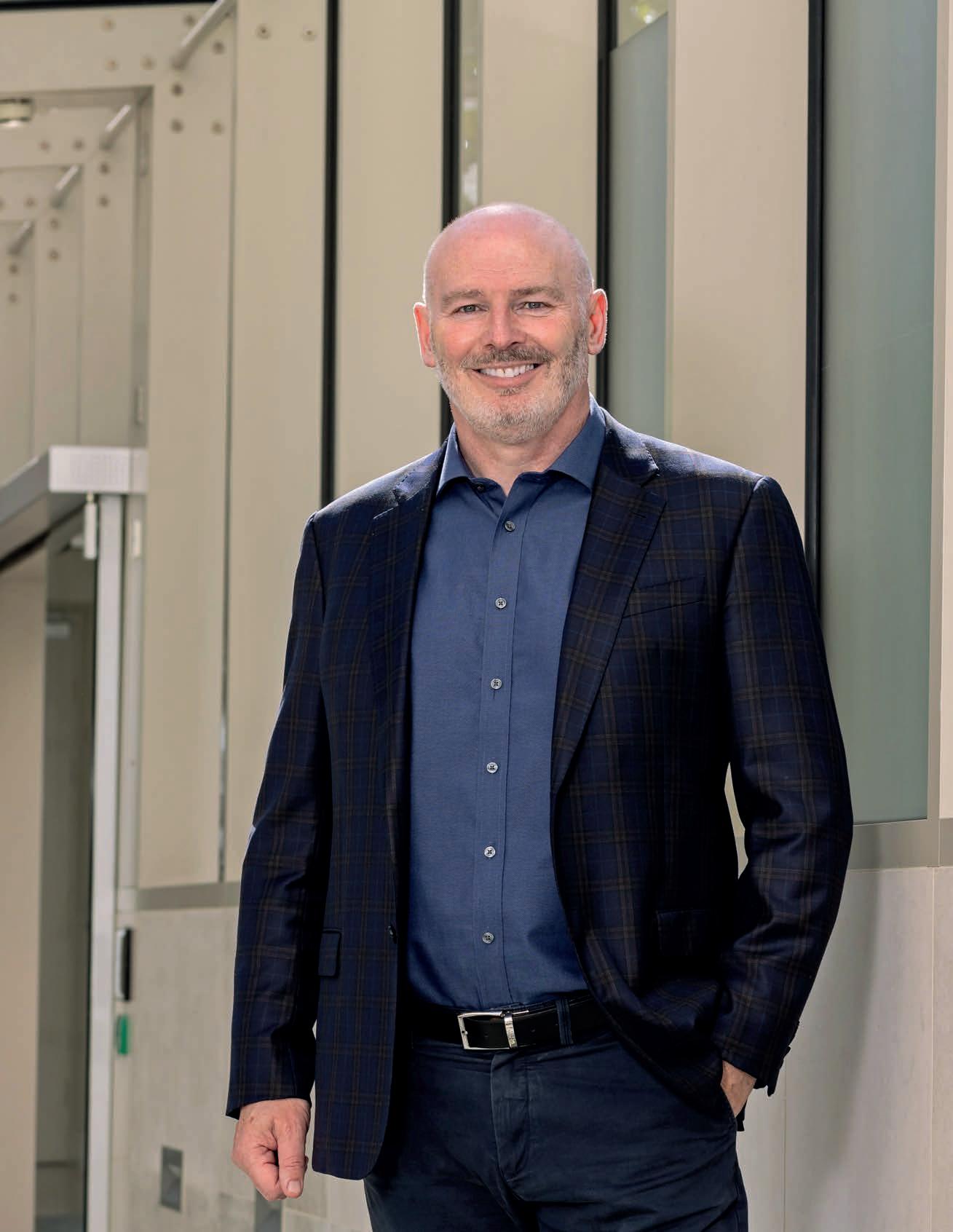
vice president of applications for Oracle Europe, Middle East and Africa. ERP Today has traveled to the heart of Dublin interview Watters, at the rather grand Merrion Hotel. The five-star establishment comes bedecked with noble busts, vintage paintings and a courtyard garden resembling a clas sical Mediterranean villa. In other words, we’re hearing a new tale within a frozen snapshot of history.

Watters is a relatively new orator for Oracle. Prior to Big Red, he had various roles at Infor, with his last one as president for the company’s international markets. Before Infor he was SAP’s COO for the northern EMEA region, meaning he’s somewhat come full circle with the VP job for Oracle applications, only this time covering the whole of the EMEA landscape.
He’s also returned home, back to living and working in Dublin after his London-based turns for SAP and Infor. For this kind of role, Dublin may be the perfect base for Watters. Kicking off our chat with what being in the EU nation of Ire land means when overlooking the European market, we learn a little more about how Cormac was pulled into Oracle’s orbit. When ERP Today covered his Oracle hiring all the way back in December 2020, a source told us that Safra Catz personally called Watters to make the approach, one “too good an opportunity to turn down”. While we didn’t bring up this fateful telephone exchange with Watters, it comes up naturally in his musings as he remembers Catz discovering where he called home and declaring Dublin the “perfect” base for Oracle EMEA.
Watters goes on to remind us that Ireland has no global baggage, as such. The Irish aren’t known to be “overly confrontational”, as he says, there are no bitter football rivalries - and certainly none of that Brexit malarky to taint its name.
“By and large, most people don’t have a negative view of Ireland,” as he puts it. “The small country aspect makes a big difference to all the other small countries that we work with. We can communicate quite well.”
The subtext here matches the new messaging coming out of Oracle - Big Red is getting close to its customers, whatever their size. For Watters, this change is all down to the pandemic, as he reminds us of Big Red’s footprint during the COVID era, working with governments around the world with the production and testing of vaccines, and the tracking of vaccination numbers. Catz began to talk about this work pub-
ware capabilities, rather than the usual “cloud and digital transformation” jargon.
“Safra realized that people are interested in what big companies are doing, not just their quarterly results and their technology stripes,” Watter says, before adding: “You can talk about it in a self-glorifying way, which we never do.”
Oracle’s charitable chapter
This is proved by the VP as he discusses Oracle’s work with charities and the third sector. Such a customer footprint would boost any tech brand, big or small, with their ESG credentials. But there’s none of that self-glory as he talks to us, and Watters reminds us that such clients, at the end of the day, remain corporate customers in essence. To truly understand how Oracle is becoming a “partner for good”, you need to listen to what the customers are saying and who is entering the Big Red fold from EMEA and elsewhere.
Third-sector customers for Oracle include UN affiliates such United Nations High Commissioner for Refugees (UNHCR),
88 ERP TODAY | UK / EMEA | Q3 2023 | INTERVIEW | ORACLE
THE FIRST SHOOTS OF AN EVOLUTION BEGAN TO SURFACE AS ONE OF THE MOST BELLIGERENT BRANDS IN ENTERPRISE TECH STARTED TO SHOW ITS SOFTER SIDE
names include Save the Children, with considerable - if not household-name status - bodies including the Norwegian Refugee Council (NRC) and AIDS, tuberculosis and malaria charity the Global Fund.
In other words, we’re talking about a broad church of charities, NGOs and nonprofits. Across the board, though, their needs are similar to any other big enterprise. As Watters tells us, these Oracle customers are very large organizations with many branch offices widely dispersed around the world. But the breadth of requirements is where the third sector differs from corporate. Some needs are focused on transportation management, in physically moving aid and supplies around the world. Others, like in the case of NRC, are focused on the HCM provision around staff and volunteers.
But there is one need which defines the sector, and that comes to financials. Not in the earnings and sales sense, but in transparency around the money in their accounts: after all, every financial transaction for a charity needs to be fully audited due to the donation aspect. This can be complicated when money is being spent in places where there’s very little infrastructure.
With Oracle, such bodies are exploring the best ways to track spend transparency in remote locations, considering lack of connectivity and that those using solutions may be a mixture of staff and volunteers (the latter freelancers, in some ways, with no company devices in their possessions).
“All of that stuff is what our applications do and gives that transparency they need,” says Watters.

The VP also gives an insight beyond data transparency and into data security, reminding us that charities have “massive” security concerns. Looking to avoid a cybersec disaster, clients are “very, very concerned” if they were to be hacked or held to ransom. As such, there’s a real need to make sure their infrastructure comes with industrial-grade security of the sort available with Oracle.
And when it comes to disasters, Watters sees forecasting as another essential for the charity sector.
“They’re looking at planning and trying to see how you can ‘forward look’ as far as you can to anticipate the next disaster. What I often hear them say is, they don’t necessarily know where the next one will be. But they’re pretty sure there’s going to be one.”
Simulations come in useful here, made possible by that Oracle compute through AI, with massive data sets taken from past events and elsewhere. This helps simulate how organizations would react in certain situations: wars, coups, earthquakes, hurricanes, flooding, you name it.
“They’re super innovative and forward thinking, and really, really good at managing stress,” says the VP of these clients. “They have to be able to react so quickly, to go from being professional business people to world-class athletes, to just having a great heart.”
Oracle the non-profit?
Watters’ lack of self-aggrandizement about Oracle’s charity partnerships holds true in our entire conversation, especially as what really emerges is a changing priority for Big Red in the 2020s. If you haven’t been paying attention, take Oracle’s big play in healthcare with the Cerner acquisition as a sign that Larry Ellison wants to “do good”, something Watters agrees with.
visit us ERP.TODAY 89
SAFRA REALIZED THAT PEOPLE ARE INTERESTED IN WHAT BIG COMPANIES ARE DOING, NOT JUST THEIR QUARTERLY RESULTS
One could see it as the Oracle cofounder’s intended legacy for his baby. The Oracle of the past arguably didn’t have that same “big heart” due to the chase for profits. But as said earlier, the times are a-changin’ for Big Red.
In this particular snapshot of history, Oracle seems to be in a halfway home between its hard-nosed past and an open, sustainability-focused future. So does Watters see full transformation coming a few years down the line?
“I know that sounds like a very grand ambition, but I genuinely can,” he begins. “You need to have the fundamentals of a very strong business that’s going to be around for the next 20 years. Because there’s no point in being so sustainable that you’re not here in 10 years.”
What Watters is saying is don’t expect Oracle to become a non-profit anytime soon. If a big company wants to have a big influence on the world for the better, then it needs to stay big. But he does remind us that every tender request Oracle receives has a strong sustainability element. Advancing from that, the VP expects in a half decade to a decade that every customer will expect tools from Big Red to help them measure their own sustainability. In other words, Big Red may very well become Big Green. Customers, the VP confirms, are saying it’s time to harvest sustainable data in the same way we mine financial data. All they need is for it to become “visible”.
With AI reporting and measuring the sustainability of enterprises with less bias, many businesses are waking up to the fact they may not be as “green” as they previously thought
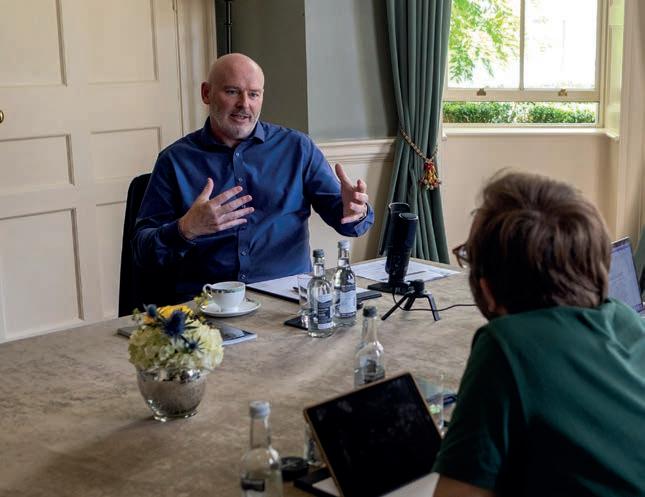
“THEY’RE LOOKING AT PLANNING AND TRYING TO SEE HOW YOU CAN ‘FORWARD LOOK’ AS FAR AS YOU CAN TO ANTICIPATE THE NEXT DISASTER. WHAT I OFTEN HEAR THEM SAY IS, THEY DON’T NECESSARILY KNOW WHERE THE NEXT ONE WILL BE. BUT THEY’RE PRETTY SURE THERE’S GOING TO BE ONE.”
they were. Enter a need for third-party accreditation, and tools to track and trace sustainability on an enterprise level, bringing in that essential visibility.
All of this shouldn’t come as a surprise, considering the vastly growing importance of ESG to modern enterprises. It’s this sign of the times which Oracle is responding to, a change which leaders like Watters are helping to make happen for the company.
“Can we transform completely? I believe so,” Watters reaffirms on Oracle’s future, and I’m reminded of something said earlier in the conversation. When talking about the pandemic, Watters noted that after COVID, for young professionals, it’s no longer just about salary when it comes to where they work.

90 ERP TODAY | UK / EMEA | Q3 2023 | INTERVIEW | ORACLE
THERE’S NO POINT IN BEING SO SUSTAINABLE THAT YOU’RE NOT HERE IN 10 YEARS
These days, he reminds us, people want to work for organizations which are helping the sustainability cause. They want to feel good knowing that while they work, they are helping, in some small way, towards a greater good. And that’s even if they’re not working for the sort of nonprofits discussed earlier.
After the interview, ERP Today drops Oracle a line with this train of thought, wanting to go back to that initial phone call between Watters and Catz. What was it about the role which was too good to refuse, that led to Watters leaving a seasoned career at Infor for a new break at Oracle?
“Speaking to Safra and the leadership team before I joined made it clear that there was a very clear vision from the outset,” Watters writes in response. “During and following COVID, there was no knee-jerk reaction; I got a real sense of calmness around mid-long term planning and perspective.

“At the time I joined, customer success was clearly our ‘North Star’. We couldn’t stand still, and again that message was clear from the top down. Now that we are closing my third year here I’m privileged to lead our EMEA applications operations delivering for our customers every day.”
Again, there is no self-glory here, no self-aggrandizement. Watters is working for the end user. With the third sector, he and Oracle are listening to its complicated needs and delivering tailored solutions. Within EMEA, he’s representing countries big and small, talking to them on their level. On an enterprise-wide level, he understands what customers are clamoring for to be genuinely sustainable.
The humble response he gives matches very well with Oracle’s modest new look - in other words, it looks like the wind of change is for real and enterprises have a big new friend in Big Red.

91 visit us ERP.TODAY
QUANTUM CREEPS CLOSER, READY

92 ERP TODAY | UK / EMEA | Q1 2023
OR NOT?
WILL QUANTUM COMPUTING DECRYPT ALL OUR SECRETS IN THE NEXT DECADE? IBM, DELOITTE AND ACCENTURE SECURITY AND QUANTUM COMPUTE EXPERTS THINK SO.
 BY STEPHANIE BALL
BY STEPHANIE BALL
visit us ERP.TODAY 93
PICTURE THIS - IT’S THE YEAR 2035 AND THE HEADLINE HAS FINALLY HIT -
ince quantum advantage was won in 2030, the flow of innovations began as commercially viable quantum compute now spills across businesses. Vaccine and drug simulations revolutionize human and animal testing, new LLMs are being trained at high speed and more accurately than ever before. Our leading financial institutions have noted record data speeds and numbers of bumper trade deals and transactions processed, and the world celebrates as a new CO2 catalyst has been discovered to recycle carbon dioxide into hydrogen.
But, over the weeks that follow what’s been dubbed the “Summer of Quantum Success”, the number of stably-formed qubits in a quantum computer reach 4099, and around the world, the cyber-attacks begin as our public key encryptions crack under Shor’s algorithm. This eventful day comes to be known as “Q-Day”.
Data set after data set is unveiled, unraveled and distorted, or else held hostage for billions of dollars ransom. Historical data harvested well before QDay undergoes a series of damaging leaks, bringing down enterprises. Amidst the turmoil, a select few organizations remained safe, cushioned by the quantum-safe, cyber agile algorithms they had finished updating just in time after a decade of preparations.
Now you might say imagination has overrun journalism here, but there’s no doubt that a future powered by quantum computing is set to be world-changing. Not too dissimilar to the hype cycle around AI, the excitement around the upcoming capabilities of quantum computing is fast approaching its apex. Fully commercially viable quantum, as well as encryption cracking quantum, are still a good few years away in theory, but experts from IBM, Deloitte and Accenture are speaking loud and clear that quantum readiness needs to begin now.
AT THE PEAK OF THE HYPE CYCLE
Hype aside, there are some realistic use cases for quantum computing abilities we will hopefully see in the next few years which will be colossal for our planet and our lives. The initial sweet spot of use cases will be simulations and calculations that don’t require fast below millisecond response turnaround, and areas like modeling at the molecular level with quantum.
Richard Hopkins, distinguished engineer and senior quantum ambassador at IBM, shares the likely realities of early quantum commercial viabil-
ity: “I’m expecting that there are enough high-value use cases, ones that don’t require millisecond turnarounds like in Visa and the MasterCard of payment type scenarios, where if we’re trying to optimize the flow of energy around the planet, biotech tankers or whatever, that’s a problem that you could probably look at once a day, rather than trying to do it within a millisecond.”
At the moment, maintaining qubits for usable periods of time is still a blocker for many use cases. One goal for IBM, besides continuing to grow the number of qubits in their quantum machines, is to create a cloud-based server farm with multiple quantum processing units (QPUs), protecting from outages and alleviating the need for a total reset, recalibrate and read if there is a disturbance in one of the superconducting method cylinders.
True commercial viability of quantum computers across the world is still a few years away, with 2030 often touted as the expected timeline, though some are anticipating sooner. Microsoft has partnered with quantum hardware companies Quantinuum, IonQ and Rigetti to provide cloud access to quantum hardware with 23 fully connected qubits and Amazon has acted similarly to deliver its own Amazon Braket quantum tools. IBM currently has one 433 qubit machine, Osprey, sitting out there on the web today and it’s also announced an upgrade to the 24 other machines available for users, ramping up that entire fleet to 127 qubits, its Eagle processor. Many of these have free fees for academia and right now IBM Quantum’s Composer is free to play with and build, visualize and run quantum circuits on quantum hardware or simulators.
In a measured approach, Hopkins is quick to state that though he suspects IBM is in the lead for quantum computing research with the most amount of qubits, there is a way to go before claiming quantum advantage (aka commercially viable quantum): “It’s going to require some new science and some new maths and a lot of research and maybe even a large supercomputer to be able to fully verify what we’ve done has been absolutely right. We want to claim it when we know that we can demonstrate that it has produced the right result in a real-world context that no conventional computer has ever been able to solve within a reasonable timeframe.
“There’s so much competition in the field. Superconducting, ion trap, photonic and others, they’re all at different stages of evolution, and they all have their strengths and weaknesses. I’d certainly not be surprised to see multiple quantum technologies suc-
94 ERP TODAY | UK / EMEA | Q3 2023
| EXPERT OPINION QUANTUM DECRYPTION
“QUANTUM COMPUTING IS NOW”.
ceed with different techniques being used for certain kinds of problems. But I think where the frustration will kick in is that we can’t get it everywhere all at once. There’s still a way to go on the engineering before we can change the world and change the planet. It is going to take a bit more time. As an engineer, that’s going to be annoying.”
It’s a similar outlook for Scott Buchholz, CTO of Deloitte’s government practice and global quantum computing lead, as he shares that quantum is set to have a softer launch than we might expect: “I think people have this impression that we’re going to wake up one morning and quantum computers will have taken over the world. But the challenge is, if we look on [to] January 1, 2030, what would the world have to look like for people to feel like the transition had happened? In the next few years, we might start seeing niche problems where quantum computers can do better than classical computers. And two years later, there will be yet more problems that are better solved with quantum computers, and so on.
“I think people conceptually think there’s going to be a light switch or a Frankenstein switch. It’s going to be more gradual than that, it’s not going to be quite as dramatic as people think.”
Buchholz uses the example of the slow introduction of digital cameras into the mass market, and arguably you can also draw a similar parallel to the advancement of AI, as both plotted paths from niche and inaccessible use cases to becoming more readily available for everyday and commercial use.
Yet, despite the predicted slow burn of quantum benefits, what remains more pressing at the top of experts’ to-do lists is sharing the graver concerns around quantum risk.
QUANTUM RISKS WILL BREAK TODAY’S CYBERSEC
In the mission to continuously grow the number of qubits available for powering larger and faster calculations, it’s predicted that as the number of qubits strikes the quantum-defining figure of 4099, the machines will have the negative side effect of being able to implement an algorithm to crack our current public encryption algorithms, and perhaps much of our distributed ledger technology too, rendering the majority of our cyber security systems to date wide open for hackers.
For IBM’s Hopkins, this has been a concern to beat since last decade: “Staying cybersecure with quantum - that’s all about people understanding it’s a genuine threat in the first case. When I first told
people about this, back in 2016, people just looked at me and went ‘you’re kidding’.
“The timeframe for when quantum computers start doing bad things, the kind of cyber issues such as breaking cryptography, breaking the stuff that underpins our daily lives now, that is looking like potentially somewhere between 2030 and 2035.”
Not only that, but a growing trend of stealing now to decrypt later is emerging, where despite being unable to access the data now, actors are harvesting today’s confidential data so that when the technology is ready, it can be hacked in the future. It’s prompted a kind of modern-day space race of sorts, where perhaps nations and organizations are investing rapidly to reach viable quantum first.
Dr Colin Soutar, Deloitte’s managing director of cyber and strategic risk products and technology for US Government and public services explains:
“There’s a narrative that there are some nation states, and corporations for corporate secrets as well, that are purportedly stealing data today in the anticipation that they were able to break it tomorrow. It’s called ‘harvest now, decrypt later’. It is likely the nation states will get into that sort of discourse in terms of actively trying to develop ahead of each other. But also, there is the thought that corporations, you know, have similar interests as well.”
Thankfully, however, there are currently solutions, with a range of counter-algorithms available that the big quantum firms claim to be resistant to quantum-powered hacking.
IBM’s Hopkins, for one, shares: “Now, we have four quantum-safe algorithms, approved through a competition, and we’ve been rolling out quantum-safe stuff very seriously. What’s the next target for the hackers? Well, they’ll probably be looking to get anything on the mainframe because that’s where most of the world’s financial data still resides and everything else, so we’ve put quantum safe algorithms into the z16 [mainframe

visit us ERP.TODAY 95
THERE’S STILL A WAY TO GO ON THE ENGINEERING BEFORE WE CAN CHANGE THE WORLD AND CHANGE THE PLANET.
RICHARD HOPKINS IBM
computer from IBM] and we’ve put it onto our cloud. So we’re rolling this stuff out pretty incrementally and pretty quickly, actually.
“The greatest minds in the world have come up with a new way that doesn’t rely on factoring and relies on something called lattice, which is a different way to weave in a shared secret and sort of perform the same function, but with different math. So that will stand up to a quantum computer no matter how big it gets, because it doesn’t rely on what a quantum computer can do well.”
Nonetheless, as Hopkins states, it presents businesses with a new kind of dilemma many have yet to encounter.
“We’ve been very lucky, frankly, that we’ve had very stable cryptographic environments that haven’t needed to change,” says Hopkins. “All we need to do is increase the key length for the last 40 to 50 years. But now we’re beginning to realize that as quantum computers come along, we definitely need to check the algorithms.”
WHO’S ACTING NOW AND HOW?
Though expectantly specific customer names can’t be shared, Big Tech names have said that leading financial institutions and governments are starting to take next-step actions increasingly seriously, and with some industries built entirely on cryptography, such as telecommunications, we are looking at entire industry reengineering for the goal of becoming “quantum safe”.
To create cyber protection beyond the likes of quantum risk, businesses’ next steps look to reach for cyber agility, a more flexibly updateable cybersecurity model, to enable a faster update to their security systems in


the future. Historically, examples of the time taken to update security models lie in the decade bracket, and the big names are advising that this current update for quantum readiness could take around eight years.
Time is surely ticking, and action is needed a lot faster than the predicted 2035 deadline might suggest. The likes of IBM, Deloitte and Accenture, among others, are working with industry bodies to speed up that movement.
Accenture is currently advising every business to develop a quantum security plan as part of their five-year security plan, and Tom Patterson, Accenture’s global lead for quantum security and space security, shares: “It’s certainly a question that comes up in every business meeting I work in - when will the newspaper headline be ‘Quantum computers can now decrypt all of your secrets’? Because we know that the race is on. The whole concept of the way we do public key encryption needs to be changed, the math needs to be traded. And the only question is, are you, the organization, going to implement the solution before that headline appears? Are you going to do it the day after, when you’re at huge risk that your whole business could be shut off and be in scramble mode?
“We put in a system so that algorithms can be rotated easily. That’s what governments are moving towards and that’s what a lot of the large financial organizations are moving towards. In the UK, you look at GCHQ - what they’re saying is we need to fix our systems right now. In the US, it’s the NSA, the White House with executive orders. They’re acknowledging the same messages.
“We really strongly believe that there are good answers for this. It’s not a big scary ‘we’re in trouble and there’s nothing you can do’; it’s really that this change is coming, it’s going to be a big risk but there’s something you can do - and it’s not cost prohibitive and it doesn’t require magic - it just requires action.”
Speaking for IBM, Hopkins is clear that as amazing as the support for quantum technologies is, there is ongoing
TOM PATTERSON ACCENTURE
96 ERP TODAY | UK / EMEA | Q3 2023 | EXPERT OPINION QUANTUM DECRYPTION
WE KNOW THE RACE IS ON. THE WHOLE CONCEPT OF THE WAY WE DO PUBLIC KEY ENCRYPTION NEEDS TO BE CHANGED.
IF A NATION STATE HAS A QUANTUM COMPUTER THAT WANTS TO ATTACK CRYPTOGRAPHY, THEY’LL USE IT PRETTY QUICKLY.
DR COLIN SOUTAR DELOITTE
need for greater action: “We’re working very closely with GSMA and a few other industry bodies there to make that movement start to happen. I don’t think the US government’s woken up to it and I don’t think UK government has quite managed to understand the threat fully. The UK government is very excited about the quantum strategy and investing £2.4bn into quantum technologies. We have to understand that push forwards on technology comes with a downside; you’re going to have to sort out the cryptographic systems in time for 2035 at the latest. But these are about three-year programs to even get to the point where you know what you need to do first - these are fairly major things.”
However, industry standards don’t currently contain this upgrade requirement, with next year set for the National Institute of Standards and Technology to redefine these regulations. That’s not to mention the upheaval involved, with perhaps the need for incentives and greater assistance to get organizations started on the long upgrade journey.
With uncertain timeframes surrounding quantum, Deloitte’s Soutar suggests that some organizations are hesitant to act over security updates, despite the security position from the World Economic Forum’s reports stating to kickstart actions now.

Soutar explains: “Our story is be cautious. If you wait four years, it’s going to take eight years to do all your upgrades. For quantum computing, there won’t be a light switch that will flick one day but you can bet if there’s a nation state that has a quantum computer that wants to attack cryptography, they’ll use it pretty blindly, and pretty quickly. So if that’s ten years out, and you’re still doing your upgrades, then that’s a huge problem, right?
“The first steps really talk about discovery. Where are your cryptographic algorithms today? How much is in-house? How much are you relying on third-party and your suppliers to provide? What data are you protecting? What communications are you protecting using cryptography? And once you’ve got a sense of that inventory, then you can start to think about what does it mean to be what people are calling “crypto agile”, and run things in parallel or quickly do an update to another system.”
A BALANCED QUANTUM LENS OFFERS US A CHANGE OF TACT
From some of the world’s most influential quantum computing experts, the message is that the race is not resting on the fastest nation or organization to reach commercially viable quantum advantage, but rather
on businesses to succeed in protecting themselves in time for the quantum cyber security threat and then be able to continue gaining the use case benefits.
With the size of these projects no doubt seeming insurmountable to some, it calls into question the enterprise approach to data collection over the past decade as businesses now start to shift into cyber agility. Contrary to the mass data grab we’ve been experiencing over the past five, ten years, with the more data mentality, wherein the more we have, the more we can process and the better we can run our businesses, Deloitte is instead encouraging people to rethink the data they keep on tap.
Buchholz says: “It’s just good cyber hygiene that needs to be done. I’m hopeful that there are two consequences of this quantum lens. One is that better cyber hygiene around cryptography in general, regardless of the quantum threat or not. Secondly, I think it will make organizations in the commercial and the government sectors think twice about the data that they are storing and whether they really need it or not, because again, you can’t steal data that’s not available.”
And beyond Buchholz’s cyber hygiene benefits, there are also the storage costs, both monetary and environmental to consider, where we have been holding on to so much unused but perhaps potentially risky data.
Regardless of the risks involved with potential bad quantum actors, technologists also remain optimistic that beyond the far-flung ideals of the hype cycle, quantum compute will still have ongoing groundbreaking benefits that will outweigh the cyber risk negatives.
Accenture’s Patterson covers this neatly in saying: “It’s really going to change the world… Quantum communications will be running by the end of this decade; quantum computers are already available in clouds that you can use. The winner is really humanity and I fully support the continued global efforts to try and push the science because it’s to everyone’s benefit.”
visit us ERP.TODAY 97
I’M HOPEFUL A QUANTUM LENS WILL MAKE ORGANIZATIONS THINK TWICE ABOUT THE DATA THAT THEY ARE STORING.
SCOTT BUCHHOLZ DELOITTE
Remote work and GenAI: spanners in the cybersecurity engine?
 BY YOANA CHOLTEEVA
BY YOANA CHOLTEEVA
98 ERP TODAY | UK / EMEA | Q3 2023

REMOTE W O R K A N D GENAI ARE HER E T O S T A Y . B U T TAHW D O E S T H I S NAEM ROF ETNE R P R I S E C Y B E R S ECURITY? visit us ERP.TODAY 99
Pre-pandemic, approximately eight percent of workers did their work exclusively remotely, with that number rising to 39 percent in 2022 and projected at 24 percent this year, according to Gallup . But with the rise of hybrid and remote work, cybersecurity has had a harder time catching up with issues such as accessing sensitive data through unsafe Wi-Fi networks, using personal devices for work, weak passwords and unencrypted file sharing all becoming more common in the workplace.
Reportedly the damage related to cybercrime is projected to reach $10tn annually by 2025, according to data from
Cybersecurity Ventures . So does the workforce care about cybersecurity? Maybe, but perhaps not as much as they should care.
Echoing these challenges brought by the proliferation of remote work, Sarah Armstrong-Smith, chief security advisor at Microsoft for EMEA, says that the pandemic changed everything: “We saw a mass acceleration with cloud adoption and the use of collaboration tools. We saw lots of companies investing in smart technologies. We’re now seeing companies invest in AI and so cybercriminals are going to keep evolving their tactics too, utilizing the latest technologies to
bypass security measures.”
As outlined in Microsoft’s latest Cyber Signals report, identity is the new battleground and the number of attacks in this space continues to rise. Here, Microsoft has detected and blocked more than 25.6 billion attempts to hijack enterprise customer accounts by brute-forcing stolen passwords. In addition, the tech giant has blocked over 35.7 billion email threats in a single year thanks to ongoing scanning for malicious content.
For this reason, Armstrong-Smith says that the new world of hybrid work requires even more heightened attention to cybersecurity.
We can’t forget the human impact on cyber
While no particular sector is immune to cyberattacks, Armstrong-Smith says most people naturally have the mindset of “I’m only a small business or a charity. I do nice things. Why would someone attack me?” But this does not diminish the associated risks, the Microsoft chief warns.
“The answer is, why wouldn’t they attack you?” she says. “That’s the reality. Cybercriminals understand the value that can be extracted from a business if they’re able to access its systems and data… Often, victims are merely unlucky, not specifically targeted.

“Organizations need to shift towards human-centric security, by training employees against the evolving tactics of cyberattacks that increasingly focus on social engineering and manipulation,” she tells ERP Today.



100 ERP TODAY | UK / EMEA | Q3 2023 | EXPERT OPINION | CYBERSECURITY
“WHY WOULDN’T THEY ATTACK YOU? OFTEN, VICTIMS ARE MERELY UNLUCKY, NOT SPECIFICALLY TARGETED.”
We all know about the rapid changes brought on by the COVID-19 pandemic. But undoubtedly, the strong response from enterprise tech firms became paramount to making nearly every industry’s overnight transition to remote working productive and successful.
SARAH ARMSTRONG-SMITH / MICROSOFT
Digital working has affected sectors differently
However, as bad actors are threatening the security of organizations, some sectors are becoming savvier than others, with financial service organizations and higher-risk firms being a little ahead of the game and well aware of cybersecurity, implementations and applications, according to Hitesh Bansal, country head UKI and senior partner of cybersecurity and risk services at Wipro.
Data from Statista has shown that over 2022, manufacturing was the industry with the highest share of cyberattacks among the leading industries worldwide (24.8 percent), with finance and insurance following with around 19 percent. Professional, business and consumer services ranked third with a share of 14.6 percent.
With the past three years affecting the retail sector greatly amid the pandemic restrictions, Bansal believes that this industry in particular suddenly had to move to online experiences for clients and embrace the digital way of doing things. However, this greater exposure to cyber risk opened Pandora’s box for some of Wipro’s clients because they were novices in this environment.

As such, he explains that this has definitely built-up the appetite for greater security in some of those sectors: “I think if you look at the overall cybersecurity maturity, it’s definitely gone up. It’s also due to the fact that the attacks - or let’s say the threats - have become more sophisticated.”
How AI benefits both “good” and “bad actors”
The expanding cybersecurity threats are making it ever so crucial for workers to be trained and extra aware of the dangers, especially with AI thrown into the mix.
As we see more sophisticated technologies encompassing generative AI, tech experts warn that these capabilities
can also work to the benefit of bad actors, granting the opportunity for malware to grow as it is generated on demand for attackers with malicious intent.
Warning about this increasing practice, Sunil Potti, general manager and vice president of cloud security at Google Cloud , said during a recent AI and cybersecurity roundtable attended by ERP Today, that the work of bad actors prior to GenAI was limited because they needed to be experts at what they did. However, “just like GenAI can democratize our own talent on the good side, it can democratize talent on the bad side,” he says, while adding, “the big trend that we have to keep in mind is that suddenly the pyramid of all people that could be attacking could be accelerated by 10x or 100x.”
While agreeing that GenAI can be used to harm business security, Paolo Dal Cin, global lead of Accenture security, said during the virtual roundtable that this doesn’t need to cancel out the benefits of AI since the issue can be approached from a strategic perspective.
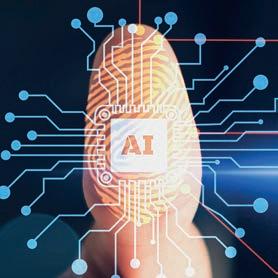
GenAI can instead be used to “detect well-known attacks, and, maybe very soon, so-called ‘zero-day attacks’ - attacks that are not yet well known, based on anomaly detection, unknown patterns or anomalies much more quickly”.
While reaching the point of an incident is the culmination of the attack, Dal Cin says that as an added element, AI could be used strategically and assist prior to an attack actually taking place - by “doing malware analysis and sharing all the information we have collected from our environment with a generative AI engine, in order to have a very comprehensive view and understand better what kind of bad actors are attacking us and with what techniques”.
But with the rise of technology innovations, while it may be essential to encourage caution and reduce company risk, it’s equally important not to instill fear, Armstrong-Smith warns, as this poses the threat of “hindering productivity or stopping innovation… Instead, employees should feel empowered to recognize potential threats and take necessary precautions.”
Weighing in on the future of cybersecurity as innovations like AI become commonplace, Potti says that some mistakes are to be expected: “My meta concern with the internet or mobile is that we’re going to screw things up sometime soon…It’s just inevitable. But that shouldn’t take away our ambition and our aspiration to change the world with some groundbreaking technology like GenAI.
visit us ERP.TODAY 101
“OVERALL CYBERSECURITY MATURITY, IT’S DEFINITELY GONE UP. THE THREATS HAVE BECOME MORE SOPHISTICATED.”
HITESH BANSAL / WIPRO
“The greater good that we could do with it over the next 20 years far surpasses whatever mere problems. So, I think as long as people keep that in context, it will be alright.”
What does the future of cybersecurity look like?
With remote and hybrid work now piercing a hole in some of the established ways organizations protect themselves, Google Cloud’s Potti tells ERP Today that this fresh task can benefit from a new approach - for instance, seeing the home-based locale of remote working as an edge extension.
“Just like we have the edge of the data center, then we have an enterprise edge. In the post-COVID world, we are just expanding to say, ‘Hey, is there a way to create a zone called edge on your professional laptop, but through your network, through your Wi-Fi and everything else?’ At least the enterprise portion of it is still managed as a virtual agent,” Potti explains.
At the same time, he says this strategy can be coupled with zero trust browserbased capabilities to create that secure zone whenever you are at home, meaning data leakage is kept at bay.
Going back to artificial intelligence, Microsoft has revealed its AI-powered Security Copilot, currently in preview, with the tool leaning into GenAI capabilities to help detect hidden patterns, harden defenses and respond to incidents faster.

By harnessing “trillions of signals” with machine learning, Microsoft is also invested in a deeper understandingwhere the attacks are coming from and the tactics they are using, as its threat intelligence offering actively shares what it learns with the wider industry to boost collective knowledge and fight against cyberattacks.
In the firm’s effort to help more businesses unsure of their cybersecurity needs stay safe and protected, Armstrong-Smith says: “We need to instill the mindset of cybersecurity as a business


enabler - it is crucial to link effective cybersecurity with the overall success and longevity of the business, no matter what is on the horizon.”
What this means for cybersecurity vendors themselves is a reallocation of resources, according to Wipro’s Bansal, who explains that with the advancement of AI, we will see “less emphasis on laborintensive cybersecurity. It will be more technology-led and more analytics-led, but the decision-making will be assisted.

“So instead of me grappling with ten screens and trying to figure out what to do, I would have intelligence and simple questions as an analyst assisted by AI to answer and protect my same assets in a very different way.
“Because that’s exactly how bad actors are performing things right now, they use AI and a lot of information on the dark web to attack, probably we’d be using the same but to protect.”
But while all big players in the cybersecurity community are scrambling to anticipate the unforeseeable threats emerging on the horizon, Bansal says this work is an ever-evolving process.
“That’s something which keeps us on our toes…I think it will never reach a point where we can passively hang our boots and say ‘Yeah, we are okay with cybersecurity, now forget about us’. That’s not gonna happen.”
102 ERP TODAY | UK / EMEA | Q3 2023
| EXPERT OPINION | CYBERSECURITY
“[GENAI CAN] DETECT WELL-KNOWN ATTACKS BASED ON ANOMALY DETECTION, UNKNOWN PATTERNS OR ANOMALIES”.
“GENAI CAN DEMOCRATIZE OUR OWN TALENT ON THE GOOD SIDE, AND TALENT ON THE BAD SIDE”.
PAOLO DAL CIN / ACCENTURE
SUNIL POTTI / GOOGLE CLOUD









MASTERING ERP
18 - 19 SEPTEMBER 2024










ASCOT RACECOURSE

THE ONLY LEARNING AND EDUCATION CONFERENCE DEVOTED TO MASTERING ERP, BROUGHT TO YOU BY THE ERP INDUSTRY’S #1 MEDIA PLATFORM.
+ 2 DAYS OF INSIGHTS FROM INDUSTRY LEADERS WHO HAVE MASTERED ERP AND DIGITAL TRANSFORMATION.




+ 500+ CIOS AND CFOS FROM THE MOST INNOVATIVE ENTERPRISES.

+ 75 SESSIONS BY INDUSTRY LEADERS, TECHNOLOGY INNOVATORS AND ERP TRAILBLAZERS COVERING THE TOPICS THAT MATTER TO ALL ERP CUSTOMERS.

TECHNOLOGIES: THE LATEST DEVELOPMENTS AND INSIGHTS FROM INDUSTRY LEADERS COVERING FINANCE, PROCUREMENT, HR, SUPPLY CHAIN, ARTIFICIAL INTELLIGENCE, SECURITY AND MORE…


INDUSTRIES: DEDICATED TRACKS DEVOTED TO MANUFACTURING, HEAVY INDUSTRIES, PROFESSIONAL SERVICES, EDUCATION, HEALTHCARE, LOCAL AUTHORITIES AND MORE…












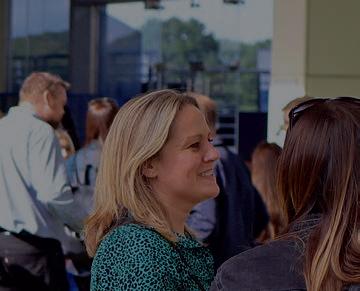












ERP.TODAY DETAILS SOON AT MASTERINGERPCONFERENCE.COM
2007 IT’S ALL OVER AGAIN
Two vendors with different products but a common link

 BY PAUL ESHERWOOD
BY PAUL ESHERWOOD
106 ERP TODAY | UK / EMEA | Q3 2023
search for their defining moment. Will they find it?

visit us ERP.TODAY 107
hile the iPhone may seem more defining than a streaming service, Netflix’s decision to deliver services over the internet was an equally important milestone. Not because movies and TV are vital components of life, but because it is the characterizing example of a real-world company betting ahead of the market and demonstrating that the internet (from now referred to as cloud) was the future.
It took several years and a lot of money for Netflix’s gamble to proveout, but Apple’s bet was an instant hit. At a stroke, Steve Jobs provided a simple and elegant interface that hid the complexity of a decade of application development and presented the user with a clean and unencumbered experience. Anyone who had played Snakes on a Nokia or tried to use Excel on a Blackberry was bowled over by the simplicity, while the iPhone’s touch screen technology set a new benchmark for user experience that remains the standard today.
These two breakthrough moments in consumer technology share stunning similarities with two vendors in the enterprise tech space – a space that traditionally lags consumer developments by a decade or more. While the average man or woman will not tolerate anything less than a seamless digital experience in their personal lives, the average worker is still subjected to technology that can trace its roots back more than 50 years. ERP systems have improved, but cloud ERP only has
about 10 percent market penetration and the vast majority of business users still rely on tech that is hosted locally and delivers a very poor experience.
2024, a seminal year for two different vendors
The two vendors in question are SAP and ServiceNow. SAP has been the benchmark for business applications for 50 years and ServiceNow, a relative upstart, is positioning itself to be the control tower for all future business technology. While the two companies are very different, they are both poised for a seminal year in 2024 – one which is likely to define their future for decades to come.
SAP has made a big bet. In fact, I would go as far to say that Christian Klein has pushed all his chips over the line. Klein already held a decent hand, but akin to the card player faced with a stick or twist moment, he has drawn breath, summoned courage and gone for it. The glacial pace with which customers are moving to the cloud (not just within the SAP install base) has forced some radical thinking – and radical statements. Declaring that new innovations are for cloud customers only, Klein and SAP have effectively told their patrons to get on the cloud train or be left behind. The days of pandering to a narrative that suited everyone are over and SAP has drawn a line. On one side of that line is SAP, S/4HANA and the public cloud. On the other side of the line is the past.
ServiceNow hasn’t made such an overt statement, but it too is positioning itself for a serious acceleration of its phenomenal growth story. A mixture of good timing, expert aligning and a smat-
| OPINION |
SAP AND SERVICENOW 108 ERP TODAY | UK / EMEA | Q3 2023 W
These
In 2007 the world of consumer technology got two big breakthroughs. Netflix started streaming movies and Apple launched the iPhone. These two developments gave us a glimpse into the future and paved the way for the digital revolution in homes and offices around the world.
two breakthrough moments in consumer technology share stunning
tering of fairy dust courtesy of its indefatigable CEO has propelled ServiceNow into a unique position in the market. Underpinned by a very solid technical platform, the company has morphed itself from an anonymous IT service desk company into the hottest tech player in the enterprise space.
In less than five years, Bill McDermott has transformed ServiceNow into a powerhouse that has been nibbling at the edges of the ERP space for some time. Now they are poised to make even bigger inroads with workflows for finance, procurement and supply chains that ameliorate the pain of modernizing ERP with a new front end, improved visibility and a sandbox of tools to connect data and people across multiple workstreams. Above all, ServiceNow promises to fix the experience of ERP and that message is a gamechanger for users.
The two vendors are very different and their routes to success are divergent, but I believe 2024 will be the defining year for both. Klein’s bold move will either be a masterstroke that finally drives the SAP install base to the cloud or it will go down in history as a corporate blunder that costs SAP its position as the premier ERP vendor. McDermott’s move, although less obvious and certainly less risky, will be determined by his ability to scale ServiceNow and keep pace with the window of opportunity. Remember, when Apple launched the iPhone, Blackberry dominated the business mobile space and Nokia was the only serious contender for consumer cell phones. Both those brands saw the future but they missed their window and Apple crushed them. The question is can ServiceNow seize its moment in a repeat of the legendary year that was 2007?
SAP’s Netflix moment

When SAP’s CEO, Christian Klein, announced to investor analysts on 20th July that “SAP’s newest innovations and capabilities will only be delivered in SAP public cloud and SAP private cloud using RISE with SAP as the enabler,” a tidal wave of discontent rippled across the SAP ecosystem.
User groups were quick to stick the knife in with Jens Hungershausen, DSAG board chairman describing the news as, “a major blow” and Thomas Henzler, DSAG board member, stating the announcement was, “a real showstopper and a big disappointment.”

On the back of these formal statements, hundreds of self-proclaimed experts took to LinkedIn and X to vent their frustration at Klein. Some even called for his head and suggested his days as CEO were numbered. The outpouring was similar to when SAP first announced it would end support for ECC6 - that backlash was justified, but this time not so much.
Before we get too deep into exactly what the announcement was, how it has been misinterpreted and where SAP can learn some lessons about communication, let’s just take a pause and consider how a similar big cloud bet paid off for Netflix.
In 2007 Netflix had a very successful DVD mailorder business having delivered more than one billion DVDs to customers in the previous decade. Despite its history and dominant position in the market, it decided to rethink how to best serve its customers. That statement is important because it is at the heart of the story.
Netflix offered a library of more than 70,000 DVDs for rental whereas the new streaming service launched with just 1,000 titles. This limited offering was compounded by average internet speeds of less than 2Mbps and a customer-base yet to discover the aforementioned iPhone. To say that Netflix’s decision was bold and ahead of the curve would be a massive understatement. Yet today, the name and business model are as familiar and ubiquitous as running water.
Netflix’s gamble was made at a time when internet usage was approximately one-sixth of the level it is today and yet the company bet the farm that building a solution for the future would better serve its customers - even if many of those customers still preferred to get a red envelope through the





similarities with two vendors in the enterprise tech space

















door than download a movie over the internet.
The dilemma that SAP and its customers are facing is almost identical. At present the vast majority of SAP’s customers use either legacy on-premise technology or have adopted the latest flavor of ERP but chose to deploy in a similar environment. As little as two years ago, SAP was encouraging customers to move to S/4HANA and offering on-premise as a comparably suitable solution to public or private cloud. Today, that is not the case and SAP has clearly stated that customers should deploy S/4 in either the public cloud or private cloud, provided it is done so via RISE with SAP.
It’s a bold and unpopular decision but here’s why it is the only decision SAP could take.
Firstly, let’s just look at the economics. SAP is a public company and is judged by the markets on various metrics, chief amongst which are its cloud and subscription revenue numbers. All protagonists in the enterprise tech space only boast about their cloud numbers (even those that don’t really have any cloud numbers) and if SAP is going to be taken seriously as a cloud company it must project that message to the markets. SAP has been a public company since 1988 - some customers may not like it, but the fact is SAP has to maintain its position, market capitalization and status against some very stiff competition. Imagine if SAP didn’t make a serious cloud play. Imagine it pandered to the user groups and then ran into some unforeseen challenges which would have far greater implications for customers. Klein’s message is as much to customers as it is to shareholders - SAP is a cloud business.
Allied to the above is SAP’s need to future proof its long term revenue growth. Despite the drama around the 2027 ECC6 deadline, most, if not all, of SAP’s big customers will have committed to S/4 by then. In fact, most already have (albeit not all public cloud). As the

volume of large convertible customers decreases, SAP needs to be able to sell its other offerings in order to maintain revenue growth and it can only do that to customers that are in the cloud and can actually take advantage of it. Increasingly the hyperscalers are providing innovations outside of the core ERP capabilities and SAP needs to retain and regain some of that wallet share.
Let’s also consider SAP’s turnaround on S/4HANA on-premise and private cloud outside of RISE. Yes, the position has changed and yes that will be a blow to any customer that deployed S/4 recently in either of those two environments. But is it any surprise that things have changed given the rate of change we all see in every other aspect of our lives? Would it be better for SAP to continue to encourage customers to deploy on-premise when they know it’s impossible to deliver all of the latest innovations outside of the public cloud?
There’s a concept in technology that encourages “fast failure” and although S/4HANA on-premise isn’t a failure, the sentiment is the same. Two years is a long time in tech, four years even longer and SAP has developed so many new innovations in that window that require the power of the public cloud that it is inevitable the landscape had to change. How would real-time environmental data and analysis work for Green Ledger if all the customers using it had their own private instances of S/4? How would customers use artificial intelligence and GenAI if the compute power those
110 ERP TODAY | UK / EMEA | Q3 2023
| OPINION | SAP AND SERVICENOW
ON ONE SIDE OF THAT LINE IS SAP, S/4HANA AND THE PUBLIC CLOUD. ON THE OTHER SIDE OF THE LINE IS THE PAST
Christian Klein
PHOTO: KURT REBRY
technologies needed was out of their reach? How would the power of the Business Network and cohorts of similar customers make use of shared data if they are segregated from each other? The reality is that any customer, SAP or otherwise, that wants to remain competitive and build a long-term viable business has to be in the cloud.
Some customers may argue “we don’t need to be in the cloud to be successful” and that may be true today, but it won’t be tomorrow. Even the most resistant of businesses must accept that they will not be able to compete with other similar businesses if they are not on an equal technology footing.
The backlash has been severe but a large part of that can be attributed to a poorly communicated message and a bunch of commentators and journalists too eager to jump on the condemnation bandwagon. I commend Klein and the SAP executive team for taking a bold stance and reject the claims that the company is turning its back on loyal customers. If the last two or three years have shown us anything, it’s that the future is uncertain. Things change quickly and only the most resilient of businesses will prosper in the five-year project. As unpalatable as it may sound, SAP is actually do-
ing its customers a favor. Businesses, people and processes move at a very slow pace unless there is someone or something pushing hard for change. Yet when forced to do so it’s incredible how quickly we can adapt to a new paradigm. Just consider the COVID crisis as one example: if you had told business leaders in late 2019 that they had to plan for 100 percent remote work, most would have said it was a long-term project. It turned out we had less than five weeks, but we all managed.
Sometimes we all need a little gentle persuasion and the hard truth is that any business that doesn’t embrace the cloud and AI will be left behind.

ServiceNow’s iPhone moment
We have been bloating systems with custom code, extensions and workarounds for decades and the user experience has degraded so much that many systems are simply not fit for purpose. I know of medium sized businesses with 20 different HR systems, a dozen finance systems and some larger businesses that are running 10 different ERPs, all from different vendors. In many cases more tech has decreased productivity, not improved it, and most users have grown tired of toggling between
visit us ERP.TODAY 111
SERVICENOW IS SET TO BE THE MAIN BENEFICIARY OF THIS EVOLUTION BECAUSE IT SPEAKS TO THE INDIVIDUAL USER IN A WAY THAT NO OTHER TECHNOLOGY VENDOR CAN
Bill McDermott
PHOTO: MICHAEL WESCHLER
disjointed and unmanageable systems. They expect consumer grade at work and for the first time there is a brand that is speaking their language.

The vast majority of ERP systems were never bought with the user in mind. They were bought by a CIO or CFO who would often have a disposition towards or against a certain brand. The idea of bringing users into the conversation during the selection process is relatively new and even now it
happens infrequently. In the 90s and 2000s when ERP proliferation was at its peak, unilateral decisions were taken by execs in ivory towers that foisted solutions on the individual because the individual was not important back then – in any regard.
How times have changed. Today the power of the people is evident across every aspect of business. Companies no longer exclude their people from decision making processes and individuals have a voice - a voice that is listened to. This process of empowerment has evolved gradually but is now a mainstay of most organizations. It’s a process that has shifted the power from the boardroom to the shopfloor and ServiceNow is set to be the main beneficiary of this evolution because it speaks to the individual user in a way that no other technology vendor can.
When Apple launched the iPhone and gave consumers a glimpse into the future it changed the way the average person thought about technology. It showcased a connected future, bound




by the internet and available to all in the palm of their hand. This small piece of hardware paved the way for countless technological leaps because it put the tech in the hands of billions. No longer was IT solely in the realm of big business or consigned to a home office. It was being carried around in back pockets and handbags. The iPhone showed the world what was possible and opened the floodgates for the proliferation of connected technology across society and the enterprise. More importantly, it put that technology in easy reach of every man, woman and child on the planet.
Apple harmonized the complexity of technology and presented it to the user through a single pane of glass providing a common experience whether you were booking a cab, ordering food or scrolling through Facebook. That’s essentially what ServiceNow does for business users by creating a new layer that sits above traditional applications and offers the user a unified experience with all the complexity abstracted away.
For the first time, a tech vendor has a product and narrative that speaks to the user just as much
112 ERP TODAY | UK / EMEA | Q3 2023
SAP PROVIDES THE BACKBONE FOR GLOBAL COMMERCE TO FLOURISH AND THE WORLD’S BIGGEST COMPANIES TRUST SAP TO RUN THEIR OPERATIONS. THAT’S NOT GOING TO CHANGE ANY TIME SOON, IF EVER
It’s the iPhone equivalent for a generation of workers that are
as it does to the boardroom. ServiceNow is for doctors, engineers, accountants, project managers and teachers. It’s for finance, procurement, sales and more. It’s the iPhone equivalent for a generation of workers that are accustomed to great tech at home and expect the same thing at work. ServiceNow is becoming the ‘platform for the people’ and in 2024 the peoples’ voices will be heard loud and clear.
Enterprise tech landscapes are a mess and long overdue a clean-up. Putting a new front end on an aging system may not be the ultimate answer to ERP modernization but it certainly allows enterprise leaders to kick that can down the road for several years. Several years that are likely to be critical to their survival as so many organizations jostle for their position in the digital-AI-era.
What to expect in 2024
2024 is set to be the most important year for technology in the last 70 years with the maturation of artificial intelligence into a primary business tool driving much of the impetus for change. Since cloud
success and its latest push is pretty much its last hope of doing so. Will all legacy SAP customers sign up to S/4HANA public cloud? Of course not, and SAP knows that. But enough will and over time the majority will, whether they do so because SAP told them to or out of self-preservation. I’ll admit the messaging has been a bit clumsy but the irony

emerged a decade or more ago and AI became a popular buzzword, we have been waiting for a tipping point. And 2024 is going to be that moment.
A rapid escalation of new technologies will emerge, driven by generative artificial intelligence and powered by the extraordinary compute of the public cloud. We will see a huge rise in the number of applications for GenAI that pervade industries and lines of business alike and we will all be using it in one form or another to ideate, simplify and innovate.
As for the two vendors at the center of this article, I see a very clear path for both of them.
SAP has been the market leader in ERP since the term was first used and it will continue to be so. SAP provides the backbone for global commerce to flourish and the world’s biggest companies trust SAP to run their operations. That’s not going to change any time soon, if ever. SAP’s challenge isn’t to convince its biggest customers to move to the cloud, it’s to find a way to bring the tens of thousands of smaller SAP customers along for the ride. It has tried a variety of methods so far with limited
is that customers will thank SAP in the long run, they may just find it hard to swallow right now.
As for ServiceNow, I only see one outcome. There is a window of two or three years in which businesses must make a critical decision around their IT landscape and investments. Do they follow a welltrodden path and pour money into a new ERP or do they breathe fresh life into what they have while simplifying and redesigning their process and data? My bet is that a very big percentage of customers will choose the latter and go with ServiceNow. If the company doesn’t double its revenues in the next two years I will be amazed. This is only my prediction and not by any means taken from a statement by the company, but I am almost certain that ServiceNow will soon be as unifying as the iPhone.
You may think these two statements are at odds with each other, but they really aren’t. SAP and ServiceNow are largely non-competitive although there is overlap in their customer base. But one doesn’t have to lose for the other to win and I see 2024 being the best year ever for both brands, almost as good as 2007 was for Netflix and Apple.
visit us ERP.TODAY 113
AS FOR SERVICENOW, I ONLY SEE ONE OUTCOME… IF THE COMPANY DOESN’T DOUBLE ITS REVENUES IN THE NEXT TWO YEARS I WILL BE AMAZED.
accustomed to great tech at home and expect the same thing at work

114 ERP TODAY | UK / EMEA | Q3 2023
OBSERVABILITY BEFORE FRAGILITY, THIS IS HOW TO BUILD SECURE CLOUDS

SOLID AIR
BY ADRIAN BRIDGWATER
visit us ERP.TODAY 115
UILDING CONTEMPORARY SOFTWARE APPLICATIONS IS A COMPLEX PROCESS. DESPITE THE RISE OF LOW-CODE/NO-CODE PLATFORMS AND A WHOLE FIRMAMENT OF SOFTWARE APPLICATION DEVELOPMENT AND DATA ANALYTICS AUTOMATION CHANNELS, WE STILL EXIST IN A WORLD WHERE SYSTEMS ARE CREATED WITH INSTABILITIES, FRAGILITIES AND INCOMPATIBILITIES.
With ERP systems very typically supporting mission-critical use cases - which in some scenarios straddle and support life-critical software deployments - the need to assess where the pressure and pain points are in the modern IT stack has never been more pressing.



But where do we start? Is it a question of the surface-level interactions at the “presentation layer” and the way we manage what users are capable of doing inside their chosen application’s user interface? Is it the middle-tier networking layer and all the application programming interface (API) connections that now form neural joins between data, services, operating systems and applications themselves? Could it be the lower substrate base of our technology infrastructures and the way these are now engineered to perform in essentially cloud-native environments? Or, inevitably, is it perhaps all of these tiers and all the internal connection points within them?
Syntax to system semantics
Spoiler alert! No prizes for guessing that it’s obviously everywhere. Code fragility manifests itself in a seemingly infinite variety of forms and functional formulations from syntax structures to higher-level system semantics. Given the Sisyphean challenge ahead then, shall we at least start at the foundation level with infrastructure?
Qualys CEO Sumedh Thakar says he has looked at the use case models being showcased across his firm’s customer base and beyond. As an IT, security and compliance solutions company, Qualys has advocated a concerted move to Infrastructure-as-Code (or IaC) as a core capability for secured operations. Thakar has described the need to now build enterprise technologies based upon infrastructures that work as “dynamically orchestrated entities” with fine-grained engineering controls.
As it sounds, IaC is a SaaS cloud me-

thod that delivers a “descriptive model” to define and subsequently provision a cloud infrastructure layer. Just as a physical infrastructure would include data storage capabilities, server capacities and properties, lower system level relationships and network management control tools such as load balancer - an IaC layer does the same, but is defined by code, for the cloud.
Among the technologies on offer here is Qualys’ CloudView, an IaC-level management product designed to enable firms to assess what is now being
116 ERP TODAY | UK / EMEA | Q3 2023 | EXPERT OPINION | CLOUD SECURITY
“WE NEED TO BUILD ENTERPRISE TECHNOLOGIES BASED UPON INFRASTRUCTURES THAT WORK AS ‘DYNAMICALLY ORCHESTRATED ENTITIES’”
SUMEDH THAKAR QUALYS


called their level of cloud security posture management (CSPM). CEO Thakar points to his firm’s ability to shift left (i.e. start earlier) an enterprise’s approach to cloud security via a combination of integrated application services designed to insert security automation into the entire application lifecycle. Qualys says this ensures visibility into both predeployment application build-time and post-deployment live operational runtime environments to check for misconfiguration and more, all via a single unified dashboard.
Go figure, right?
But why does so much misconfiguration happen and can we do more to stop it?
Largely, it appears to be a natural byproduct of diversity in both cloud-native and “terrestrial” enterprise software platform environments that may eventually migrate to cloud.
“Misconfigurations happen for a range of reasons, the most blatant being insecure-by-default settings, where security or hardening is an added control rather than a default state,” says Martin Jartelius, CSO at Outpost24. “The next challenge is that configurations are often evaluated in test environments where insecure configurations may occur, such as use of invalid certificates or ignoring signatures and validations at the point
of testing. This means that once a transition to production is made, insecurities remain just as they were tested.”
Further, notes Jartelius, new functionality is added over time and unless organizations are attentive, this may introduce new and - once again - default insecure options. He agrees that an IaC approach offers the benefits of reusing trusted and well-audited templates and thereby reduces the room for human errors. It does not address the root causes of misconfigurations, but it does allow consistency.
“Without consistency, maintenance and keeping up to date become even harder, and keeps getting harder over time,” clarifies Jartelius. “Years ago, the silver bullet was called ‘gold builds’ for workstations and servers - today it’s the Infrastructure-as-Code. It will not solve all issues, but it will provide a remedy to a degree and most importantly it will allow those proactive who utilize its full power to reap its benefits.
“For those who are not versed in what they are doing, it however creates the opportunity to do a low-quality job faster, so at the end of the day just as any other tool its usefulness depends entirely on whose hands it is put.”
With so many differences in syntax, format, structure, code dependencies and other delineating factors across
every development environment, every application toolset and indeed every cloud platform, misconfiguration is an inevitability throughout the modern IT stack all the way to the presentation layer. But that said, we can dive into cloud security more specifically to understand what’s happening here.

An ability for visibility
Because of the complexities described thus far, the overarching issue many organizations see when working with live cloud environments is a lack of visibility. This manifests in multiple ways such as complications when more than one cloud account or platform is leveraged, issues where the chosen technology necessitates new tooling for security monitoring purposes, or a lack of understanding of what is deployed or how it’s configured. This is the opinion of James Hastings in his position as senior product manager at eSentire , a cloud software and security specialist focused on managed detection and response.
“Misconfigurations in the cloud, which occur due to improper settings being used when architecting and deploying to cloud platforms, can cause data breaches that have a businesswide impact. According to a recent Cyber Security Hub study on the future of cloud security, almost half of the respondents (44 percent) said their primary challenge with cloud security was a reduced ability to detect and prevent cloud misconfigurations.
“This lack of visibility usually stems from improper tooling that either can’t pull the needed data from a cloud account or workload, or where the tool isn’t designed to scale in cloud environments,” said Hastings.
These issues impact both ends of the cloud adoption model; users early in their cloud journey struggle from a lack of knowledge and experience, while cloud-native customers tend to run into issues establishing visibility and monitoring for services like serverless functions and other shared

118 ERP TODAY | UK / EMEA | Q3 2023
| EXPERT OPINION | CLOUD SECURITY
MARTIN JARTELIUS OUTPOST24
“THE SILVER BULLET WAS CALLED ‘GOLD BUILDS’ FOR WORKSTATIONS AND SERVERS, TODAY IT’S THE INFRASTRUCTURE-AS-CODE”
or ephemeral technologies. Outside of visibility, the eSentire team reports that cloud customers experience some common security pain points like alert fatigue and fear of (or the inability to detect) unknown threats.

Collaboration situation
Looking at the way cloud-centric IT departments are run today, can we ask whether IT security teams and developers really collaborate with each other effectively - even in the so-called age of DevOps, when it should arguably be taken as a given? Or is there still a need to improve this aspect of operations?
“It really depends on the teams in question, but in my experience, yes, some do… and it’s becoming easier than ever,” says Hastings. “Newer cloud security tools take a more holistic approach to security. These solutions usually feature multiple modules that are all intertwined to offer native multisignal correlation out of the box and are increasingly targeting the shift of security into the development process.”
Tooling such as code analysis focuses on hardening application code before it’s deployed to server-based or serverless workloads; the hardening of this code reduces the attack surface of the eventual workload and also cuts down on the patching, investigation and response that might otherwise be necessary.
The previously noted CSPM-style checks found in IaC are helpful when it comes to evaluating cloud infrastructure for misconfigurations but, notes the eSentire engineering team, this process happens as a fundamental part of the automation template. So this enables organizations to create secure infrastructure from the get-go and spend less time on remediating platform misconfigurations.
“The last tool that we see making a significant impact on this collaboration is the idea of integrating vulnerability assessment into a continuous integration and continuous deployment (CI/ CD) pipeline,” explains Hastings. “Here, before any code or a container can be published, it must have a vulnerability assessment run against it. Organizations
JAMES HASTINGS ESENTIRE
are able to set their own bar for security compliance and even go as far as blocking a build that doesn’t meet their security standards.”
A skewed security sentiment
All said and done then, doesn’t where we stand now in cloud security (and system robustness as a whole) beg a wider question? Are modern IT approaches built to be secure by design, or are we missing out on embedding security into these processes from the start? It comes back to a comment and sentiment spoken many times when customers move to the cloud - cloud is more secure. While the statement is true in broad terms, it really needs qualification; perhaps we should instead say - cloud can be more secure, but it’s up to each and every organization to lock it down and make it so.
The problem with cloud security and perhaps system security in general is, it’s all too often bolted on and implemented as an afterthought. Hastings speaks from a position of experience and reminds us that most cloud practitioners (and certainly all cloud-native practitioners) realize this inconvenient truth.
“This has ultimately spawned the idea of ‘shifting security left’ i.e. starting it earlier and/or pushing a more embedded approach to security into engineering and DevOps practices,” says Hastings. “Doing so embeds security throughout the organization’s op -
erational fabric and means that code is written and infrastructure is created to a secure and locked-down narrative. It reduces the number of times that teams need to circle back to change code, implement patches or make other changes that likely have change control and approval processes in place.

“The combination of security and development streamlines both processes, reduces the organization’s risk, and enables velocity.”
Would we do it all again?
Cloud computing’s evolution has been nothing if not flaky from the start. We know that AWS CEO Adam Selipsky talks of the very early stages of cloud as having been a somewhat embryonic phase, when the virtualization planets were still aligning. It’s for sure that we have spent the last decade and more shoring up security, consolidating cloud tool sprawl and looking for key avenues through which we can automate many of the management tasks that can lead to cloud fragility in the first place.
If we had the chance to “do cloud” all over again, we might use a different and more considered approach, but perhaps we wouldn’t. This might just be a hefty symptomatic nuance of the way new technology platforms rapidly escalate and eventually germinate, oscillate, occasionally fluctuate and finally become part of our operational substrate.
visit us ERP.TODAY 119
“MISCONFIGURATIONS IN THE CLOUD CAN CAUSE DATA BREACHES”

120 ERP TODAY | UK / EMEA | Q3 2023
WHERE ARE ALL THE ROBOTS HIDING IN BACK OFFICE?

 BY PAUL TAPLIN
BY PAUL TAPLIN
THE INCREASED ROLE OF AI AND ROBOTIC PROCESS AUTOMATION IN BACK OFFICE ERP SYSTEMS.
visit us ERP.TODAY 121
IN A WORLD OF COMPLEXITY, STRATEGIC BUZZWORDS AND MANAGEMENT CONSULTANCY SPEAK, I SOMETIMES
You can easily find articles and viewpoints on back office AI, but when I ask people where the robots live and what they do, many people can’t answer it. I studied AI technology at university in 1988, which believe me is of no help whatsoever now. Also, having lived through 30 years of ERP and years of Intelligent Automation, I think we need to “smoke out” the different types of robots with some real examples. As such, I thought that identifying 15 real life examples of robotic activity from back office ERP might help.
For what it’s worth, I think in relation to ERP we are dealing with five different species of robot, with three different habitats.
• Transactional robotic process automation (RPA) mimicking humans (outside ERP). First generation RPA which works with ERP systems to mimic exactly what human users do, but live outside of the ERP application.
• Transactional RPA embedded in an ERP (inside ERP). RPA which has been embedded within an ERP system, which lives inside the ERP application.
• Early AI outside ERP. AI which has interacted with an ERP indirectly, often being called up from an RPA system or a learning technology. These live outside the ERP system.
• AI application software (replacing/ complementing ERP). These perform functions similar to ERP systems, sometimes both performing equivalent ERP functions and being integrated with them.
• AI embedded into an ERP system (inside ERP). Living in and operating as part of the ERP solution.
Let’s break each of these down. The invisible hands: transactional RPA mimicking humans (outside ERP)
RPA is software which can perform the same role as a human user, across a number of systems. The robot is “trained” by developing a flow of activity and is given the same access as a human user. Watching RPA is like watching a software demo without anyone working the keyboard.
The first wave of robots started to appear in the guise of RPA products like Automation Anywhere Blue Prism, UiPath and more could be found filling gaps in between systems where human users were transferring data manually. For example, where we have teams who take Excel data to transfer into an ERP system, it was quite easy to use robots to fill those gaps by training them to follow the process and interact with ERP.
EXAMPLE ONE - transactional shared services. In Finance and HR, tasks that were part of Business Shared Service Centers (high volume, transactional, rules based) were great for replacing with
RPA. In many back office shared service centers we find teams managing Excel data in and out of ERP and other systems. We have worked with examples including downloading mass Excel reports from Workday or entering journal information that is typically keyed in from a Word form or an Excel spreadsheet.
EXAMPLE TWO - vendor set up with multiple sources of data. In procurement, requests to set up new vendors often require a lot of inputs from a lot of sources and systems (external VAT websites for VAT number, information from forms submitted). We worked with one example that needed to interact with an ERP system to input the information into the ERP and generate a vendor ID (which is emailed) from it. RPA was ideal for this.
At some point, RPA vendors realized that many customers were trying to build robot automations on the same functionality within the ERP systems, so started to issue pre-configured automations such as Blue Prism SAP accelerators or UiPath integrations for Oracle , SAP or Workday. This has made developing pre-configured automations a quicker operation than before.
As well as mimicking the operational ERP user tasks, RPA can also be used during the projects that enhance and build ERP systems. Test automation is an obvious area where the rules-based, transactional nature of RPA lends itself to the test environment. But even migrating from on premise to SAP S/4HANA can be made easier. As such UiPath and SAP have announced an alliance which enables customers to execute business transformations, migrate critical busi -

122 ERP TODAY | UK / EMEA | Q3 2023 | GUEST CONTRIBUTOR | RPA + AI
MAKE MYSELF UNPOPULAR BY CHALLENGING CHANGES WITH THE ASK, “SO WHAT NEEDS TO BE DIFFERENT WHEN WE COME INTO WORK EVERYDAY?” MORE RECENTLY, THOUGH, I HAVE BEEN ASKING A SECOND QUESTION:
Paul Taplin
“WHERE ARE THE ROBOTS HIDDEN THEN?”
ness systems to the cloud, and augment existing business systems with the UiPath Automation Platform.
Around 2015, the RPA vendors predicted that RPA would take over back office, with the organization being resourced by a combined team of humans and virtual workers. The RPA market did grow substantially, and most large organizations have RPA robots somewhere, but they do not operate across every geography and every function in a typical organization right now, with a 5-10 percent figure of the total workforce being automated in back office now quite ambitious for most organizations.
Robots move into the ERP - RPA embedded in an ERP (inside ERP)
In the early days, we sat in on a lot of RPA meetings where the question was asked, “Does the robot need a human license the same as a person?” and “can we buy less licenses because the robots are faster?”
Accordingly we knew that the ERP vendors would not sit still for very long.
Apart from the obvious need to develop licensing models compatible with robots and not human users, the ERP vendors have for many years been developing RPA capabilities themselves. In the last five years, ERP vendors have entered the RPA market directly, with SAP becoming more dominant in the Gartner

Magic Quadrant. A common SAP example involves developing a workflow with a bot to read details from Excel and input into SAP S/4HANA Cloud.
Microsoft also entered the RPA marketplace with Power Automate and Power Apps, themselves automation products. Power Apps apps are typically used in close coordination with other Microsoft products, such as SharePoint and Dynamics 365.
EXAMPLE THREE - Microsoft Procurement. Using the Microsoft Suite, you can make the procurement process more efficient by alerting procurement managers when quotation requests are sent, allowing for prompt follow-up and faster engagement.
The thinking robots arrive - early AI (outside ERP)
A common question we were asked when we implemented RPA was, “What if it decides to do something naughty?” I used to reassure people that RPA would not be capable of waking up one day and deciding to set up a vendor; set up a bank account; put in an invoice and run off with the cleared funds - unless you told it to!
The great thing, and also the bad thing, with RPA is that it does exactly what it is told to do, over and over again, but never anything outside of the rules which are defined in “if, then” type logic. Great for high volume, transactional, rules-based stuff. Also great to bring work back from offshore - but please don’t ask them to make decisions. AI had been around since the 1950s, with a concept of having software that contained more cognitive capabilities to recommend.
But since the 50s, hardware capability has been a limiting factor, even in 1997 when IBM Deep Blue was the first AI to win a chess match against a reigning world champion under regular time controls.
Around the mid 2010s, applications could communicate with IBM Watson, a computer system capable of using natural language processing to take
visit us ERP.TODAY 123
A 5-10 PERCENT FIGURE OF THE TOTAL WORKFORCE BEING AUTOMATED IN BACK OFFICE NOW QUITE AMBITIOUS FOR MOST ORGANIZATIONS
questions and provide answers. Products like Watson were “trained” by subjecting them to tens of thousands of examples to look for patterns, such as contracts, or a tire company showing an AI tens of thousands of new tires, pointing out defect ones, so that it could start to deduce the physical characteristics that made a tire a reject.
Early versions of RPA defined an “ecosystem” of relationships with numerous AI platforms so that the “non-thinking” RPA robot could “phone a friend” in the form of other AI products to bring AI in as part of a process. The concept was simple - RPA talks to any system, and the AI “ecosystem” products were just a system that had some sort of input and output link. We worked with optical character recognition scanning software like ABBY; chatbots like CoreAI and Microsoft and Google AI products
EXAMPLE FOUR - the learning assistant validates addresses. Assima, a learning technology provider who had provided context sensitive online support and learning for ERP products for decades, developed an assistant who knew where you were in an SAP process and provided direct support based on that. An SAP user working with physical addresses was supported by an assistant that was already looking them up on the internet in the background to see if they existed.
EXAMPLE FIVE - the learning assistant recommends seasonal stock volumes. In a more advanced use, an SAP user ordering a seasonal product like bottled water was supported by an assistant that would query the weather forecast, and use IBM Watson to figure out how much stock to order based on forecast probabilities.
EXAMPLE SIX - using the chatbot as an HR advisor. An employee could interact with a chatbot. Using the employee login details, an RPA could look up items on the HR system and make changes - such as a change of address using the chatbot as the means of interaction with the client. Products such as CoreAI facilitated these types of use cases.
EXAMPLE SEVEN - the intelligent document scanner in accounts paya -
RPA TALKS TO ANY SYSTEM, AND THE AI “ECOSYSTEM” PRODUCTS WERE A SYSTEM WITH INPUT AND OUTPUT LINKS
ble. Document scanning had for many years become more sophisticated, and increasingly we saw products evolve to use AI to interpret where fields were likely to be on documents, and later to even identify different document types in multiple languages. In accounts payable, this allowed for a reduced number of exceptions when scanning invoices.
Taking on intelligent ERP tasks: AI application software (replacing/ complementing ERP) Working in business change, we are always interested in finding those applications that will really shape the future organization structures and role in an organization.
We are starting to see companies who are driving out exciting standalone uses of AI that can be found in specific areas of back office. One example is X0PA, an intelligent HR B2B platform that streamlines hiring and selections.
You can use the product in its entirety to replace ERP for the entire end-to-end hiring process, but more commonly to work at specific points of an ERP-enabled journey such as Workday or SAP SuccessFactors. The following scenario is a great nod towards the future for back office AI.
EXAMPLE EIGHT - automating the entire recruitment hiring and selection process. The hiring manager puts in a description of a role that needs to be recruited, which is tidied up into corporate standard by the AI. The profile is sent out to the job boards by the RPA, and the AI evaluates the CVs that come back in, making a shortlist.
The RPA can then organize any interviews, and software like X0PA Room

sets up hybrid assessments including video, multiple choice, essay and even coding assessments. Candidates can be interviewed by an avatar, and natural language processing and sentiment (emotion) analysis provides the data that will determine the final candidate decision, made of course by the AI.
The RPA can also handle the admin of job offers and onboarding etc. The person who arrives on their first day will have been managed through a process which has provided real-time information throughout the whole recruiting process (avoiding the “they never got back to me” issue), and eliminated any bias during the recruitment process which humans may have introduced.
AI moves inside the ERP
- AI embedded into an ERP system (inside ERP)
I was not surprised when I started to see the ERP vendors start to take on the AI market directly.
Most of the ERP vendors have already embedded AI capabilities into the product set or are about to. In May 2023, IBM and SAP announced a partnership to further embed IBM Watson in the platform, including a powered-up digital assistant. In June 2023, Oracle announced additional new generative AI services for businesses, in collaboration with Cohere
124 ERP TODAY | UK / EMEA | Q3 2023 | GUEST CONTRIBUTOR | RPA+AI
At Sapphire 2023, there were a lot of announcements about how AI is already embedded in SAP S/4HANA. There are some great examples of embedded AI already across the range of ERP vendor platforms.
EXAMPLE NINE - ServiceNow and IT support. Now Intelligence includes a set of machine learning frameworks, where search and automation functions plus natural language processing work together to seamlessly enhance employees’ abilities and customer experiences. In IT incident management, major incident detection can flag similarity across issues using ML to identify and triage critical incidents.
EXAMPLE TEN - Oracle finance and procurement. Oracle AI Apps are embedded in Oracle Financials to improve performance, optimize working capital and increase automation across accounts payable and receivable in Oracle Cloud Financials with AI-powered features built specifically for finance tasks. In procurement, supplier categorization leverages a consolidated view of supplier information to support dynamic discounting strategies. AI-powered smart recommendations can be made based on supplier, firmographic and spend data.
EXAMPLE ELEVEN - SAP finance invoice matching. SAP AI Business Services solutions make agile decisions, unlock valuable insights and automate tasks with AI built into end-to-end business processes. You can pass incoming payment and open invoice information from SAP S/4HANA to a matching engine, based on SAP Business Technology Platform, that automatically clears or suggests for review proposed matches by accounts receivable.
EXAMPLE TWELVE - Oracle HR. Recent announcements in genAI capabilities will see users with the capability to see buttons in the Oracle HR app which will auto-populate text, for example when building out a job description.
EXAMPLE THIRTEEN - SAP HR for travel and expenses. Employees can submit ex-
penses efficiently with intelligent receipt scanning and form-filling processes, while AI-enhanced audits can prioritize issues and reduce non-compliant spend.
EXAMPLE FOURTEEN - IFS in scheduling and planning. IFS has many ML embedded features, including embedded ML to predict demand; score sales opportunities alongside optimization algorithms, driven by AI, to solve complex dynamic scheduling and planning problems. IFS Cloud also includes the ability to take advantage of ML on historical data when scheduling, such as in predicting journey travel times.
EXAMPLE FIFTEEN - Coupa AI Spend Classification . This improves manual classification efficiency with ML and AI to standardize, classify and enrich spend across spend and ERP systems This can use anonymized data from across the wider Coupa community if required.
As a company, we started supporting ERP projects in 1998, and came across RPA in 2014. Thereafter we progressed into the more advanced AI applications off the back of that. It’s ironic that all of these concepts have now merged into one.

Remember when I told you that they had predicted that RPA would take over most organizations with robots practically running the back office functions? Similar predictions are currently being made about AI, with some saying that we will be ripping up all the rules of organization design, with a vision of a human workforce that will be organized by skill types and not jobs, supported by AI agents also organized by the types of tasks required.
I look at many of our FTSE and midmarket clients who are today using the original RPA robots very effectively that they installed seven years ago, but still on those transactional, high volume tasks, and are maybe a few versions behind on the ERP front. They will eventually catch up over the coming years, but I still see an evolution driven by the ERP, RPA and AI possibilities, rather than the fast revolution that many are predicting.
After all, the landscape for back office transforms in half-decades, never overnight.
visit us ERP.TODAY 125
Paul Taplin is digital, automation and change director, Voyager Solutions.
A HUMAN WORKFORCE WHICH WILL BE ORGANIZED BY SKILL TYPES AND NOT JOBS, SUPPORTED BY AI AGENTS
GenAI guardrails ahoy
WITH LLM SANDBOXES
GENAI TOWERS ARE STACKING AT HIGH SPEED. WILL DOMAIN SPECIFIC SANDBOXES HOLD UP THE ENTERPRISE?
BY STEPHANIE BALL
126 ERP TODAY | UK / EMEA | Q3 2023
visit us ERP.TODAY 127
STEPHANIE BALL INTERVIEWS JEREMY BARNES, VP AI PRODUCT AT SERVICENOW AND DAVE KANTER, GLOBAL LEAD OF THE ACCENTURE SERVICENOW BUSINESS GROUP ON
HOW AI CAN TRANSFORM ENTERPRISES WITHOUT ROCKING THE BOAT.
ack in October 2020, Bill McDermott, CEO of ServiceNow and Julie Sweet, CEO of Accenture formed an agreement to help their joint clients around the world truly transform the way we work. Just three years later, with AI marking the next big transformational leap in enterprise technology, the feeling that the state of work has begun to shift at its foundations is palpable. Faced with an undefined horizon, everyone wants to ensure they land on solid ground, but both workers and businesses remain unsure if they will hold up under pressure or whether the uncertain waters will see their castles crumble.
As Accenture stands tall as ServiceNow’s global partner of the year, ERP Today chatted to the ServiceNow-Accenture partnership at the former’s Knowledge 23 event in Las Vegas. Through separate interviews, Jeremy Barnes, VP AI product at ServiceNow and Dave Kanter, global leader of the Accenture ServiceNow Business Group gave us the lowdown on how AI can transform enterprise without rocking the boat.
Stephanie Ball (SB): What kind of return on investment are you hoping customers are going to get from AI embedded into their platforms? Will they actually see results from it straightaway or is this something that they need to pump so much into and take so much human checking off the back of it that the benefits are, in the end, delayed?
Jeremy Barnes, ServiceNow (JB): I’ve done a lot of homework here, and I would say that the thing that kept coming back when we did an analysis was that if we just look at the model itself, it’s a challenge. But, if we look at it in the context of being embedded inside a platform, then the platform itself provides a lot of kit, with governance models to put a human in the loop so you can maybe use a less expensive model that will fail one percent of
the time, but with confidence that your customers are still going to get the right outcome.
So, you can then design extremely productive experiences and workflows around a technology that is not 100 percent right. But what’s key is that we believe in generative AI plus the ServiceNow platform, which complement each other so well that we’re in a really good position to bring this to our customers.
SB: One thing that I’m really interested in is the governance of it. Take Accenture’s work in the financial sector and also system services, where regulation surely is going to be tight and if not now, will be tightened moving forward. How therefore do you foresee integrating AI in a way that is future-proofed?
David Kanter, Accenture (DK): We think the most important start is leading with a set of policies. This idea that we have a set of models that will be used, for example, with Azure or other hyperscalers, and then having some that are very domain specific. How this plays in the market will be determined, but we believe this scenario gives enterprises and governments more confidence that their data will always remain their own. Their own data will be the one that wins. As such that’s our overview and it’s just step one in the conversation.
Most of our clients are very early on in the test and learn on this. Everyone’s experimenting and I see great potential, but the biggest thing we’re doing is making sure that the data that’s being leveraged across the enterprise is not leaving the four virtual walls.
SB: How will these sandboxes and guardrails work for the domain specific large language models (LLMs) within company uses of generative AI?
| EXPERT OPINION |
GENERATIVE AI 128 ERP TODAY | UK / EMEA | Q3 2023
JB: It’s a little bit of an unknown point, especially if you don’t have AI research to understand how it works, right? And so, if you say I’m going to connect that to the controls on an airplane, then you don’t want to wait late in the game. So what you want to do is you want to put some limits around it, in terms of which of the information is about access and what action one can take.
In ServiceNow, we already have all this security context, which is around anything to do with a user; you can’t just go and get access to do certain things. Administrators can do other things, but it’s very controlled. And therefore rather than saying we have one LLM which is running everything, what we’re doing is to say it’s as if the language model is embedded inside this boundary. That way it can’t access information and shouldn’t have access to the content of the world all the time. It’s not as efficient, and you need more obviously. Also, you can only do this inside a platform. You can’t do it by having generative AI just bolted on; it’s got to be people-led within a platform.
SB: So can enterprise LLMs be properly sandboxed in for sure? And what are you seeing generally in the industry with AI adoption?
DK: We’ve found as we’re doing our own focus internally within Accenture, we’re putting all those rules in place for everyone who’s experimenting. For the care of clients with AI, most of them are coming needing or asking for discussion and we have to figure this out. Quickly, ChatGPT was released, and then there was perhaps one of the biggest moments that we’ve seen in our careers. I mean, you could call it the iPhone moment. This came out and it was built on the technology infrastructure that exists today, using all of the language models that we know and we can actually feel AI for the first time. For years we’ve been talking about machine learning and all these different models, but it was complicated to build. This is so easy to use and our clients are asking for help here on how to get started.
We’re doing some early views of how to set this up for governments and what the potential opportunities are to help set up the infrastructure to rapidly start test and learn and make sure that the data is all protected. So that’s what we’re seeing, and this is all very much in real time. We’re starting to find incredible insights in terms of, what are the patterns? How can we make all these things better for how we interact and get more of it? Because our
goal is to make sure that all of us are focused on clients every day. As such we’re in the early days, but we see so much promise.
We especially can’t wait to get our hands on what ServiceNow are doing with domain specific models via call centers. We think of the tremendous opportunity to accelerate and build out. We’ve been working very closely with the Microsoft side on the Azure OpenAPIs. That’s what we’ve been doing to start running this early experimentation on our ServiceNow datasets internally.
SB: You have claimed we are in the “dreaming stage of AI” where it seems anything is possible, and we’re not even quite sure what the endgame is yet. What kind of AI courses are going to be integrated into the RiseUp training program for ServiceNow, and should be integrated into any AI training program?
JB: What I would expect for a program like that to be successful is that you would provide people the basis in the grounding elements they’d need to know, so that they have a general picture. If we want them to “rise up”, we don’t want them to rise up to do tasks that will be automated in a couple of years.
For instance, there’s an art to the ServiceNow platform. When you use it in the right way, it starts completing tasks that you couldn’t have imagined you would do in a month, let alone a week. Our goal would be for users to continue to do all that part, but to allow the generative AI part to augment them. I expect that we will use AI courses in that way, to equip users to leverage those tools just like any developer going to university now.

visit us ERP.TODAY 129
What we are doing is to say it is as if the language model is embedded inside this boundary
JEREMY BARNES SERVICENOW
SB: Quite often, it’s one-off mavericks within an enterprise team who are experimenting with AI on the sly, mainly because companies are apprehensive to invest or jump into such untested tech. Is it the case that, for now, it’s probably too dangerous for companies to jump straight in, because what’s fine for the time being, might turn into whopping regulatory mistakes for AI management in a year or so’s time?
JB: Using any tool indiscriminately without putting any governance in place is a challenge. Especially as the more powerful the tool, the more governance you need. I think that often governance is seen as being a static thing and I think this is part of the problem - that we have made these laws
that change every decade or two and these large governance processes come in a big wave and roll through everything.
Now we’re seeing a technology change every three months and so in order to be able to do all this, it’s not so much that you want to skip governance, because essentially when you’re doing something on the side, you’re kind of skipping the governance. The goal instead should be to help companies get to the point where their governance is agile enough to alter and jump from point to point.
The other thing I’d say is that there are many kinds of risks in our company. If you ban all your employees from using generative AI, you do make yourself less competitive as compared to a company that is using it and so there is a question of balancing the business risk that you want to takethere’s no “no risk” solution. It’s important to have a global perspective on governance and push it down into individual departments or some of their various governance functions spread throughout an organization.
SB: How would you recommend a company that is completely new to this in how it should start putting in some simple algorithms and use cases with governance in place?

JB: One of the valuable features that customers want from a platform is that sometimes it is a little bit painful going through the whole audit process, so that’s one of the reasons that we are building some LLMs to enable a live set of safeguards built into the platform.
There are two main aspects. Being explicit about the outcomes you want to achieve using generative AI is vital because, though it might lead to an outcome, it’s not an actual outcome in itself. Understanding what you’re trying to achieve is the first thing. The second thing is, if you look at the shape of the legislation that’s coming, it’s not just about each individual component, it’s about the whole system. Companies are going to have to get their heads around the idea that there is governance that is going to occur at a different scale to development or a different scale to deployment that it’s not going to sit nice. Understanding how to put in place something which is able to tackle those kinds of issues and resolve them is really important.
For ServiceNow, we believe it’ll be by far the easiest and most effective way, but even if you want to use generative AI with someone else, you’re still going to have to do the work. The legislation is coming. Everyone’s going to have to grapple with it - so start now!
| EXPERT OPINION | GENERATIVE AI
130 ERP TODAY | UK / EMEA | Q3 2023
We are doing some early views of how to set this up for governments
DAVE KANTER ACCENTURE

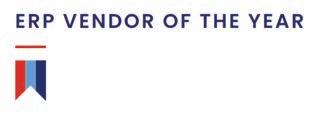
ERP VENDOR OF THE YEAR
AFTER THE OIL SPILL COMES AI TO FILL

We are way beyond the time when the phrase “data is the new oil” was a common adage in tech. Instead we are in the age of AI, generative AI and more specifically, large language models (LLMs). But behind all the ChatGPT hype remains the basic truth - AI can only be as good as the data it has to operate on. For AI to succeed it needs data and computation, both to train and execute AI models. So let’s look into this dynamic and the reasons why CxOs need to now have Data-as-a-Service (DaaS) rolling off their tongues.
BY HOLGER MUELLER
132 ERP TODAY | UK / EMEA | Q3 2023
IN THE GAPS FOR ENTERPRISES

visit us ERP.TODAY 133
Data, data, data…
Enterprises possess oil tankers of relevant data in the age of AI, so they are off to a good start. Let’s look at the different kinds of data that are relevant for AI, where they sit and how to leverage them.

Structured dataERP, CRM, SRM, SCM
Unstructured dataEmail, documents, social
Machine dataLog files from anything digital
IoT dataAnything from the Things
Government dataSpreadsheet, ASCII files, EDI, manual
Benchmark dataSpreadsheet, ASCII, data import
Third party dataASCII, EDI, data import
Data-as-a-Service use cases
For CxOs to leverage DaaS, there needs to be a new approach to the enterprise data platform. This is because conventional data architectures have unfortunately not been able to facilitate the successful operation of DaaS use cases (see Figure Two).
FIG 2 FIG 1
CxOs must ensure their DaaS architecture approach begins with an inherent understanding that there is no finite estimate of the volume of data to be stored. It is crucially important to recognize from the start that DaaS not only enables exporting and monetizing data, but also allows enterprises to license and purchase data.

For DaaS to work effectively, additional capabilities running on top of the Infinite Insights layer are a prerequisite. Prominent among these are understanding who the customers and suppliers of data are, how the data is licensed and how data can be shared and made available to the various parties involved in a
CHARACTERISTICSIMPORTANCE FOR AI
Structured, high quality, Crucial slow growth
Unstructured, questionable quality, medium growth
Structured, high quality, fast growth
Very important
Important
Structured, high quality, fast growth Important
Structured, high quality, slow growth Relevant
Structured, high quality, slow growth Relevant
Structured and unstructured, questionable quality, high growth
Very important
DaaS scenario. A strong monetization offering, with an understanding of the licensing and consumption of the underlying data, may be required as well.
As data becomes a strategic asset in a digital economy, the platforms for managing data also become strategic. When building a DaaS platform, the define-and-design approach should
follow these architectural components (see Figure 3):
• The virtual data layer is the uber data management component. Although there are ambitions for the universal data lake, such a lake will never encompass all relevant data for the DaaS automation needs of an enterprise. There are just too many potential and relevant data sources to import and integrate all of them into a data lake, and too many potential delays in doing so - especially when those delays lead to delivery time lags and possible business penalties. Therefore, every DaaS architecture should have a federation of data, ideally through a virtual data layer, that is powered by an elastic data mesh.
• Services and APIs are the exposure aspect of the platform. Direct access to data is always problematic as too many things can go wrong (data theft, performance issues and more). Instead, a modern DaaS platform allows access to data
DIGITAL
ARTIFACTS DIGITAL
134 ERP TODAY | UK / EMEA | Q3 2023 | EXPERT OPINION | DAAS
EXHAUST Documents Email Chats ... ERP CRM HCM ... Logs IoT Social DaaS Partners The DaaS Platform
Source: Constellation Research, Inc & HMCC DaaS Platform
The
Data type and characteristics
DATA TYPEWHERE IT LIVES
via API-enabled service layers that take care of access rights and privileges, log usage and consumption and security.
• Data security is an inherent platform characteristic. Security needs to be “baked” into a modern DaaS platform. The potential risks of data breach, data theft and other malicious data operations are too high for any enterprise to not have a built-in security layer as part of its DaaS platform.
• Consumers use only APIs to access data. DaaS consumers access data via APIs only, ensuring better policy adherence with respect to data access, usage and operation. A key success factor for DaaS platforms is the ability to provision and monitor these APIs.
in compliance with contractual and regulatory agreements.
• Benchmarking. To benchmark performance in different areas of the enterprise, IT leaders require a platform that allows them to put in place agreements with benchmarking partners and to mask and neutralize data as specified in the benchmarking contracts, facilitating the continuous export/import of data. DaaS is the platform to power benchmarking for enterprises that have so far been able to look only at their inhouse data.
• Customer data hub. Customer data is one of the most valuable assets of an enterprise, yet it’s highly fragmented and often is enriched with third-party data. With an effective customer data
also to continuously inject third-party data into their own data. On the other hand, by documenting second and thirdparty demand for their own data, a DaaSpowered data marketplace can help organizations discover what value their internal data may have, if monetized.
• Data science. Data scientists cannot rely only on in-house data as the base for their artificial intelligence/machine learning models but also need access to other data they can use to validate, cleanse and enhance the existing data. DaaS platforms in combination with data marketplaces are key enablers for data scientists.
• Fraud. Globally, enterprises lose hundreds of billions of dollars every year due to fraud. DaaS can help IT leaders bring in a far better capability for flag -
DATA IS CRITICAL FOR AI, AND DaaS IS THE MODERN WAY TO MANAGE DATA
DaaS verticals
A modern DaaS platform can facilitate excellent vertical use cases. The following are among the most prominent:
• Artificial intelligence. We already highlighted how data is critical for AI, and DaaS is the modern way to manage data. As such, the DaaS foundation determines the success of an AI strategy, and that determines the potential of an enterprise to lead in the marketplace.
• Advanced analytics. Traditional analytics only looked at in-house data. A modern, advanced analytics approach makes it possible to use third-party data to enrich and validate the in-house data. DaaS is a key enabler for procuring, licensing and operating third-party data
hub enabled by a DaaS platform, IT leaders can aggregate all of the customer data within the enterprise, enrich it via third-party data licensing and satisfy regulatory requirements.
• Data brokering. Data is valuable, and enterprises may not only license and sell it but also may broker it against other data they are missing or want to enhance. Enterprises may also broker third-party data to their customers and suppliers. A DaaS platform makes this possible.
• Data marketplace. To be able to offer data at scale internally, data marketplaces are the right strategy to pursue. A data marketplace empowers enterprise users to not only understand what data they may need to acquire or license, but
ging and reducing fraud, and for mitigating its intensity. Fraud-associated use cases will gain further momentum as enterprises embrace DaaS platforms.
• People data. Information about people is highly fragmented, highly regulated and often beyond the control of a single enterprise. When enterprises want to validate employment history or work references, they either need to work in a cumbersome manual fashion, or they can use a DaaS platform to gain better transparency into people data.
The takeaways
Enterprises cannot afford to not have an AI strategy in 2023. And while there may still be some time to implement AI correctly, its success will stand - and fall - with data.
Fixing and creating anything related to data is always a lengthy process. So it is crucial for enterprises to start looking at their data platforms now, as fixing them when the competition is making life hard with the power of AI might take too long and may well be too late for an enterprise to stay in business.
As in any case when moving and fixing something in IT, it is well worth it to look for the latest thing, in this case DaaS, to help manage an enterprise’s data platform. In other words, it’s no time to be wet behind the ears when it comes to data.

visit us ERP.TODAY 135
Source: Constellation Research, Inc & HMCC Data mesh Users Customers Partners Suppliers Virtual Data Layer API Management Operational Data External Data Data Warehouses ... Logical Architecture of a DaaS Platform FIG 3 CatchingSecurityMonitoring...
CLOUDY VISION BEGONE?
HOW TO CLARIFY OUR VIEW OF SAAS IN THE NAME OF SECURITY

136 ERP TODAY | UK / EMEA | Q3 2023

137
ADRIAN BRIDGWATER
What the early cloud-focused engineers didn’t perhaps take into account was that, while real-world clouds are generally opaque, perhaps through some form of serendipitous prescience, the opaqueness of computing clouds is what much of the SaaS sector is now working hardest to combat.
A murky mass of cloud instances is not good for business. Instead, we want cloud clarity, cloud visibility and cloud observability if we want to be able to secure our virtualized compute and data services. The questions we have to ask are why is this such a challenge, what aspects of cloud datacenter operations are so hard to see, and how do we clear the air in general?
“As organizations continue their cloud adoption journeys at pace, the challenge of observability grows in line with the scale and complexity of the new architectures, infrastructure and platform components that today’s applications demand,” explains Christian Reilly, EMEA field CTO for infrastructure automation specialist at HashiCorp

Reilly says that in “traditional” onpremise deployments, the IT team’s focus was primarily on monitoring a relatively simple collection of underlying technologies and the monolithic applications that ran on top. Monitoring in this scenario is worthy enough, but it is based on a set of pre-known conditions, or thresholds, that trigger alerts when these thresholds are reached or exceeded.
Needle in a cloud-stack
“Cloud-based environments, in which applications or other services are deployed across multiple cloud providers, pose an entirely different challenge,” heeds Reilly. “Microservices, modular ephemeral infrastructures and dynamic components in modern cloud environments, often increasingly abstracted from the physical infrastructure on which they ultimately run, provide the archetypal ‘needle in a haystack’ conundrum when operations teams are faced with finding and fixing the sources of failures or performance issues.”
Pointing to the growth of DevOps and what many in the industry are now calling platform engineering, the HashiCorp team highlights just how fundamental cloud observability has become in
138 ERP TODAY | UK / EMEA | Q3 2023 | EXPERT OPINION | SAAS SECURITY
CLOUD COMPUTING is generally agreed to have been so-named after the swirly bubbles that software architects used to draw to explain where pools of system resources were located in a network. While some also suggest that the term “cloud” was simply cooked up by sales strategists looking for a new label to put on managed service provision, the term was popularized and quickly moved from de facto to de rigueur in the global lexicon of information technology terms.
BY
the context of site reliability engineering (SRE). Reilly is firm on where observability now goes beyond “basic” monitoring and says that it demands instrumenting all components within an application stack. He notes that this approach helps quickly discover patterns in modern distributed systems. Observability in this context gives deeper insights into what’s happening and what may fail before the impact is felt by end users.
As we attempt to “see” into the opaqueness of cloud and understand the shape, structure and state of the SaaS services that we ourselves have built, we come back to the question of why we’re concerned about the inner state of cloud in the first place - and that’s a question of security.
At the heart of it all, the foundation for risk in any cloud deployment lies within the software application code itself. The quality and security of code, regardless of its position in the technology stack, help dictate the strength of an organization’s application security posture. By prioritizing robust and secure coding practices, organizations can fortify defenses and safeguard systems while helping reduce the risk of compromise. This is the opinion of Ben Denkers, chief services officer at Qwiet AI
“In modern cloud environments - if not also elsewhere - application security initiatives must be comprehensive and wide-ranging, covering multiple layers of the system. In the virtualized arena of the cloud, risks exist at various levels, including APIs with the potential to expose business logic flaws, at the applica-
tion and database layer with the specter of occurrences such as SQL [structured query language] injection attacks… and even the underlying infrastructure that an application leverages, all of which can be potentially exploited,” advises Denkers.


Strategic tools
The Qwiet AI team say that they have seen many different application security programs carried out over the years. The best of these strategies typically encompasses activities such as threat modeling, static code analysis, developer training, risk assessments and validating controls through penetration testing and other assessments.
“Ideally, organizations should address security issues during system planning stages, before developing or deploying the application to production environments. It is crucial to review every layer of the application to prevent misconfigurations, poor development practices and the usage of vulnerable libraries or
other elements that could lead to compromises,” notes Denkers, reiterating some time-worn advice that still needs to be openly highlighted almost a quarter century into the new millennium. We also know that Infrastructure as Code (IaC) plays a significant role as well in modern cloud environments. The CSO highlights the numerous tools available that enable the secure definition and deployment of infrastructure resources in line with IaC methodologies. However, notes Denkers, validation of these toolset functions is always necessary, as organizations may mistakenly believe they are following best practices without actually doing so.
“We find this lack of validation is the case more often than not,” he warns. “Regular audits and validation of security practices are essential for promptly identifying and addressing security gaps if a business wants to achieve true cloud visibility and observability.”
It seems clear that organizations need to adopt a comprehensive cloud observability security strategy that dovetails tightly with the overall security posture of the company. Only in this way can firms hope to get a view into the various layers and components of their applications, data and services stacks. But it is perhaps that essential middle tier - data - that may get overlooked in the wider rush to observe and monitor the inner columns of air spiraling up through any given cloud.
Subbiah Sundaram, SVP of products at hybrid cloud uptime company HYCU concurs with this sentiment. He agrees
visit us ERP.TODAY 139
IN THE VIRTUALIZED ARENA OF THE CLOUD, RISKS EXIST AT VARIOUS LEVELS
BEN DENKERS / QWIET AI
MICROSERVICES PROVIDE THE ARCHETYPAL “NEEDLE IN A HAYSTACK” CONUNDRUM
CHRISTIAN REILLY / HASHICORP
that most organizations developing cloud applications spend a lot of time thinking about securing access to the application and making sure the enduser security is done very, very well.
“A big part which is sometimes overlooked, is around data resilience. But when we talk about data resilience in this context, we are talking about how to make sure it’s protected against internal malicious users, as well as external bad actors,” warns Sundaram.
Remember the olden cloud days?
But hang on a minute - in the era of new-age cloud, wasn’t everything supposed to be easier, service-based and essentially more controllable? Sundaram clarifies the challenge at hand by explaining that contemporary cloud applications make use of different ser-
vices available in the public cloud. But he notes, to make these modern applications visible, observable and resilient, it is not like in the “olden cloud days” where we would just concern ourselves with protecting one (or a few) virtual machines.
“Today, organizations have to protect the configuration for each of their public cloud services and the data in each of these services. As we all know, each of the public cloud service providers offers hundreds of services, and there is no easy way to protect the breadth of these services and the total scope of data in a unified fashion,” says Sundaram.

That is the challenge many are trying to overcome in today’s modern and public cloud IT environment. In the ongoing quest for clear and present vision into cloud status and security, many or-

ganizations are adopting a DevSecOps approach to Agile code development. This sees them build best practice security approaches to development early in lifecycles, as well as stringent orchestrated code security testing as part of the route to running a “live” change management process.
So as “delicate” as cloud computing clouds clearly are, perhaps we should be starting with the users who interact with them to examine who is driving which cloud service in which direction. Kyndryl UKI security and resiliency practice leader Duncan Bradley draws special attention to this aspect of network management and says that it is a key element of cloud application development security which is often missed.
“In the realm of operational cloud, user access - and especially privileged user access - is often overlooked,” clarifies Bradley. “This tends to be seen as another challenge or responsibility that should fall to the infrastructure team. Consequently, it is often not given consideration as part of the cloud application development lifecycle and the ongoing need to be able to look into cloud performance with clarity.
“Gaining a deeper understanding of how to restrict user’s access to data, especially to sensitive data, can have a dramatic effect in reducing an organization’s attack surface, especially if you can significantly reduce the sensitive data exposed, only to those that need it, by securing it outside the shared platforms.”
140 ERP TODAY | UK / EMEA | Q3 2023
| EXPERT OPINION | SAAS SECURITY
DATA RESILIENCE : HOW TO MAKE SURE IT’S PROTECTED AGAINST INTERNAL MALICIOUS USERS AND EXTERNAL BAD ACTORS
SUBBIAH SUNDARAM/ HYCU
Bradley recommends extending the notion of DevSecOps to DevSecRecOps, with the “Rec” element referring to data and system recoverability built into design lifecycles. Because we know that cyber breaches are now “when” and not “if” events - with many of these attacks having data corruption or encryption payloads which result in the need for mass data recovery - being able to recover critical business systems from backup quickly is now being seen as high priority to many organizations.
Business impact tolerance windows
“With various global industry regulators now mandating [that] critical business systems must be recovered within defined business impact tolerances, the ability to recover critical application platforms within business impact tolerance windows cannot be viewed solely as an infrastructure support team problem,” concludes Bradley.


Is cloud getting clearer to look at then? Given the ever-greater complexities in the cloud-native application landscape, the connected market for information with data exchange technologies now burgeoning across the cloud, and the increasingly complex cloud topographies now being built as a result of componentized containerization, it almost feels like cloud is getting cloudier.
“As organizations have transitioned to the cloud, even mission-critical applications are often running across complex, hybrid technology stacks. Alongside

USER ACCESS IS OFTEN OVERLOOKED
DUNCAN BRADLEY / KYNDRYL
this trend, the growth of Agile delivery practices and use of open-source code libraries is enabling teams to push updates to these applications faster.
“Whilst these approaches accelerate innovation, they also heighten security risk. They create more opportunities for vulnerable code to enter production and make it more difficult to quickly identify indicators of compromise given the dynamic and highly distributed nature of modern applications,” says Andreas Kroier, senior principal and application security solutions lead at Dynatrace.
Kroier suggests that this has led to a growing need to converge observability and security, and to unlock the insights needed to detect code vulnerabilities continuously and enable rapid remediation. By combining observability and security, the suggestion here is that teams can access real-time insights into vulnerabilities and get a precise understanding of how they could compromise the application.
Many say that this is invaluable in
terms of helping teams to eliminate time spent chasing false positives and avoid focusing on code vulnerabilities that pose a minimal risk - for example, those that are not exposed to public networks or could not be exploited to access sensitive data.
“Observability also helps improve security response efforts through the ability to baseline application performance,” emphasizes Kroier. “This enables teams to instantly identify workloads that deviate from normal behavior, helping to detect and block some of the most common threats, such as SQL and command injections. The ability to combine observability context with security events also provides another vital source of insights.”
Because cloud computing has become more powerful, it has also become more complex. As cloud observability has become more complex, it has needed to match this complexity by becoming more powerful in the face of more complex and powerful security concerns. Because the scope and breadth of data itself has become vaster and more intrinsically connected, our cloud data services have also had to match the wider tide that is driving the multi-helix strands of DNA now building the modern cloud.
What we need to consider going forward are the forces of virtualized and abstracted nature now building the cloud ecosystem to ensure one element is always matched by an equal and opposite gravitational force. If we can do this, then we can bring the clouds down to earth, or at least keep them lashed down and under control. Still, best take a coat and flashlight.
visit us ERP.TODAY 141
THERE ARE MORE OPPORTUNITIES FOR VULNERABLE CODE TO ENTER PRODUCTION
ANDREAS KROIER / DYNATRACE
COMPARING ERP APPLES AND ORANGES THE CONSULTANT VS


One of the biggest decisions organizations face with an ERP implementation is choosing between a consultant or hiring a contractor for the project - here we weigh up the pros and cons of both.

 BY CHRISTINE HORTON
BY CHRISTINE HORTON
142 ERP TODAY | UK / EMEA | Q3 2023
CONTRACTOR DEBATE

By now we know that transforming enterprise-wide software and systems means many variables to consider. ERP implementations can be complex and, without expert insights, there is potential for business risks in the form of wasted investment, delays or even failure.
One of the biggest decisions faced from the outset is choosing between partnering with a consultant or hiring a contractor for the job. Just this decision alone can play a major role in the success of an ERP implementation.
So here we weigh up the pros and cons of both in the consultant versus contractor debate - and in reality, the case for using contractors versus consultants for your ERP implementation may not be as clear-cut as you might imagine.

One of these things is not like the other So, before eyeing up your options, let’s establish the difference between a consultant and a contractor and why it’s important to distinguish them.
Put simply, a consultant provides professional and expert advice to busi-

nesses that lack the required in-house knowledge and expertise for a specific project. The service provided is usually linked to a defined outcome with agreed milestones or deliverables and the supervision of the people involved is the responsibility of the consultancy business (or shared with the client).
Contractors, meanwhile, are employed by a business to perform a given task or project. The contractor is under the client’s direct supervision. As a result, the client is responsible for managing the contractor’s work risks, including quality assurance, timeliness
visit us ERP.TODAY 143
of delivery and general performance management.
Clients will generally pay for a set amount of time from their contractorusually six to nine months on one project. But while considered temporary workers, contractors can often come to be viewed as employees within the organization and, in the UK for instance, operate within the IR35 tax scheme.
“A consultant is often used interchangeably to mean the same thing as a contractor, and contractors vary from those that provide their skills and those that deliver pre-agreed services,” explains
discrete that needs either an external view or skills or capabilities that you do not possess internally. If it can be done by an individual, then you could equally choose a contractor,” he says.
Ingram maintains that consultants are hired when businesses want to assign responsibility or accountability to a third party for a piece of work.
“It is difficult to pass that responsibility to an individual contractor,” he continues. “Consultants usually bring methodology and standardized deliverables, managed within a clear quality framework - you would never expect that from a contractor.”
However, he notes that contractors will usually bring vast experience from many assignments - which means they can offer suggestions as to how others have solved the problem. “Individual
So, where the desired deliverable can be tightly specified and the solution tested for compliance to spec, then contractors will provide the lowest cost solution for the business.”
Getting their teeth into a project
Higgins also points out that contractors often bring fresh perspectives to a project. As external resources, they may introduce new ideas, methodologies or approaches that the internal team may not have considered. Their diverse experiences working with different organizations and industries can help identify opportunities for improvement and innovation, leading to enhanced outcomes and solutions.
But there is, of course, a counterargument: “Consultancies, being dedicated to the project’s success, are more likely
Dave Chaplin, a former IT contractor and now CEO of contracting authority ContractorCalculator.
In defining the key difference between consultants and contractors, Chaplin says: “The central question is whether the hirer wants to hire a skilled person they chose for a fixed period of time, who is then allocated work and controlled and supervised - namely a contract ‘of service’. Or does the hirer want an outcome-based contract, which is a contract ‘for services’, where the deliverables are contractually agreed up front, and the hirer is agnostic about who delivers those services, provided the work is completed?”
What are you looking for?
Steve Ingram, Deloitte’s director of SAP Solutions and head of KIT, sums it up: whether you choose a contractor, or a consultant depends on the work needed and skills required.
“Hire consultants for pieces of work that require a team to deliver something

consultants rarely have that experience, but their firm provides a network where they can find it,” he says.
Sorting the sweet from the sour
Moreover, Stuart Higgins, partner at management and tech consultancy, BearingPoint, believes there is a role for both parties in any ERP implementation.
“Contractors typically have deep knowledge and understanding of specific ERP solutions. They tend to specialize in, for example, SAP or IFS , and might be best deployed in configuration or in writing bespoke code based upon, for example, ABAP skills. However, contractors do not tend to be focused on optimized business outcomes, only on delivering their particular assignment to specification. They also tend not to have an up-to-date perspective on the latest developments within the major ERP providers, as they simply do not have the depth of relationship with the providers and their development pipeline that major consultancy partners have.
to prioritize the organization’s interests than contractors. Contractors may have conflicting interests, in particular because their self-employed status can mean they are naturally motivated to bill more hours,” says Higgins.
“Additionally, if they are simultaneously working on multiple projects or seeking additional opportunities, there can be a misalignment of interests that can lead to compromised decision-making, biased recommendations and a lack of transparency, which can negatively impact the project’s outcomes.”
Neil Davidson is group vice president at Deltek , which produces software for project-based businesses. He believes it is important to work with seasoned consultants to mitigate the risk of delays, alterations and failure, through their years of experience and expertise in change management.
“Even if the project is going off track, consultants can see the bigger picture and draw on their knowledge to develop a contingency plan that ensures the project
144 ERP TODAY | UK / EMEA | Q3 2023 | EXPERT OPINION | ERP IMPLEMENTATION
Contractors often bring fresh perspectives to a project. As external resources, they may introduce new ideas, methodologies or approaches
gets back on the right journey,” he says.
“Independent consultants can look at a project objectively, without biases skewing them towards one particular ERP system - so you know their advice is impartial. This means consultants will be able to assist in the evaluation of different systems and work with you on identifying the best fit for your business. They can help to align internal incentives and with expertise in managing major projects, can provide guidance on areas that require complex discussions such as data management, change management and operating models.”
Green or brownfield ERP implementations make a difference
Elsewhere, Mark Thomas, group corporate sales director at Ellis Recruitment
“[On the other hand] end-users maintaining or upgrading an existing ERP ‘BAU or brownfield’ will most likely be less reliant on an SI having lived with the ERP over a period and built an internal skill competency. In this scenario, we tend to see this type of end-user relying more on contractors supplied via trusted agencies to manage the peaks and troughs of ongoing project requirements.
“The use of contractors in this scenario is absolutely the right thing when you consider the competitive day rate cost of a contractor compared to the day rate cost of an SI’s consultant (when sold separately), which is typically between 30–60 percent cheaper and coupled with the specialist nature of contractors versus the wider (and less specialist) skills of an SI’s consultant.”
more cost-effective over the duration of a project as you only pay for the days you need. There is minimal downtime as an agreed amount of time will be negotiated before the beginning of any given project. This allows them to work the hours required by the client in order to meet their deadlines. And with a consultancy you can offboard your team and reboard when ready.”
Harrison also says hiring contractors can result in varied quality, especially when they don’t follow the same methodology. “This results in the outputs not being consistent. Consultants, meanwhile, follow the same methodology and templates so all outputs produced look the same. This can be the difference between getting the project done well and just getting the project done.”
Group says that as a recruiter, it’s natural to rain praise on the contractor. “But in truth, it would be disingenuous to claim that either was more valued than the other,” he says.
Thomas says that end-users implementing new ERP “greenfield sites” are heavily SI-dependent, having most likely been introduced via the ERP software vendor and completing pre-implementation activity with that SI. They will most likely have little internal competency and will need to rely heavily on their SI’s bench of skilled consultants to get the product implemented and live. Those consultants will usually be fixed, costwise into the overall project budgets and often deployed at the discretion of the SI based on the project plan.
However, he says: “In this scenario, contractors should not be overlooked, and many results-focused SIs will introduce a trusted agency that can provide the contractors with project management, change management and data migration, among other things.
A misconception that contractors are cheaper?
Indeed, one of the biggest barriers to organizations using consultants is cost - especially in the current economic climate, when the consultancy fee could be perceived as too high for some businesses. This is because, as Thomas notes, consultants’ day rates are usually higher than looking to engage a contractor for a period of time.
But it’s not as simple as that, argues Joanne Harrison, sales director at ERP training consultancy Optimum. She says it’s a misconception that contractors will be cheaper than using consultants if you look beyond the initial day rates, as there are hidden costs that can come with hiring a contractor.
“Contractors usually demand a 6-12 month contract, so are less flexible. ERP projects are always subject to change and timelines frequently shift, and there is often downtime when the system isn’t ready,” she says.
“Here, a consultancy is likely to be

Room for both? Of course there is Davidson maintains that to get the most from your investment, it’s important to give consultants a diligent briefing beforehand so they can see the full picture, as they may not be familiar with the specific challenges and requirements of your business.
“It’s essential to be aligned with the consultant when you’re in those early conversations, that way you’ll have someone who fully understands the company’s specific needs and can provide measurable project progress to necessary stakeholders.”
With both sides weighing in on the contractors versus consultants debate, there are pros and cons tied to each. But clearly, there is room for both within the ERP landscape, so take your pick.
visit us ERP.TODAY 145
With a consultancy, you can o board your team and reboard when ready

















148 ERP TODAY | UK / EMEA | Q3 2023
THE
FOR
AN UPDATE ON THE AI RACE AS CHATGPT SPEEDS AHEAD.
 BY HOLGER MUELLER
BY HOLGER MUELLER
redit goes to Microsoft through its partner/ownership relationship with OpenAI which has made AI a widely talked about topic. The result is that AI is now tangible as everybody with a smartphone could practically test out OpenAI’s natural language powered LLM, making LLMs part of our common parlance. While the euphoria has ebbed a little bit, solid first-generation use cases of AI are being delivered to enterprises. With that, AI has derailed a lot of product roadmaps and development plans as the whole industry has had to react on the fly, not only on a platform (PaaS) level but also on the application level (SaaS).
It’s not about the language. It’s about the knowledge, stupid Humans like to make technology human, anthropomorphizing it, and the same has happened with LLMs. LLMs are not really large language models as such, but large knowledge models. But that would lead us to possibly challenging and concerning discussions on what knowledge is being used, where does it come from etc. But whenever you see LLM, instead picture LKM - a large knowledge model.
And while we are at it: do not ask about the data. Data can be misleading and wrong. The question needs to be - what knowledge can be extracted from the data, and what knowledge gets fed to the LKM, as accessed through natural language? The quality of that knowledge is what is key for the success of generative AI.
And so, Microsoft poked Google
In what likely will become one of the technology industry’s biggest strategy moves, Microsoft managed to make Google afraid of its own innovation. Through lobbying with legislators in North America and Europe, using a small army of ethical and legal experts, Microsoft did something that is rare in its technology: it managed to stall a market leader through legislative/statutory and PR lobbying. Suddenly, Google was afraid of its own progress - so afraid that Google let go of one of its AI leaders in the summer of 2022, when he stated that Google AI had become sentient.
Fast forward to spring of 2023 - and Alphabet CEO Sundar Pichai shares freely that somehow, on its own, Google AI algorithms picked up a language to its translation fold, Bengali, without ever being asked to. If that is sentience, I’ll leave it up to you to decide.
For enterprise, these strategies are in-
GOOGLE WAS SO AFRAID OF ITS OWN PROGRESS THAT IT LET GO OF ONE OF ITS AI LEADERS WHEN HE STATED THAT GOOGLE AI HAD BECOME SENTIENT
teresting to understand, but do not matter too much. What matters is that there is tremendous AI competition now, and competition means innovation and lower costs, all critical for enterprises that need any piece of automation they can get.
Handicapping the key AI cloud vendors
In last year’s article I used three criteria to rate the cloud vendors. This year, reflecting on the importance of generative AI, I’m adding a fourth one - the ability to create LLMs on an AI supercomputer. This ability matters as the availability of the supercomputer to build LLMs is critical and creates gravity for all other cloud services, which have to move closer to the orbit of that supercomputer.
For cloud vendors to be successful with AI, their offerings need the following key technical capabilities:
1. Data capability supporting AI strategy.
2. Efficient compute hardware to train and operate AI models.
3. An AI platform allowing efficient creation of AI applications.
4. The ability to create LLMs on “AI supercomputers” (new!)
Now, let’s look at the top five cloud players in the race for the AI prize (in alphabetical order):
Amazon is playing with fire
AI remains the only area where AWS has fumbled across the whole portfolio; indeed, in a recent interview with an AWS exec, ERP Today was told questions about ChatGPT weren’t allowed. And while AWS has reacted by building
150 ERP TODAY | UK / EMEA | Q3 2023 | EXPERT OPINION | AI
I previously looked at the state of the AI race about a year ago - and as you can imagine, a lot has changed with AI since then due to the rise of ChatGPT.
its own custom chips, it is only in the second phase of the journey. What we see is a lot of unifying activity e.g. with Amazon Bedrock or AWS AppFabric, and both offerings have hit a nerve. But AWS has still not unveiled a supercomputer to compete with Google, Microsoft, even Oracle
The crux may be that Amazon as a retailer does not need them, and the CAPEX needed to build an AI supercomputer (north to $100m) may not be in Amazon/AWS’s investment plans. The risk is that gravity of automation may shift to other cloud vendors. At the end, AWS’s number one position in cloud may become embattled - even lost.
Google took a jab, but is back on its feet, swinging
As said earlier, Google was afraid at some point of its own progress and to some point held at ransom by its own employees (see the voluntary opt-out of the U.S. Department of Defense JEDI project). All that is history now as it’s all hands on deck and Google is now back and largely ahead on the topic of generative AI. While Microsoft is working hard to make its version of ChatGPT be up to speed for English language data (fair enough the largest body of data out there) Google is building twenty languages, and just casually mentioned the general availability of Japanese and Korean at Google I/O in May.
Google has also caught up at infusing generative AI across its suite; its AI Builder product is easy to use and well adopted in enterprises. Generative AI may be the inflection point that propels Google Cloud beyond the number three position in cloud overall.
Microsoft shows remarkable vendor-wide discipline to embed AI everywhere
A year ago, I wrote that the lack of custom silicon makes all AI at Microsoft questionable from a commercial and architectural elasticity perspective. We now know the answer, as Microsoft
AWS’S NUMBER ONE POSITION IN CLOUD MAY BECOME EMBATTLED - EVEN LOST. CONSIDER THAT NVIDIA USES ORACLE CLOUD TO RUN ITS AI
has both folded internal hardware and software plans, using Nvidia and OpenAI. It does not come cheap to be late - a $10bn+ investment into OpenAI, a $100m+ Nvidia-powered supercomputer - and many more of these are needed.
But as said before, Microsoft deserves praise for turbocharging AI in 2023, and clearly Satya Nadella enjoyed poking Google in the eye (as did the press). For a technology vendor that used to operate in fiefdoms, the generative AI adoption across Microsoft has been more than impressive. Microsoft product capabilities have never been aligned around a single technology, so that worked out very well indeed.
Nvidia went from wild card to Switzerland
In the last 12 months Nvidia has been able to put its chips into any public cloud of any relevance, most prominently all vendors under our focus. They may have missed building custom silicon (AWS was late, for example) or not listened to customers (Google Cloud) - but all large clouds covered here are using Nvidia chips, making the vendor a stock market darling.
The core value proposition for Nvidia and its attraction is that its AI models are portable - not only across the clouds but also back on premises. That said, only if one can afford the necessary hardware. The entry level DGX platform sells for more than $40k. If anything matters in how an industry insider decides on which cloud to run its own generative AI, consider that Nvidia uses Oracle Cloud to run its artificial intelligence.
Oracle is in the game - turns out DB clouds are also good AI clouds
Oracle has focused on making its
cloud work well for its most organic workload - its database. It turns out that when you build a great cloud for databases, it is also a great cloud for AI. Fine-tuning a cloud architecture to keep the expensive chips crunching data, through a fast network that is connected to faster storage, is a common design point. And so is being able to configure computer and storage pods that are connected by intelligent and fast networking.
All that makes Oracle Cloud a great cloud for AI - all it needs are chips and Oracle is buying them for “billions”. A look at Oracle’s Q4 shows that Oracle is investing more than 50 percent of available cash flow in CAPEX, showing how expensive the move to AI is - and how much Oracle leadership believes in the power of AI to transform the cloud space.
The takeaways
CxOs must understand the core differences between major cloud and AI platform players. Factor in also the organizational DNA of each vendor and chart the trajectory of their AI offerings. Using this as a lens for comparison, Google is keeping its AI crown, despite the good scare it got from Microsoft. Oracle enjoys benefits of its cloud architecture for AI workloads and will do well. Microsoft needs to build on its early successand it has big shoes to fill. AWS needs to make careful investment decisions, but also needs one (and more) AI supercomputer(s) in the second half of 2023. Nvidia offers portability and is the portability choice for AI workloads.
All vendors bring distinctive value propositions to enterprises - choose wisely or find yourself obsolete in the age of AI!
visit us ERP.TODAY 151
HUG!
I’ve long been a fan of user groups. I think it’s important that end users have a collective voice heard by their ERP vendors, and when I read on LinkedIn that the UK & Ireland SAP User Group (UKISUG) won Best UK Conference at the Global Conference Network ’s Conference & Events Awards, it was a sign that there was a story for me to tell in ERP Today.
I first got involved in user groups 22 years ago when I was asked to stand as a volunteer for UK Oracle User Group (UKOUG) and join their board. I continued in various volunteer and board roles including president until 2018; currently I’m on the board of the global Oracle Development and Technology User Group (ODTUG).

on a three or four-day user conference. Often the conference also needs to make a surplus to fund the user group for the rest of the year. Financially, therefore, partners are crucial.
Bygone days
I love the independent user group model which means that they are not answerable to the vendor. But that comes with its own challenges: how do you fund the community and how do you make it valuable? In my early user group days, we had no social media, online content was mainly text, there were very few webcasts and partners needed these conferences to reach potential customers.
BY DEBRA LILLEY
The highlight of a user group year is the annual conference. This, like an awards event, is a chance to bring the community together, network and learn from each other, to inspire ideas to go back to your organization with to improve your ERP use. Also like many award bashes, these conferences are mainly funded by partners as exhibitors and sponsors. There is typically a charge for users to attend, either via membership fees or direct, but on their own that does not generate enough revenue to put
As such, user groups were the best place for the ecosystem to come together around great educational content from user organizations and experts in the ecosystem, and an exhibition where those partners could showcase their value to the user community. This was the main way those vendors could get their story out in the marketplace, and for the first few years all exhibition space was sold for the next conference before the existing conference was over.
A few years later there was a major shift in ERP as vendors increased acquisitions. This meant more users, more stakeholder groups
THE HISTORY AND HEREAFTER
152 ERP TODAY | UK / EMEA | Q3 2023
| GUEST CONTRIBUTOR | USER GROUPS
OF USER GROUPS




















































































































































































































































































































































































































































































DEBRA LILLEY, INOAPPS VP, TALKS ON THE VERY IMPORTANT ROLE OF USER GROUPS IN ERP

visit us ERP.TODAY 153
and less partners as many became involved with multiple vendors. At the same time, technology brought digital disruption, not just to organizations, but also user groups. Now they were in competition with many other platforms for a partner’s marketing budget. Throw in a global economic climate that caused organizations to tighten their belts, halt education spend and not allow their people to attend in person events.
Thereafter, applications started to move towards cloud, which meant a business model change for many partners, and roles changing at end user organizations. All this added up to major challenges for user groups, who in general saw drops in numbers for their annual conferences. In turn that affected partner ROI on their spend, as partners began questioning if they were getting the value they needed.
These challenges are not limited to the UK. At the time of writing I had just returned from the last of three user group conferences in the US, including KSCOPE, ODTUG’s annual conference. This conference had been incredibly successful despite the challenges of COVID which decimated events for at least two years. The numbers had grown since last year, but like all other groups have a longer trend of constricting membership.
UKISUG: bucking the trend?





























































































To understand what led UKISUG to winning big at the Conference & Events Awards and if they were bucking this trend, I spoke to Craig Dale, CEO and asked him about his user group get-together. The make-up was very similar to the conferences I attend, with plenty of networking, educational sessions from both end users and experts in the field and social events, with a great party vibe to boot. His event is growing slowly and COVID hadn’t really affected that. Yes, they had had to cancel during the first year of the pandemic, and ran a mini-conference the year after, but the group has come back as strong as before, if not stronger. So, what is different about UKISUG, and what could others learn from Dale’s efforts?
As I talked with Craig, we discussed what they do between conferences alongside UKISUG’s special interest groups and how those communities support each other. They have online areas to ask each other questions away from the vendor, with online meetings or meetups where they could discuss things that were affecting everybody in their community. These are volunteer-led.
They also have educational sessions including those that are certified for continuing professional development (CPD) throughout the year. As such, the conference was more like a coming together of the community for a celebration of the year rather than the only thing that was happening. This means the


UKISUG model is about putting the community first rather than the conference, and I wonder if some other user groups have lost their way and are now more conference organizations than actual communities.

As I reflected on this, I thought about the APEX community within ODTUG. At our recent conference they had a session where the community discussed the toprated enhancement requests with Oracle Product Development. This level of discussion and feedback does not happen online, and the members felt they were part of the APEX platform’s future. The vendor also got back far more intelligence there than they would have done from a simple online request.
We also shouldn’t forget the vendor in all this. I also talked with Richard Pepper, current president of UKOUG for this article, and he felt that UKOUG is now much leaner and working harder to serve their membership with real support from Oracle UK. That support from the vendor is imperative. User groups are generally - and should be - independent, but need the vendor to recognize and listen to them.
Back to basics

So, what’s my takeaway for you? Let’s go back to the basics: ensure the communities are active, covering an area where they can make a difference, where they can talk to a listening vendor throughout the year.
Partners should get involved in those communities relevant to them. You may not be invited to every meetup or online meeting, but if you’ve got something to share then reach out and offer. You can provide webinars which may need to be paid for, but through them you will reach a community and not just the organizations you have worked with in the past. This way the conference will be a place to talk individually to those organizations, capitalize on your brand recognition and also your commitment to the community. In this way the value and opportunities will be there rather than it just being “here is an event in our calendar we need to be on the show floor for”. Both UKOUG and UKISUG have their 2023 annual events in November so there is still time to get involved.
This isn’t a very scientific article; unfortunately I only had enough time to speak to a couple of user group leaders and lean on my own experience. I would have liked to have spoken to a few other user groups that are covered by ERP Today and if those user groups would like to speak to me and continue the conversation then please do reach out on LinkedIn.
154 ERP TODAY | UK / EMEA | Q3 2023 | GUEST CONTRIBUTOR | USER GROUPS
Debra Lilley is VP, Customer Success at Inoapps.
User groups are generallyand should be - independent, but need the vendor to recognize and listen to them.

SPORTS DATA
WHY I MIGHT BE THE DATA BARD OF THE EISTEDDFOD
CHRIS GABRIEL ON DATA IN SPORTS - AND NOT BEING THE WELSH JAMES HUNT OR JOHN McENROE.
BY CHRIS GABRIEL
It’s that time of the year again - the season of the quintessentially British benefit of the corporate hospitality day out at a great sporting event.
There is no better digital feeling in life - apart from the annual ERP Today Awards jamboree at Ascot Racecourse, of course - than the email popping into your inbox with the offer, made with incredibly good grace and an eye to anti-bribery legislation. I’m talking about the one which asks if by any chance you could re-allocate your diary and consider attending [tick as appropriate] a day out at the cricket / tennis / golf / racing / motor racing / polo at the pleasure of XYZ.
So it was with immense support to two vendor partners that I dutifully and, indeed, rapidly accepted invitations to Wimbledon (second Monday; I am not that important) and the Goodwood Festival of Speed. As always at these events when one ponders life over a perfectly poured Pimm’s, I considered how well sports, in contrast to many
businesses, have captured the magic of data to tell stories, engage an audience, make game changing decisions and create genuine color for their audience from that monochrome of zeros and ones.
Wimbledon, for example, has long been a data-rich environment. We see it on our TV screens at home, but now everything is monitored, analyzed; decisions made from basic match stats on aces, double faults or first serves won; to more recently, player movement that provide insights into the players’ performances or potential strategy. Data from Hawkeye is now an integral part of line decisions that create moments of tension for players, fans and officials alike. We also have weather analysis, atmospheric conditions and ball movement predictions that maybe we as mere spectators do not see, but that coaches and players will pre-analyze in depth before taking to the center court.
We were lucky enough to hear from Pat Cash, an Australian legend of the game who a) turned out to be a really
156 ERP TODAY | UK / EMEA | Q3 2023
VIEWGENE / SHUTTERSTOCK

visit us ERP.TODAY 157
nice bloke and b) discussed how the game was now radically different to his day and everything had changed (the grass, the rackets, the balls) to continue to move the game forward and make it more competitive. Of course, with all of that came more data driven everything - from coaching to match strategy. Oddly enough, world class tennis players don’t just pitch up and play the game in front of them; instead they use data to plan and strategize their way to victory.
Formula 1s and 0s
At Goodwood our hosts provided insights into Formula One and the literally mind-boggling quantities of data that is now used in this “sport” to enhance the performance of car and driver, and to enhance, embellish and augment the experience of the spectator in the crowd or on the sofa.
A very smart chap at Goodwood gave us incredible insights into why data is so important during design, simulation, testing, qualifying, racing - an F1 car produces about 1.5 billion data points in a race alone.
He also informed us data was becoming key in the other side of the F1 business, being used to tell stories to all the bums on sofas, and stories within a story, that can be layered into the race and turn the experience of F1 from less of a parade to more of battles within battles within battles in every possible position on the track.
Through data, a race now becomes a Russian doll-like narrative that fans can follow and engage in, and through data the outcome of that battle can be seen - from the leaders to every single individual battle on the track. The most ardent F1 commentator could not hope to describe the complexity of a race second by second, but data can bring it to life and create a whole new set of experiences.
The same is becoming true for virtually all sports which are competing with each other for your interest, your attention and your money.
Be more sporting
Sports franchises, businesses in their own right, have leapfrogged more traditional enterprises so far in the use of data, and how they have become so conversant in telling stories through data using relationships, complexities, influence, longterm trends, real-time impact and creative or tactical decisionmaking. So what can businesses, CFOs, COOs, CIOs etc learn from sports to become better data storytellers in their own organizations to drive value to all of their stakeholders?
As your Welsh data bard of the summer Eisteddfod, I think the answer is simple.
Yes, sports use data to monitor basic KPIs (the number of
first serves, lap-times, shots on a golf course), which are the basics that many organizations are still working at with their traditional BI tools.
But - sports then realized they could use data to improve performance. Not just using it to measure things, but seeing it as a key asset used to analyze, model, predict and improve performance across every single aspect of the game. How many businesses do that today? Be honest!
And of course they now use data to enthrall the audience. Is that twelfth place car pitting going to change the course of the entire race, of the entire season even?
Yes, F1, tennis, golf and the like have huge amounts of money, access to the best talent and big sponsors, so you might think it is easy for them. It is indeed easy for them, but these franchises wouldn’t put the effort into becoming so data-powered unless it made a real difference to the success of their endeavors. They are just lucky to be glamorous enough to be the flag carriers for the cutting edge of what data can do in business.
Chat “GTP”?
The advent of large language models and AI is making storytelling through data, numerically or textually, far easier and more powerful than ever before. ChatGPT with a PDF reading add-on turns an annual report PDF into data you can ask questions of, converse with and get answers from that six months ago would have taken hours or days to read and make notes from.
The same cloud analytics and data science being deployed in amazing ways by sports franchises, teams and players is the same stuff we as businesses can access to make our business narratives rich; whether that is your finance story, your revenue prediction story, your asset story or your service operations story.
You may not be an F1 Team but think in the same way as one. Instead of using data to improve your product, make it part of your product, and see the value of data beyond measuring your past or even your present, by making it your future.
This will not be the first or last article where you will read about the use of data. But I hope it is a way you can use your summer holiday to lie back with a cool beer or G&T and think about what questions you would like to ask the data in your business. Imagine what stories you would like to tell with it to inspire others to change the tires on your business just at the right time so it can undercut the competition and get on the data podium.

158 ERP TODAY | UK / EMEA | Q3 2023 | GUEST CONTRIBUTOR | SPORTS DATA
Chris Gabriel is chief strategy officer, Sapphire Systems.
SPORTS CREATE GENUINE COLOR FOR THEIR AUDIENCE FROM THAT MOST MONOCHROME OF ZEROS AND ONES.
Process automation for Oracle Applications
Bring your in-house processes inside your Oracle Ecosystem






Configure end-to-end business processes which are fully integrated with Oracle Applications offering your workers a compelling user experience whilst driving greater self-service and automation within your organisation.
Compatible with
Spreadsheets & eForms
ERP Decentralised Processing Shared Service Centre Transactions
Customisations
SIGNING OFF
BET BIG ON DATA LITERACY FOR PUBLIC SECTOR CHALLENGES
BY CHRIS WITHEY
Budgetary constraints, staffing pressures and access to the right skills all limit governments’ ability to leverage data across teams and departments. But without accurate, data-driven insights, civil servants risk being in the dark when making key decisions.
A cultural shift on how data and technology is perceived, understood and used is fundamental to delivering better public sector outcomes. Data literacy training can help leaders and employees recognise the difference data and analytics makes to the delivery of their work. It can also nurture collaboration that breaks through organizational silos. Implemented effectively, this will enable governments to find new efficiencies and improve public services.
To deliver digital public services at scale, and with the user centricity and transparency that citizens are coming to expect, central governments can fast track technological and cultural change. This means using the right infrastructure and solutions to effectively deliver digital services, while promoting a culture that ensures data literacy across government.
Transformation through technology
To gain the full benefits of data literacy, technical limitations must also be overcome. Governments contend with aging onpremises infrastructure and data silos that hamper their ability to deliver personalized digital services. Meanwhile, customized legacy applications can be difficult to update – this leads to extra costs and resource waste, as well as potential vulnerability to cyber threats.
Moving to cloud infrastructure and “out of the box” cloud applications can address these issues head on. Cloud-based platforms help
public sector organizations increase operational efficiency, while freeing up people and technological resources. This gives teams time to securely innovate with large amounts of data, rather than focusing on maintaining existing infrastructure. Meanwhile, autonomous cloud infrastructure can improve system performance, enabling data to be leveraged at scale.
Security in the cloud
Central government institutions and departments are responsible for a nation’s most sensitive information, including data relating to defense and public safety. Governments need full control and transparency surrounding who views and uses this data.
Cloud infrastructure that is built from the ground up with security in mind gives governments visibility of their data, as well as peace of mind that it is being stored and processed safely. Depending on the specific needs of government bodies, deployment models will often strike a balance between public, hybrid and private cloud. Private cloud environments are especially well-suited to mission-critical contexts on the grounds of heightened security.
Setting new standards
By empowering collaboration across silos and using data-driven insights as the basis of decision-making, governments can set new standards in data literacy. Equally, investment in secure cloud infrastructure and solutions can safeguard sensitive data, while transforming back-office processes and service delivery. Ultimately, the result will be better outcomes for citizens.
Chris Withey is public sector lead, Oracle EMEA
160 ERP TODAY | UK / EMEA | Q3 2023
Governments contend with aging on-prem infrastructure and silos
QuiteLaterally QuiteLaterally


Wehelpallkindsofprivateandpublic sectororganisationsplananddeliver theirERPprojectssuccessfully!
www.quitelaterally.co.uk


enquiries@quitelaterally.co.uk
www.linkedin.com/company/quite-laterally







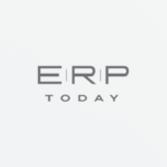












QL getintouch tofindouthowwe canhelpyourprojectsucceed 10:00 Friday,11August REMINDER ImproveyourERPproject with QuiteLaterally How can we help? Quite Laterally now
Ourexpertsworkaspartofyourteam toguideyouthroughthecomplexities, enablingyoutocontrolthepace, qualityandtimescalesofyoursystem implementation. You You AWARDS FINA LIST




























ifs.com Orchestrate your customers, people and assets with composable enterprise software from IFS. Deliver your Moment of Service™.




































































































































































































































































































































































 BY STEPHANIE BALL
BY STEPHANIE BALL




 BY YOANA CHOLTEEVA
BY YOANA CHOLTEEVA

































































 BY PAUL ESHERWOOD
BY PAUL ESHERWOOD







































 BY PAUL TAPLIN
BY PAUL TAPLIN

























 BY CHRISTINE HORTON
BY CHRISTINE HORTON





















 BY HOLGER MUELLER
BY HOLGER MUELLER


















































































































































































































































































